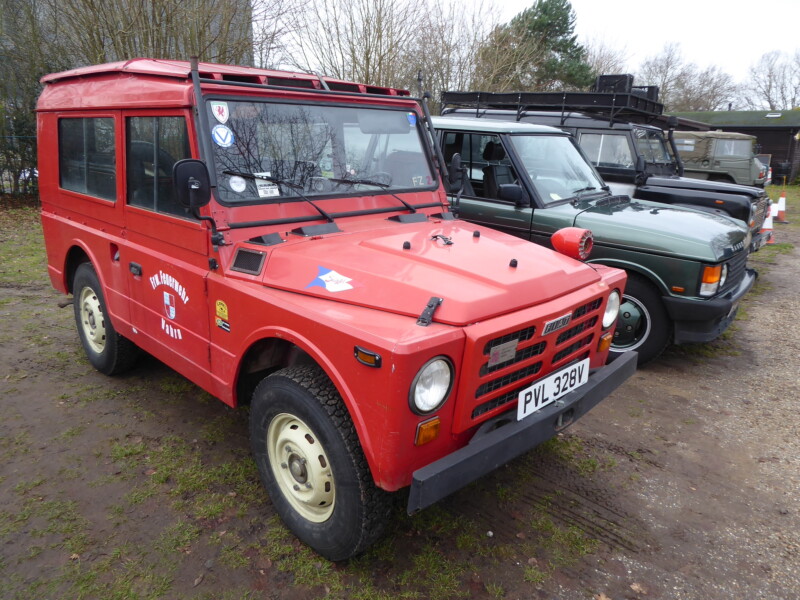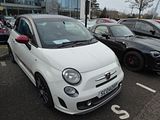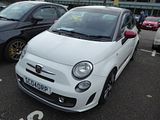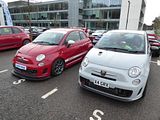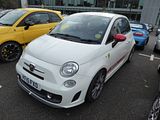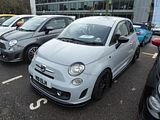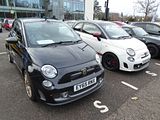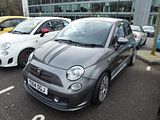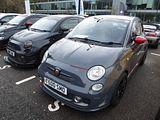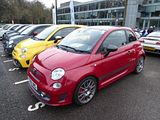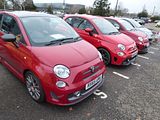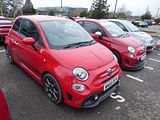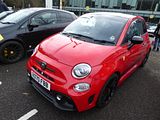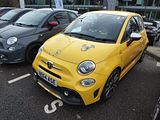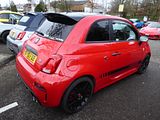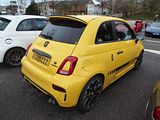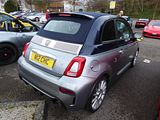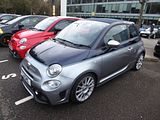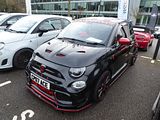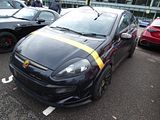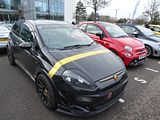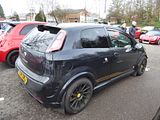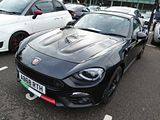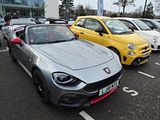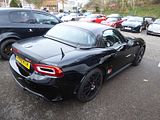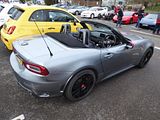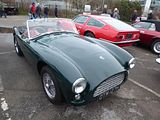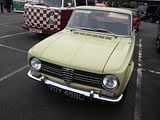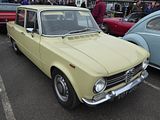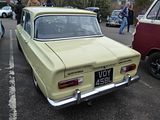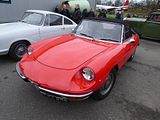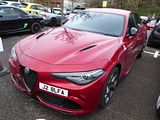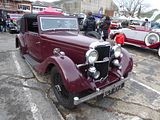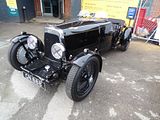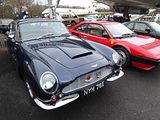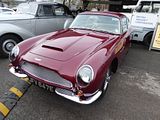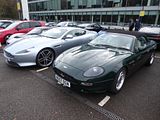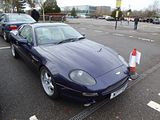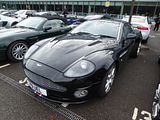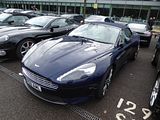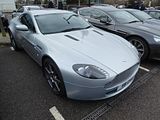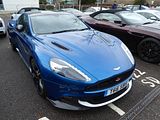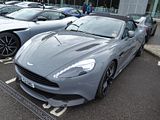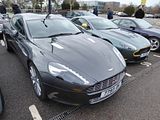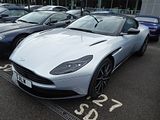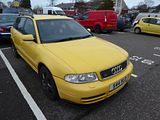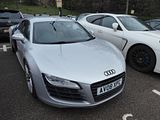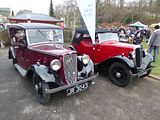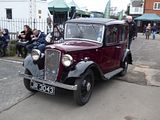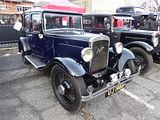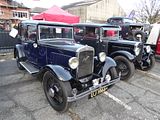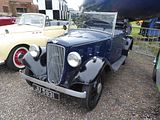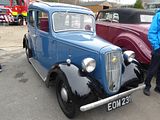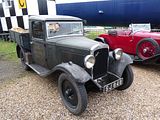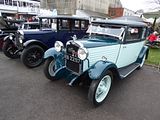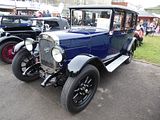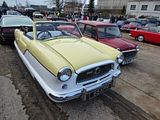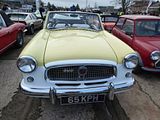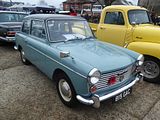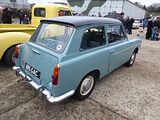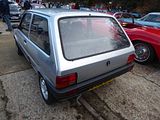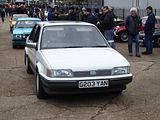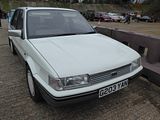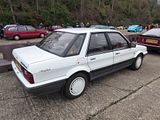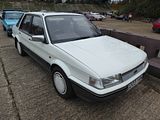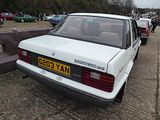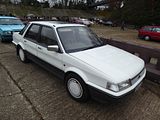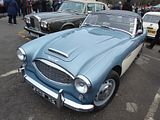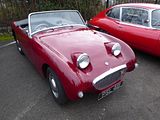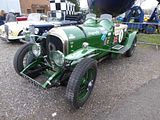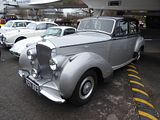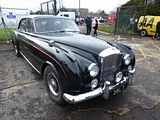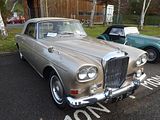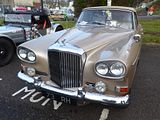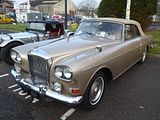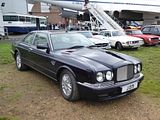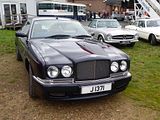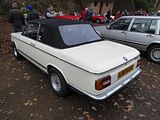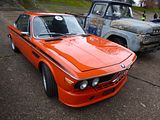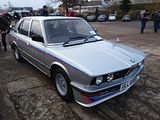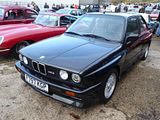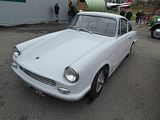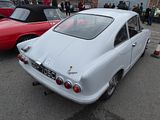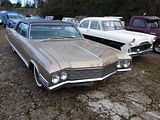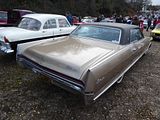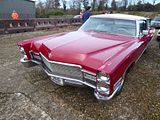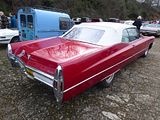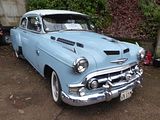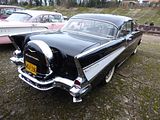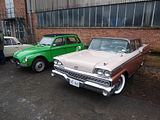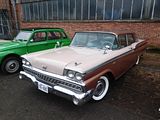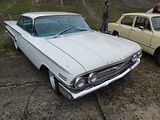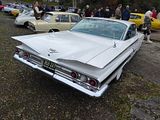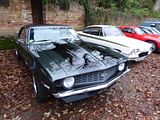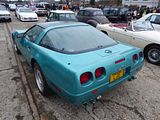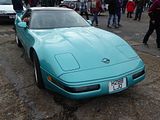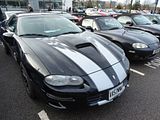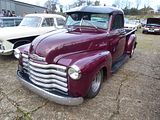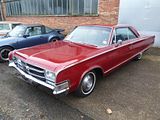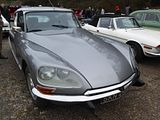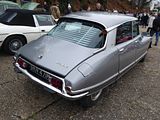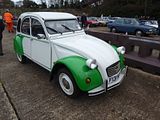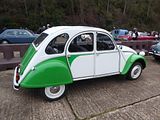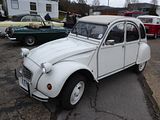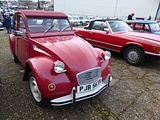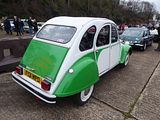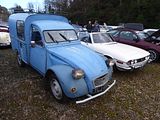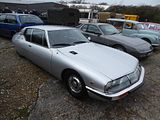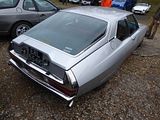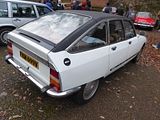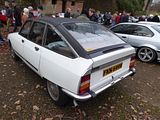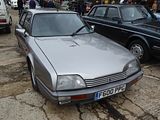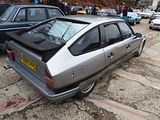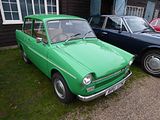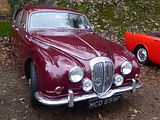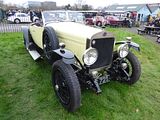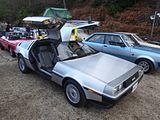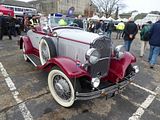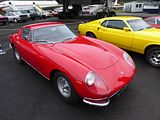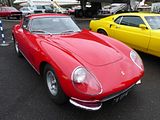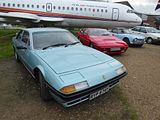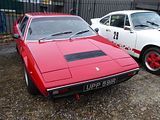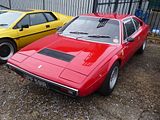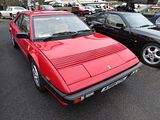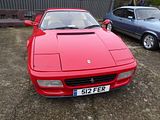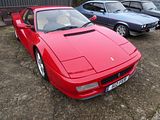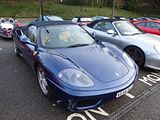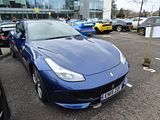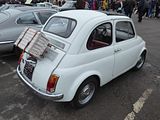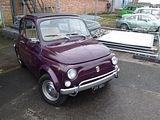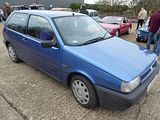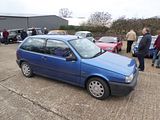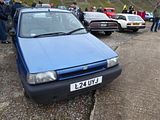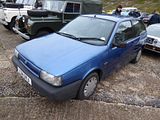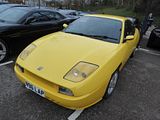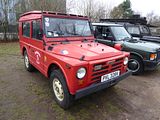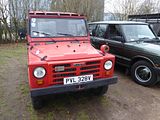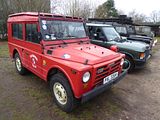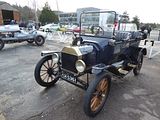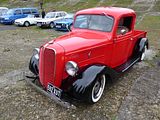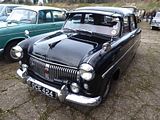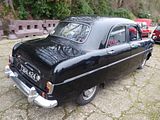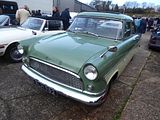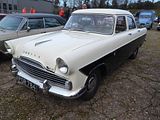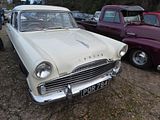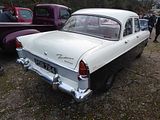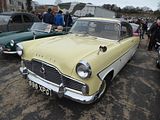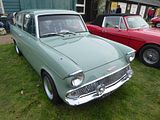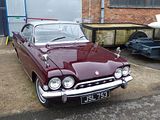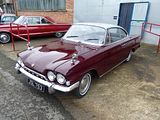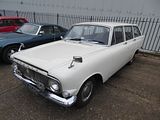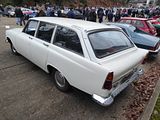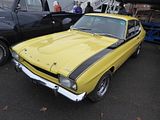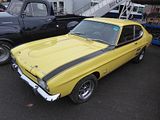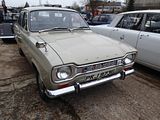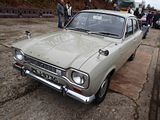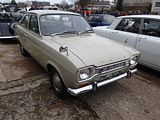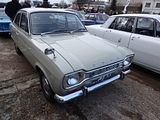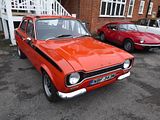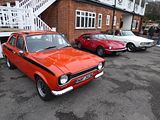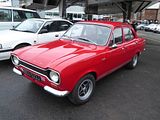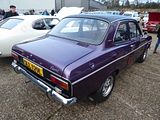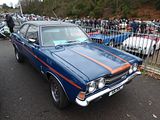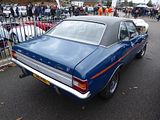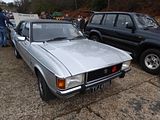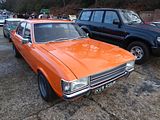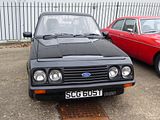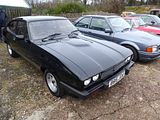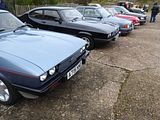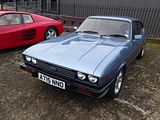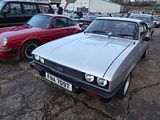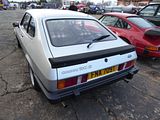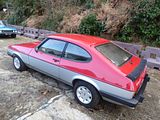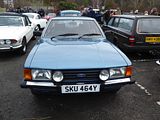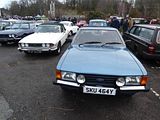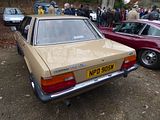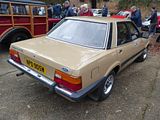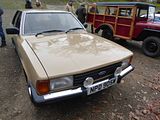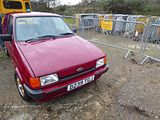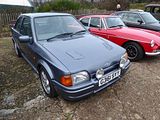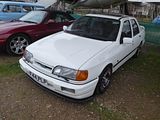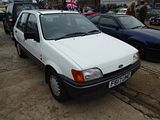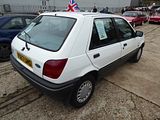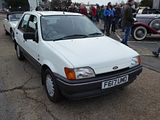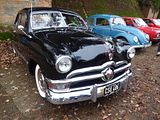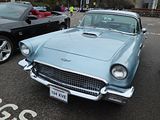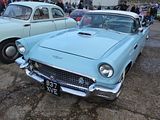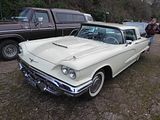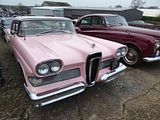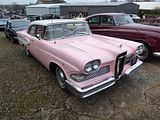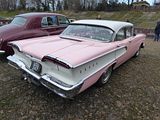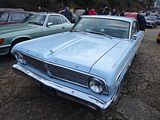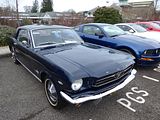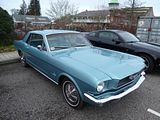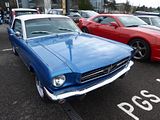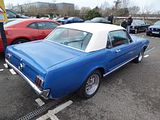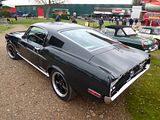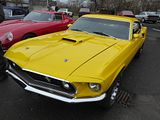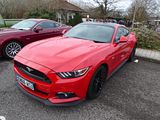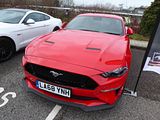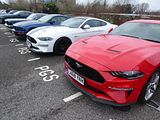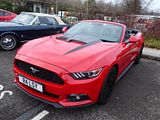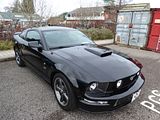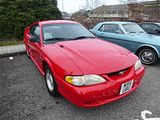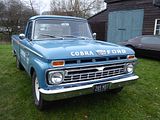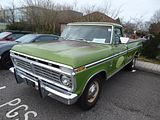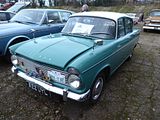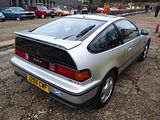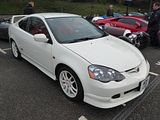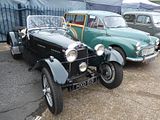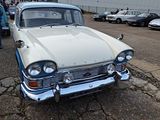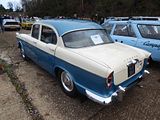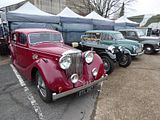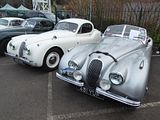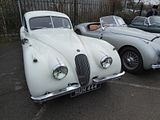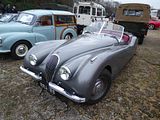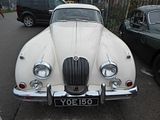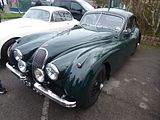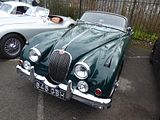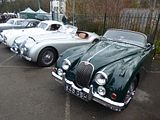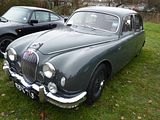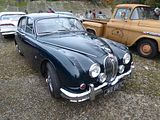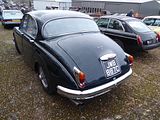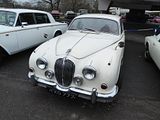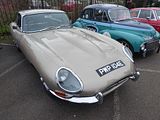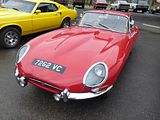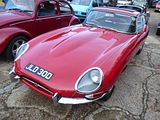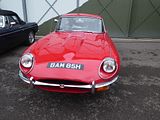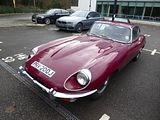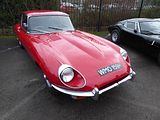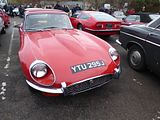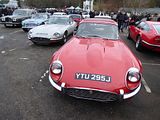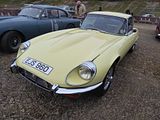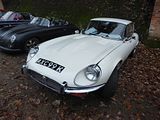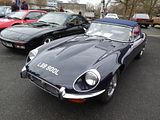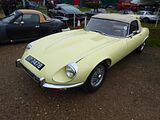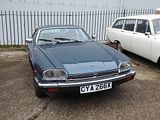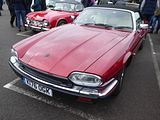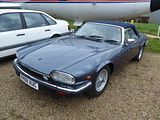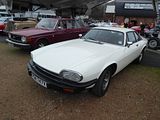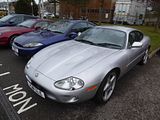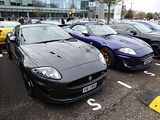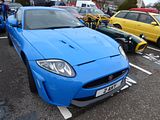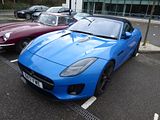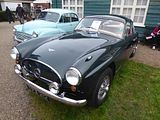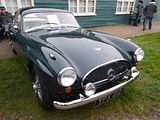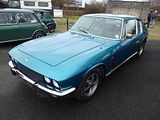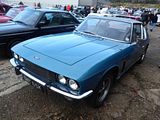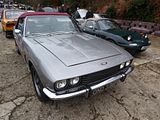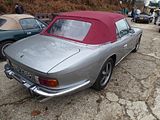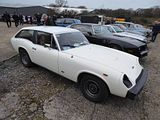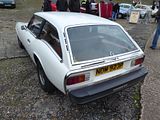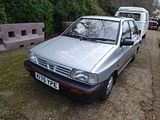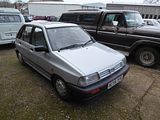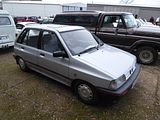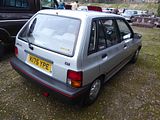Returning to the calendar for the first time since 2020 was the New Year’s Day meet at the legendary Brooklands site. This has long been the largest of a number of New Year’s Day meets, with in excess of 1000 cars turning up, packing the site with displays cars, and a vast area of public parking also in use for those who have come in something more modern and, dare I say, currently seen as prosaic. Although primarily aimed at individual display cars, Clubs are also welcome, and those with more modern but interesting cars, or supercars are given space in an area that adjoins the official Brooklands site, thus adding extra capacity, which is much needed. The weather is always a bit of a gamble at this time of the year, but for 2023, it was pleasantly mild and dry, which meant that people did come in droves, and there was lots to see. I raced around the extensive site several times trying to make sure I did not miss out on anything of significance or interest and the result is the collection of photos presented here, nearly 700 of them.
ABARTH
There is strong interest in the Abarth community for this event, and for the last few years I have been able to arrange a Club display area, which is included among the supercars and other modern veicles. This time, I had requests for around 20 places, which I thought was a good start for 2023!
The vast majority of cars here were the 500-based models which have been on sale now since the end of 2008, following a launch at the Paris Show that year. Since that time there have been a number of detailed changes to the standard cars and a lot of limited editions. Those who really know the marque can spot most of them, but some are so subtle that unless there is a badge you can see, you will not be quite sure which version you are looking at. It used to be relatively easy, when the model was first launched, as there was only one version as shipped ex works called the 500. It had a 135 bhp 1.4 litre turbo-charged engine coupled to a five speed manual gearbox, with 16″ alloys as standard, and the option of 17″ wheels, and a colour palette comprising of two whites (BossaNova White, the standard colour, or the pearlescent Funk White), Red (Pasadoble), Pale Grey (Campovolo) or Black. If you wanted more power – 160 bhp – then you could order an Esseesse kit, which came in a large wooden crate, containing new wheels, springs, an ECU upgrade, the Monza exhaust system and badging. It was dealer fitted and could be applied at any time within the first 12 months or 10,000 miles from registration. Needless to say, it proved popular. As were many of the optional extras, with stickers for the sides, a large scorpion for the bonnet and even a chequered pattern for the roof among the personalisation options offered. Oldest car here, and, of course, first to arrive, having apparently been at the gate a long time before it opened was Paul Hatton who has a somewhat individualised 500 Essesse which he has customised quite a bit over the years.
Having used the legendary 695 badging from the 1960s on the Tributo cars, at the 2012 Geneva Show, Abarth dusted off the 595 name that had been used on the less powerful of the Nuova 500 based cars of the same generation, and created two new versions which we should think of as Series 2 cars, the 595 Turismo and Competizione, both of which could be bought in either closed or open top C guise, with either the 5 speed manual or robotised automated gearshifts. Both models had the 160 bhp engine as standard. Effectively they were a replacement for the Esseesse kit, and it meant that the cars were produced complete at the factory, rather than needing the dealer to undertake the upgrade (and the associated paperwork), though Abarth did not withdraw the Esseesse kits from the market for some while. Turismo, as the name suggests was aimed slightly less extreme in intent, featuring standard leather upholstery, upgraded dampers and climate control, Xenon headlights and Alutex interior details. The sportier Abarth 595 Competizione replaced the leather seats with Sabelt cloth sport seats and Alutex with aluminium, while adding p-cross-drilled brakes and the Record Monza dual-mode exhaust.
Rumours started to circulate towards the end of 2014 that Abarth were going to upgrade the Competizione model, so as better to bridge the gap between the Turismo and the 190 bhp 695 Biposto that had been added to the range earlier in the year. It was Geneva 2015 when the result was finally shown to an expectant fan base. Most exciting news was that thanks to a bigger Garrett Turbo, the engine had been tweaked to 180 bhp, and with reduced CO2 emissions. A standard spec that included Koni Dampers, Brembo brakes, Xenon lights, Sabelt seats, Climate Control, parking sensors as well as other refinements that had been added like the TFT instrument display all proved very compelling, so not long after the first cars reached the UK in June of 2015, I found temptation too hard to resist, and as is well documented here, swapped my 2010 car for one of these. At the time I ordered it, Cordolo Red, a tri-coat pearlescent paint which shimmers in bright sunlight looked set to become one of the most popular colours of the lot, even though it is a cost option. Indeed, the Launch Edition models were all offered either in this colour or Scorpion Black, with black wheels. Surprisingly, the colour was not carried over to the Series 4 cars.
What is known as the Series 4 version of the familiar 595 reached the markets in the middle of 2016. After rumours had circulated all winter following the launch of the facelifted Fiat 500 last year, Abarth finally unveiled the Series 4 at the end of May 2016. Initially, we were told that the cars would not be available in the UK until September, but that came forward somewhat, with dealers all receiving demo cars in June, and the first customers taking delivery in July. Three regular production versions of both the closed car and the open-topped C were initially available, all badged 595, and called Custom, Turismo and Competizione, as before, though numerous limited edition models have since appeared and in most case disappeared. The most significant changes with the Series 4 are visual, with a couple of new colours, including the much asked for Modena Yellow and a different red, called Abarth Red, which replaces both the non-metallic Officina and – slightly surprisingly – the tri-coat pearlescent Cordolo Red. as well as styling changes front and rear. The jury is still out on these, with many, me included, remaining to be convinced. At the front, the new air intake does apparently allow around 15 – 20 % more air in and out, which will be welcome, as these cars do generate quite a lot of heat under the bonnet. Competizione models for the UK retain the old style headlights, as they have Xenon lights as standard, whereas the Custom and Turismo cars have reshaped units. At the back, there are new light clusters and a new rear bumper and diffuser. Inside, the most notable change is the replacement of the Blue & Me system with a more modern uConnect Audio set up, which brings a new colour screen to the dash. Mechanically, there is an additional 5 bhp on the Custom (now 145) and Turismo (now 165 bhp) and the option of a Limited Slip Diff for the Competizione, which is likely to prove a popular option. Details of the interior trim have changed, with a filled-in glovebox like the US market cars have always had, and electric windows switches that are like the US ones, as well as a part Alcantara trim to the steering wheel in Competizione cars. These cars have now been on offer for six years and with Abarth sales on the rise, it was no surprise that they were particularly well represented here.
More recently, Abarth have produced the 695 Rivale, a celebration of Fiat’s partnership with Riva, which has already seen a special Riva version of the 500,. Described as being “the most sophisticated Abarth ever”, it is available either as a hatch or a cabriolet, with both of them featuring a two-tone Riva Sera Blue and Shark Grey paintwork. The Rivale is adorned with an aquamarine double stripe, satin chrome finish on the door handles and satin chrome moulding on the tailgate, various aesthetic elements inspired by the Riva 56 Rivale yachts and ‘695 Rivale’ logos, joined by Brembo Brakes, Koni suspension, and 17-inch Supersport alloy wheels. Enhancing the nautical theme the new 695 Rivale features either a carbon fibre or mahogany dashboard, black mats with blue inserts, blue leather seats and door panels, carbon fibre kick plates, special steering wheel wrapped in blue and black leather and with a mahogany badge, blue leather instrument panel cover, and mahogany gear lever knob and kick plate. These are joined by the standard Uconnect infotainment with a 7-inch display, which is compatible with Android Auto and Apple CarPlay, and there is also a hand-written numbered plate that can be customised with the mane of the customer’s yacht on request. Powering the 695 Rivale is the same 1.4-litre turbocharged engine that makes 180PS (177hp) and 184lb/ft of torque, that features in the 595 Competizione, allowing it to go from rest to 100km/h (62mph) in 6.7 seconds and up to a top speed of 225km/h (140mph). This is a regular model in the range, but confusingly, there is also the Abarth 695 Rivale 175 Anniversary, created to celebrate 175 years of the Riva brand. Just 350 of these were produced, half of them the hatch and the other half cabriolets. These featured 17-inch alloy wheels with a special pattern, celebratory badge on the outside, hand-crafted details such as the two-tone colour – blue and black hand-stitched leather seats with a celebratory logo stitched onto the headrest, carbon dashboard silk screen printed with special logo, numbered plate. Standard Rivale cars arrived in the UK in April 2018, and quite a few have been sold. They always attract lots of interest when they do appear.
Many Abarth owners spend a lot of time and money on modifying their cars. Some focus on looks, whilst others are interested in what they can do mechanically to add more power, or other mechanical modifications. There were a number of duly modified cars here, all of which attract lots of attention from everyone present. Whilst some of the changes are not entirely to my taste (I can be something of a purist at times!), there can be no doubting the care and attention (and in many cases money) that has gone into their creation).
The final Punto model was the SuperSport. Easily identified by the distinctive black bonnet, just 199 of the SuperSport versions were built, of which around 120 are registered on UK roads. These cars had many of the options from the Punto Evo included as standard. Power came from the the 1.4-litre MultiAir turbo engine, tuned to produce 178bhp and 199lb ft of torque, up from 165 of the standard Punto Evo, giving the SuperSport a 0-62 time of 7.5 seconds and a top speed of over 132mph. To help put the power down, the SuperSport was fitted with wider 18″ wheels and optional Koni FSD dampers. Standard equipment included the Blue&Me infotainment system with steering wheel controls, automatic climate control and a popular option was the ‘Abarth Corsa by Sabelt’ sports leather seats. The SuperSport was available in the same colours as the regular Punto Evo, which means white, grey, black and red.
The Abarth 124 Spider was developed in parallel with the Fiat model. It does cost a lot more, and there are those who think you don’t get enough extra for your money, but those who have driven it will tell you otherwise. You certainly get more power. The 1.4 MultiAir turbo unit jumps up from 138bhp to 168bhp, while torque also increases by a modest 10Nm to 250Nm, which gives it a 0-62mph time of 6.8 seconds, which is half a second quicker than the 2.0-litre Mazda MX-5. The top speed is 143mph. It weighs just 1060kg meaning a power-to-weight ratio of 158bhp-per-tonne, and with the new Record Monza exhaust system it sounds great even at idle. The Abarth version gets a stiffer suspension setup than the regular Fiat 124 Spider, with Bilstein dampers and beefed-up anti-roll bars. Bigger Brembo brakes also feature, with aluminium calipers. It can be had with a six-speed manual or six-speed automatic transmission with paddles, and the latter gets a Sport mode for quicker shifts. Many of the UK cars sport the ‘Heritage Look’ pack, which is a no-cost option. It brings a matt black bonnet and bootlid, plus red exterior trim detailing and has proved popular. The £29,565 starting price gets you standard equipment such as cruise control, climate control, Bluetooth, a DAB radio and satnav, plus Alcantara black and red (or pure black) seat trim. The automatic gearbox is a £2,035 extra, while an optional visibility pack brings LED DRLs, auto lights and wipers and rear parking sensors. Sales ceased during 2019, with around 1800 cars having been brought into the UK, so this is always going to be a rare car, and values are already increasing at a rate reflecting its desirability and the difficulty in finding one.
AC
AC had come back to the market after the Second World War with the staid 2-Litre range of cars in 1947, but it was with the Ace sports car of 1953 that the company really made its reputation in the post war years. Casting around for a replacement for the ageing 2-Litre, AC took up a design by John Tojeiro that used a light ladder type tubular frame, all independent transverse leaf spring suspension, and an open two seater alloy body made using English wheeling machines, possibly inspired by the Ferrari Barchetta of the day. Early cars used AC’s elderly 100 bhp two-litre overhead cam straight-six engine (first seen soon after the end of the First World War), which, according to a 1954 road test by Motor magazine, gave a top speed of 103 mph, a 0–60 mph in 11.4 seconds and a fuel consumption of 25.2 mpg. It was hardly a sporting engine, however, and it was felt that something more modern and powerful was required to put the modern chassis to good use. Joining the Ace in 1954 was the Aceca hard top coupé, which had an early form of hatchback rear door but used the same basic timber framed alloy body. From 1956, there was the option of Bristol Cars’ two-litre 120 bhp straight-six with 3 downdraught carburettors and slick four-speed gearbox. Top speed leapt to 116 mph with 0–60 mph in the nine second bracket. Overdrive was available from 1956 and front disc brakes were an option from 1957, although they were later standardised. In 1961 a new 2.6-litre straight-six ‘Ruddspeed’ option was available, adapted by Ken Rudd from the unit used in the Ford Zephyr. It used three Weber or SU carburettors and either a ‘Mays’ or an iron cast head. This setup boosted the car’s performance further, with some versions tuned to 170 bhp, providing a top speed of 130 mph and 0–60 mph in 8.1 seconds. However, it was not long before Carroll Shelby drew AC’s attention to the Cobra, so only 37 of the 2.6 models were made. These Ford engined models had a smaller grille which was carried over to the Cobra.
ALFA ROMEO
First of the all-new Giulia models to appear was the Berlina, launched in 1962. The styling was quite straight forward, but great attention was paid to detail. The engine bay, cabin and boot were all square shaped. But the grille, the rooflines and details on the bonnet and boot made for an integrated design from bumper to bumper. Thanks to Alfa Romeo using a wind tunnel during its development, the Giulia was very aerodynamic with a drag coefficient of Cd=0.34, which was particularly low for a saloon of the era and not a bad figure even for cars of today. Couple that with the fact that Alfa Romeo was one of the first manufacturers to put a powerful engine in a light-weight car (it weighed about 1,000 kilograms) and thanks to an array of light alloy twin overhead camshaft four-cylinder engine, similar to that of the earlier Giulietta models range, the car had a lively performance which bettered that of many sports cars of the day. The Tipo 105.14 was the first model, with a 1,570 cc Twin Cam engine with single down-draft carburettor generating 91 hp at 6500 rpm. The “TI” nomenclature referred to a class of Italian saloon car racing known as “Turismo Internazionale”, and had previously been applied to higher-performance versions of the 1900 and Giulietta saloons in the 1950s. However, for the Giulia saloon, the Ti was at first the only version available, and later, with the introduction of the TI Super and Super, the TI became the base version for the 1,600 cc engine class. The steering column gearchange (the only one in the Giulia range) was replaced with a floor change for 1964 (Tipo 105.08). Right hand drive cars, available from 1964, only ever had a floor change (Tipo 105.09). Brakes were by drums all around at first. Discs were introduced later, first at the front, and later all around. A brake servo was not fitted at first, but was introduced in later cars. The steering wheel featured the only horn ring ever in the Giulia range. The dashboard with a strip speedo is a notable feature, as is the steering wheel with a horn ring. The Giulia TI was phased out in 1968 and re-introduced as the austerity model 1600 S. Tipo 105.16 was a special racing model introduced in 1963. Quadrifoglio Verde stickers on the front wings were a distinguishing feature. Only 501 were made for homologation and today it is very rare and desirable. The 1,570 cc engine was fitted with two double-choke horizontal Weber 45DCOE carburettors for 110 hp at 6500 rpm. The body was lightened and a floor gearchange was fitted as standard, as were alloy wheels of very similar appearance to the standard steel ones of the TI. The TI’s instrument cluster with its strip speedometer was replaced with a three-instrument binnacle comprising speedometer, tachometer and a multi-gauge instrument (fuel, water temperature, oil temperature and pressure) – these instruments were similar to those fitted to the contemporary Giulia Sprint and Sprint Speciale coupes and Spider convertibles. The steering wheel was a three-spoke item with centre hornpush, also similar to that of the more sporting models. Braking was by discs all around, although the first cars used drums and early disc models lacked a servo which was introduced later. The police cars seen in The Italian Job were of this type. Tipo 105.06 was an austerity model made from 1964 to 1970 with a 1,290 cc single-carburettor engine for 77 hp at 6000 rpm. Four-speed gearbox with floor change fitted as standard (the 1300 was the only Giulia model not fitted with a five-speed gearbox). Though the engine was given a 105 series type number, it was basically the engine from the 101 series Giulietta Ti. This model appears not to have been exported to many markets outside Italy, if at all. Braking was by discs all around, without a servo at first, later with a servo. Tipo 105.26 was introduced in 1965. It transferred the technology from the racing TI Super to a road car, to make the most successful Giulia saloon. 1,570 cc engine with two double-choke Weber 40DCOE carburettors for a milder, but torquier tune than the TI Super – 97 hp at 5500 rpm. There was a new dashboard with two large round instruments (speedo and tacho) and clock, a sportier steering wheel with three aluminium spokes and centre horn push, similar to that of the Ti Super, later changed for one with the horn pushes in the spokes. All-around disc brakes with servo were fitted as standard from the outset. The serpent crest of the Sforza family appears in a badge on the C-pillar and is a distinguishing feature of the Super. For 1968, there was a suspension update, including revised geometry and a rear anti-roll bar. The wheels were changed in size from 5J x 15 to 5J x 14, and tyres from 155/15 to 165/14. For 1970, updates included dual-circuit brakes, centre-mounted handbrake lever to replace under-dash “umbrella handle”, larger external doorhandles, and top-hinged pedals (the latter in left hand drive models only; right hand drive continued with bottom-hinged pedals to the end of production). In 1972, Tipo 105.26 was rationalised into the Giulia 1.3 – Giulia 1.6 range. Tipo 105.39 built from 1965 to 1972. Right hand drive model replaced in 1970 by the 1300 Super. 1,290 cc engine with single down-draft carburettor for 81 hp at 6000 rpm. Unlike the re-deployed 101-series Giulietta engine of the austerity-model 1300, the 1300 ti motor was a 105 series engine, basically that of the sportier GT1300 Junior coupe with different camshaft timing (but the same camshafts) and induction system. Five-speed gearbox. Three-spoke bakelite steering wheel with plastic horn push covering the centre and spokes. Dashboard initially with strip speedo like that of the TI. For 1968, updates included a dashboard based on that of the Super, but with a simpler instrument binnacle, still featuring two large round instruments (speedo and tacho) and a separate fuel gauge, and the same suspension, wheel and tire updates applied to the Giulia Super in the same year. For 1970, updates included dual-circuit brakes, centre handbrake, larger external doorhandles and top-hinged pedals (on left hand drive cars only), again as applied to the Super for that year. Tipo 105.85 was basically a Giulia TI re-introduced in 1968 as a lower-level model to come between the 1300 and 1300 ti on one hand, and the Super on the other. It had a re-interpretation of the 1,570 cc single-carburettor engine for 94 hp at 5500 rpm and similar trim to the 1300 ti. Replaced in 1970 by the 1300 Super which offered similar performance in a lower tax bracket. The last cars from 1970 featured the top-hinged pedals, centre handbrake and dual-circuit brakes as for the Super and 1300 ti. Tipo 115.09 was introduced in 1970. It was basically a 1300 ti fitted with the engine from the GT 1300 Junior coupe that featured two double-choke horizontal carburettors; the engine actually had the GT 1300 Junior type number. This model was rationalised into the Giulia Super 1.3 – Giulia Super 1.6 range in 1972. In 1972 a rationalisation of the Giulia range saw the Super 1300 (Tipo 115.09) and the Super (Tipo 105.26) re-released as the Super 1.3 and Super 1.6. The two models featured the same equipment, interior and exterior trim, differing only in engine size and final drive ratio. The 1300 ti was dropped. A small Alfa Romeo badge on the C-pillar is a distinguishing feature, as are hubcaps with exposed wheel nuts. In December 1972 Alfa-Romeo South Africa released the 1600 Rallye. This locally developed more powerful 1600 cc version of the 1300 Super used the 1300’s single-headlight body shell. The car was largely ready for competition and was only planned to be built in limited numbers, and was fitted with racing-style rear-view mirrors, rally lamps, fully adjustable seats, and a limited-slip differential. Claimed power was 125 hp. The Giulia Super range was re-released in 1974 as the Nuova Super range, including the Giulia Nuova Super 1300 and 1600 This featured a new black plastic front grille and a flat boot lid without the characteristic centre spine. Otherwise the cars differed little from their Giulia Super predecessors and bore the same Tipo numbers with an S suffix. A Nuova Super fitted with a Perkins 1,760 cc diesel with 54 hp at 4000 rpm, was the firm’s first attempt at diesel power. The same Perkins diesel was used also in Alfa Romeo F12 van. The diesel version was slow, 138 km/h (86 mph), and the engine somehow unsuitable for a sport sedan so it was not big seller, only around 6500 examples were made in 1976 and the car was not sold in the UK. Production of the Giulia ceased in 1977. There are relatively few of these cars in the UK, and many of these are left hand drive models which have been re-imported relatively recently, or have been converted for historic racing, so it was good to see a nice road-going Berlina model here.
Also here was a number of examples of the 105 Series Coupe, with 1750 GTV and 2000 GTV here. There’s a complex history to this much-loved classic. The first car was called the Alfa Romeo Giulia Sprint GT, and was revealed at a press event held at the then newly opened Arese plant on 9 September 1963, and displayed later the same month at the Frankfurt Motor Show. In its original form the Bertone body is known as scalino (step) or “step front”, because of the leading edge of the engine compartment lid which sat 1/4 an inch above the nose of the car. The Giulia Sprint GT can be distinguished from the later models by a number of features including: Exterior badging: Alfa Romeo logo on the front grille, a chrome script reading “Giulia Sprint GT” on the boot lid, and rectangular “Disegno di Bertone” badges aft of the front wheel arches; flat, chrome grille in plain, wide rectangular mesh without additional chrome bars; single-piece chrome bumpers; no overriders. Inside the cabin the padded vinyl dashboard was characterised by a concave horizontal fascia, finished in grey anti-glare crackle-effect paint. Four round instruments were inset in the fascia in front of the driver. The steering wheel was non-dished, with three aluminium spokes, a thin bakelite rim and a centre horn button. Vinyl-covered seats with cloth centres and a fully carpeted floor were standard, while leather upholstery was an extra-cost option. After initially marketing it as a four-seater, Alfa Romeo soon changed its definition of the car to a more realistic 2+2. The Giulia Sprint GT was fitted with the 1,570 cc version of Alfa Romeo’s all-aluminium twin cam inline four (78 mm bore × 82 mm stroke), which had first debuted on the 1962 Giulia Berlina. Breathing through two twin-choke Weber 40 DCOE 4 carburettors, on the Sprint GT this engine produced 105 hp at 6,000 rpm. Like all subsequent models, the Sprint GT was equipped with an all-synchromesh 5-speed manual transmission. The braking system comprised four Dunlop disc brakes and a vacuum servo. The rear brakes featured an unusual arrangement with the slave cylinders mounted on the axle tubes, operating the calipers by a system of levers and cranks. According to Alfa Romeo the car could reach a top speed of “over 180 km/h (112 mph)”. In total 21,902 Giulia Sprint GT were produced from 1963 to 1965, when the model was superceded by the Giulia Sprint GT Veloce. Of these 2,274 were right hand drive: 1,354 cars fully finished in Arese, and 920 shipped in complete knock-down kit form for foreign assembly. For 1966, the Giulia Sprint GT was replaced by the Alfa Romeo Giulia Sprint GT Veloce, which was very similar but featuring a number of improvements: a revised engine—slightly more powerful and with more torque—better interior fittings and changes to the exterior trim. Alongside the brand new 1750 Spider Veloce which shared its updated engine the Sprint GT Veloce was introduced at the 36th Geneva Motor Show in March 1966, and then tested by the international specialist press in Gardone on the Garda Lake. Production had began in 1965 and ended in 1968. The Giulia Sprint GT Veloce can be most easily distinguished from other models by the following features: badging as per Giulia Sprint GT, with the addition of round enamel badges on the C-pillar—a green Quadrifoglio (four-leaf clover) on an ivory background—and a chrome “Veloce” script on the tail panel; black mesh grille with three horizontal chrome bars; the grille heart has 7 bars instead of 6; stainless steel bumpers, as opposed to the chromed mild steel bumpers on the Giulia Sprint GT. The bumpers are the same shape, but are made in two pieces (front) and three pieces (rear) with small covers hiding the joining rivets. Inside the main changes from the Giulia Sprint GT were imitation wood dashboard fascia instead of the previous anti-glare grey finish, front seats revised to a mild “bucket” design, and a dished three aluminium spoke steering wheel, with a black rim and horn buttons through the spokes. The Veloce’s type 00536 engine, identical to the Spider 1600 Duetto’s, featured modifications compared to the Giulia Sprint GT’s type 00502—such as larger diameter exhaust valves. As a result it produced 108 hp at 6,000 rpm, an increase of 3 hp over the previous model, and significantly more torque. The top speed now exceeded 185 km/h (115 mph). Early Giulia Sprint GT Veloces featured the same Dunlop disc brake system as the Giulia Sprint GT, while later cars substituted ATE disc brakes as pioneered on the GT 1300 Junior in 1966. The ATE brakes featured an handbrake system entirely separate from the pedal brakes, using drum brakes incorporated in the rear disc castings. Though the Sprint GT Veloce’s replacement—the 1750 GT Veloce—was introduced in 1967, production continued throughout the year and thirty final cars were completed in 1968. By then total Giulia Sprint GT Veloce production amounted to 14,240 examples. 1,407 of these were right hand drive cars, and 332 right hand drive complete knock-down kits. The Alfa Romeo 1750 GT Veloce (also known as 1750 GTV) appeared in 1967 along with the 1750 Berlina sedan and 1750 Spider. The same type of engine was used to power all three versions; this rationalisation was a first for Alfa Romeo. The 1750 GTV replaced the Giulia Sprint GT Veloce and introduced many updates and modifications. Most significantly, the engine capacity was increased to 1779 cc displacement. Peak power from the engine was increased to 120 hp at 5500 rpm. The stroke was lengthened from 82 to 88.5 mm over the 1600 engine, and a reduced rev limit from 7000 rpm to 6000 rpm. Maximum torque was increased to 137 lb·ft at 3000 rpm. A higher ratio final drive was fitted (10/41 instead of 9/41) but the same gearbox ratios were retained. The result was that, on paper, the car had only slightly improved performance compared to the Giulia Sprint GT Veloce, but on the road it was much more flexible to drive and it was easier to maintain higher average speeds for fast touring. For the United States market, the 1779 cc engine was fitted with a fuel injection system made by Alfa Romeo subsidiary SPICA, to meet emission control laws that were coming into effect at the time. Fuel injection was also featured on Canadian market cars after 1971. Carburettors were retained for other markets. The chassis was also significantly modified. Tyre size went to 165/14 from 155/15 and wheel size to 5 1/2J x 14 instead of 5J x 15, giving a wider section and slightly smaller rolling diameter. The suspension geometry was also revised, and an anti-roll bar was fitted to the rear suspension. ATE disc brakes were fitted from the outset, but with bigger front discs and calipers than the ones fitted to GT 1300 Juniors and late Giulia Sprint GT Veloces. The changes resulted in significant improvements to the handling and braking, which once again made it easier for the driver to maintain high average speeds for fast touring. The 1750 GTV also departed significantly from the earlier cars externally. New nose styling eliminated the “stepped” bonnet of the Giulia Sprint GT, GTC, GTA and early GT 1300 Juniors and incorporated four headlamps. For the 1971 model year, United States market 1750 GTV’s also featured larger rear light clusters (there were no 1970 model year Alfas on the US market). Besides the chrome “1750” badge on the bootlid, there was also a round Alfa Romeo badge. Similar Quadrofoglio badges to those on the Giulia Sprint GT Veloce were fitted on C pillars, but the Quadrofoglio was coloured gold instead of green. The car also adopted the higher rear wheelarches first seen on the GT 1300 Junior. The interior was also much modified over that of earlier cars. There was a new dashboard with large speedometer and tachometer instruments in twin binnacles closer to the driver’s line of sight. The instruments were mounted at a more conventional angle, avoiding the reflections caused by the upward angled flat dash of earlier cars. Conversely, auxiliary instruments were moved to angled bezels in the centre console, further from the driver’s line of sight than before. The new seats introduced adjustable headrests which merged with the top of the seat when fully down. The window winder levers, the door release levers and the quarterlight vent knobs were also restyled. The remote release for the boot lid, located on the inside of the door opening on the B-post just under the door lock striker, was moved from the right hand side of the car to the left hand side. The location of this item was always independent of whether the car was left hand drive or right hand drive. Early (Series 1) 1750 GTV’s featured the same bumpers as the Giulia Sprint GT Veloce, with the front bumper modified to mount the indicator / sidelight units on the top of its corners, or under the bumper on US market cars. The Series 2 1750 GTV of 1970 introduced other mechanical changes, including a dual circuit braking system (split front and rear, with separate servos). The brake and clutch pedals on left hand drive cars were also of an improved pendant design, instead of the earlier floor-hinged type. On right hand drive cars the floor-hinged pedals were retained, as there was no space for the pedal box behind the carburettors. Externally, the series 2 1750 GTV is identified by new, slimmer bumpers with front and rear overriders. The combined front indicator and sidelight units were now mounted to the front panel instead of the front bumper, except again on the 1971-72 US/Canadian market cars. The interior was slightly modified, with the seats retaining the same basic outline but following a simpler design. 44,269 1750 GTVs were made before their replacement came along. That car was the 2000GTV. Introduced in 1971, together with the 2000 Berlina sedan and 2000 Spider, the 2 litre cars were replacements for the 1750 range. The engine displacement was increased to 1962 cc. The North American market cars had fuel injection, but everyone else retained carburettors. Officially, both versions generated the same power, 130 hp at 5500 rpm. The interior trim was changed, with the most notable differences being the introduction of a separate instrument cluster, instead of the gauges installed in the dash panel in earlier cars. Externally the 2000 GTV is most easily distinguished by its grille with horizontal chrome bars, featuring protruding blocks forming the familiar Alfa heart in outline, smaller hubcaps with exposed wheel nuts, optional aluminium alloy wheels of the same size as the standard 5. 1/2J × 14 steel items, styled to the “turbina” design first seen on the alloy wheels of the Alfa Romeo Montreal, and the larger rear light clusters first fitted to United States market 1750 GTV’s were standard for all markets. From 1974 on, the 105 Series coupé models were rationalised and these external features became common to post-1974 GT 1300 Junior and GT 1600 Junior models, with only few distinguishing features marking the difference between models. 37,459 2000 GTVs were made before production ended and these days they are very sought after with prices having sky-rocketed in recent years.
The original 1966 Spider shape was the result of a number of Pininfarina design studies, concept cars showing traits incorporated in the final production design. The first one was the Alfa Romeo Superflow, a concept car built upon the chassis of a retired 6C 3000 CM racing car and first show at the 1956 Turin Motor Show. Despite being an aerodynamic coupé with prominent fins on the rear, and a futuristic all-plexiglas greenhouse and front wings, the Superflow already shown the overall body shape of the future Spider and the scallops on the sides. In the following years the Superflow was updated three times into three more different concept cars, namely a Superflow II coupé, then an open-top spider and finally another Superflow IV coupé. The most significant in the Spider’s design history was the second, the open-top Alfa Romeo Spider Super Sport, shown at the 1959 Geneva Motor Show. It did without the rear fins of the Superflow and Superflow II, showing for the first time the rounded cuttlebone-shaped tail and tail light configuration of the Spider. Last of the Spider’s forerunner was the Alfa Romeo Giulietta SS Spider Aerodinamica, which premiered at the 1961 Turin Motor Show, and was based on the Giulietta Sprint Speciale. Very close to the shape of the production car, its main design differences were at the front, due to hideaway headlamps. Despite the almost final design being ready in 1961, the continuing success of existing models and the economic challenges facing Italy at the time meant that the first pre-launch production Spiders began to emerge from the Pininfarina production line only at the end of 1965. The Spider was launched at the 36th Geneva Motor Show in March 1966, together with the Giulia Sprint GT Veloce at an event organised in Gardone Riviera. With its boat tailed styling, it quickly found favour, even before taking a starring role in the film “The Graduate”. The original 1600cc engine was replaced by a more powerful 1750cc unit at the same time as the change was made to the rest of the range, and the car continued like this until 1970, when the first significant change to the exterior styling was introduced on the 1750 Spider Veloce, with the original’s distinctive elongated round tail changed to a more conventional cut-off tail, called the “Kamm tail”, as well as improving the luggage space. Numerous other small changes took place both inside and out, such as a slightly different grille, new doorhandles, a more raked windscreen, top-hinged pedals and improved interior trim. 1971 saw the Spider Veloce get a new, larger powerplant—a 1962 cc, 132 hp unit—and consequently the name was changed from 1750 Spider Veloce to 2000 Spider Veloce. The 1600 Spider restarted production a year later as the Spider 1600 Junior, and was visually identical to the 1300. 1974 saw the introduction of the rare, factory request, Spider-Targa. Based upon the Spider, it featured a Porsche style solid rear window and lift out roof panels, all made out of black GRP type material. Less than 2,000 models of such type were ever made and was the only part solid roof Spider until the introduction of the factory crafted hard top. The 1300 and 2000 cars were modified in 1974 and 1975 respectively to include two small seats behind the front seats, becoming a “two plus two” four seater. The 1300 model was discontinued in 1977. Also, between 1974 and 1976, the early-style stainless-steel bumpers were discontinued and replaced with black, rubber-clad units to meet increasingly stringent North American crash requirements. 4,557 examples of the 1300 Junior were made and 4,848 of the 1600 Junior as well as 16,320 2000 Spider Veloces and 22,059 of 2000 Spider Veloce US version. There were also 4,027 1750 Spider Veloces produced
Rather more modern was this example of the highly rated and still current Giulia Quadrifoglio.
ALVIS
This one is a TA14 Coupe. The Alvis Fourteen also known as TA 14 was the first car to be produced by major defence contractor Alvis cars after World War II. The entire car factory had been destroyed on the night of Thursday 14 November 1940. Announced in November 1946 it was made until 1950 when its postwar austerity 1900 cc engine was replaced by the 2993 cc Alvis Three Litre or TA 21. The Fourteen was available as a four-door sports saloon built for Alvis by Mulliners of Birmingham but there were also Tickford and Carbodies drophead versions. When compared with the 12/70 car it replaced the interior is 4 inches wider and the distance between rear-seat armrests is increased almost 5 inches. The 1892 cc engine is a slightly larger-bore version of the one used in the 12/70 and produced 65 bhp. It is fitted with a single SU type H4 -inch side-draught carburettor. Inlet valves have been enlarged. The triplex chain drive has been given an automatic tensioner. The engine’s exhaust system has been extensively revised and the direction of flow of cooling water around the engine has been substantially changed. The bodies were mounted on an updated pre-war Alvis 12/70 chassis that was widened and lengthened but retained the rigid-axle leaf spring suspension. Employing Silentbloc bushes (except at the front of the front springs to maintain steering precision) it is controlled by double acting Armstrong hydraulic dampers. Hypoid bevel final drive was fitted for the first time and greatly reduced the height of the transmission tunnel. Steering is by Marles with a spring spoked steering wheel. Mechanically operated brakes are two-leading-shoe type by Girling. Disc wheels replaced the 12/70’s wire wheels and are fitted with larger tyres. The top speed is around 74 mph and acceleration from 0 to 60 mph in 22.2 seconds.
ASTON MARTIN
Oldest Aston here was this pre-war International. With more short chassis cars than tourers being produced in 1929, the efforts of the Aston Martin works were clearly going towards the sports end of the market. By the end of the year the ‘Standard Sports Model’ had developed into the ‘Four-seater “International” Sports Model’, more commonly known simply as the “International”. It was quickly and widely regarded as one of the best light sports cars of the day. The name “International” was coined to cash in on the works’ racing efforts. The appearance of the cars at Brooklands race track and in rallies, sprints and hill climbs all around the country alongside the works team cars, increased the cars’ sporting reputation. The “International” was truly a sports car in the best tradition of the earlier Bamford and Martin cars. Now with twin 1⅛” carburetors it had dry sump lubrication as standard, which kept the temperature of the oil at least 10 degrees cooler than in the wet sump engines. It was fitted with relatively large fourteen inch diameter brakes operated by Perrot shafts at the front. The “International” was expensive but performance was good enough for the motoring press to praise the car highly. A significant amount of advertising was placed in the popular motoring press highlighting competition successes. The “International” had a similar but dimensionally different chassis to the ‘Standard Sports Model’. Also slightly different, was the brake arrangement, and the gearbox was moved back in the chassis to leave more room in the driver’s side foot-well. These small modifications were typical of the subtle development that all the Bertelli cars went through. This was in part a result of Bertelli driving the cars himself in competition. For example, he would have been well aware that the gearbox of the early cars needed to be moved back; he would have had a pain in his left leg where they constantly rubbed! Renwick and Bertelli had designed and developed a simple yet rugged 1½ litre sports car. The build quality was very high with the best standard of materials used throughout. The entire car (with the exception of the steering box) was designed and built at the factory (from November 1929, now Aston Martin Ltd). It was very carefully assembled with engines, rear axles and gearboxes all tested on their own dynamometers, after which they were stripped and checked. This made it very expensive to produce. However, the simplicity and elegance of the design made for an efficient little sports car, which had the legs of many of its competitors. Built on the short chassis, most of the first series cars were bodied by E. Bertelli Ltd. The standard “International” coachwork was a slightly perpendicular open 2/4 seater, with minimal space in the back for passengers. It was characterized by a rather high profile stemming from a tall ‘wet case’ radiator (the shell forming the water tank) which was further emphasized by the 21″ wheels. The fuel tank was enclosed beneath the rear of the body and the spare wheel bracketed on to the body at the extreme rear. The exhaust system was taken from the cylinder head in a simple manifold with the downpipe going down inside the bonnet to the tail pipe and exhaust box below the car. The windscreen folded forward from the base, not flat onto the scuttle (with the exception of the “International Le Mans” model).
The DB6 was launched in 1965 as a replacement for the DB5 which had run since 1963. The wheelbase was now 4″ longer than before, resulting in an extensive restyle with a more raked windscreen, raised roofline and reshaped rear quarter windows. Opening front quarter lights made a reappearance, but the major change was at the rear where a Kamm tail with spoiler improved the aerodynamics, greatly enhancing stability at high speeds. “The tail lip halves the aerodynamic lift around maximum speed and brings in its train greater headroom and more luggage space”, declared Motor magazine, concluding that the DB6 was one of the finest sports cars it had tested. Famed employee, Tadek Marek, designed the six cylinder engine, which had been enlarged to 3,995cc for the preceding DB5 and remained unchanged. Power output on triple SU carburettors was 282bhp, rising to 325bhp in Vantage specification. Premiered at the 1965 London Motor Show, the DB6 Volante marked the first occasion the evocative ‘Volante’ name had been applied to a soft-top Aston Martin. After 37 Volante convertibles had been completed on the DB5 short wheelbase chassis, the model adopted the longer DB6 chassis in October 1966. A mere 140 DB6 based Volantes were manufactured, and of these only 29 were specified with the more powerful Vantage engine.
With the DB7, produced from September 1994 to December 2004, Aston Martin made more cars from a single model than all Astons previously made, with over 7000 built. Known internally as the NPX project, the DB7 was made mostly with resources from Jaguar and had the financial backing of the Ford Motor Company, owner of Aston Martin from 1988 to 2007. The DB7’s platform was an evolution of the Jaguar XJS’s, though with many changes. The styling started life as the still-born Jaguar F type (XJ41 – coupe / XJ42 – convertible) designed by Keith Helfet. Ford cancelled this car and the general design was grafted onto an XJS platform. The styling received modest changes by Ian Callum so that it looked like an Aston Martin. The first generation Jaguar XK-8 also uses an evolution of the XJ-S/DB7 platform and the cars share a family resemblance, though the Aston Martin was significantly more expensive and rare. The prototype was complete by November 1992, and debuted at the Geneva Motor Show in March, 1993, with the car positioned as an “entry-level” model below the hand-built V8 Virage introduced a few years earlier. With production of the Virage (soon rechristened “V8” following Vantage styling revisions) continuing at Newport Pagnell, a new factory was acquired at Bloxham, Oxfordshire that had previously been used to produce the Jaguar XJ220, where every DB7 would be built throughout its production run. The DB7 and its relatives were the only Aston Martins produced in Bloxham and the only ones with a steel unit construction inherited from Jaguar . Aston Martin had traditionally used aluminium for the bodies of their cars, and models introduced after the DB7 use aluminium for the chassis as well as for many major body parts. The convertible Volante version was unveiled at the North American International Auto Show in Detroit in 1996. Both versions have a supercharged straight-six engine that produced 335 bhp and 361 lb·ft of torque. The Works Service provided a special Driving Dynamics package, which greatly enhanced performance and handling for drivers who wanted more than what the standard configuration offered. In 1999, the more powerful DB7 V12 Vantage was introduced at the Geneva Motor Show. Its 5.9 litre, 48-valve, V12 engine produced 420 bhp and 400 lb·ft of torque. It has a compression ratio of 10.3:1. Transmissions were available with either a TREMEC T-56 six speed manual or a ZF 5HP30 five speed automatic gearbox. Aston Martin claimed it had a top speed of either 186 mph with the manual gearbox or 165 mph with the automatic gearbox, and would accelerate from 0–60 mph in 4.9 seconds. It is 4,692 mm long, 1,830 mm (72.0 in) wide, 1,243 mm (48.9 in) high, with a weight of 1,800 kg (3,968.3 lb). After the launch of the Vantage, sales of the supercharged straight-6 engine DB7 had reduced considerably and so production was ended by mid-1999. In 2002, a new variant was launched, named V12 GT or V12 GTA when equipped with an automatic transmission. It was essentially an improved version of the Vantage, its V12 engine producing 435 bhp and 410 lb·ft of torque for the manual GT, although the automatic GTA retained the 420 bhp and 400 lb·ft of torque of the standard DB7 Vantage. Additionally, the GT and GTA chassis had substantially updated suspension from the DB7 Vantage models. Aesthetically, compared to the Vantage it has a mesh front grille, vents in the bonnet, a boot spoiler, an aluminium gear lever, optional carbon fibre trim and new wheels. It also has 14.0 in front and 13.0 in rear vented disc brakes made by Brembo. When being tested by Jeremy Clarkson on Top Gear in 2003, he demonstrated the car’s ability to pull away in fourth gear and continue until it hit the rev limiter: the speedometer indicated 135 mph. Production of the GT and GTA was extremely limited, as only 190 GT’s and 112 GTA’s were produced worldwide with 17 of them shipped to the US market, for a total of 302 cars
The Aston Martin V12 Vanquish was designed by Ian Callum and bore a large resemblance to the production DB7 Vantage. However, the car had a strong influence from the Project Vantage Concept prototype which debuted with a V12 engine at the North American International Auto Show in January 1998. As underneath the car featured a strong aluminium/carbon composite construction, bonded chassis with a 5,935 cc V12 engine. It was available in 2+0 and 2+2 seating configurations. The 48-valve 60° engine produces 460 bhp and 400 lb⋅ft of torque. It is controlled by a drive-by-wire throttle and a six-speed Electrohydraulic manual transmission. The standard Vanquish model had 14.0 inch drilled and ventilated disc brakes with four-pot calipers, ABS, with electronic brake distribution. Its appearance in the 2002 James Bond film Die Another Day earned the V12 Vanquish the number three spot on the list of Best Film Cars Ever, behind the Minis from The Italian Job, and DB5 from Goldfinger & Thunderball. The car also appears in the video games Need For Speed: Hot Pursuit 2, James Bond 007: Nightfire, and James Bond 007: Everything or Nothing. The Vanquish S debuted at the 2004 Paris Auto Show, with increased horsepower and performance and slight styling revisions. The engine displacement remained at 5,935 cc with power increased from 460 to 520 bhp. Visual changes included new wheels, a slightly different nose shape, a new raised bootlid with a larger integrated spoiler incorporating the third high level brake light (in the rear window on the original Vanquish), a Vanquish S badge on the bootlid (the original Vanquish had no rear model designation) and the addition of a small front splitter (although this was mainly done for aerodynamic reasons). As part of its improvements, the Vanquish S featured a slightly improved coefficient of drag of 0.32 (from 0.33), with help from a redesigned splitter and boot lid. Its front and rear track were 1,524 mm (60.0 inches) and 1,529 mm (60.2 inches), respectively. It also incorporated the features of a 2004 option package, the Sports Dynamic Pack, which incorporated sportier suspension, steering, and brake features. This model was sold for the 2005 (alongside the base Vanquish) and 2006 (as a stand-alone) model years in the United States with only minor running changes; it was not sold in the United States for 2007. The Vanquish S featured larger brakes than the V12 Vanquish; 14.9 in front discs with six-pot calipers and 13.0 inches rear discs. The end of the Vanquish’s production run was celebrated with the Vanquish S Ultimate Edition. Aston Martin announced that the last 50 cars built would have a new ‘Ultimate Black’ exterior colour, upgraded interior, and personalised sill plaques. 1086 Vanquish S were built. With a 200+ MPH top speed, the Vanquish S was (as measured by top speed capability) the fastest Aston Martin ever until the Vantage V12 S was introduced in May 2013. Vanquish production ended on 19 July 2007, coinciding with the closing of the company’s Newport Pagnell factory after 49 years of operation.
Follow on to the DB7 was the DB9 (there has never been a car called DB8 – supposedly because people might have assumed this meant a V8 engine), and there was a nice example here. Designed by Marek Reichmann and Hendrik Fisker, the DB9 was first shown at the 2003 Frankfurt Auto Show, in coupe form. It was widely praised for the beauty of its lines. This was the first model to be built at Aston Martin’s Gaydon facility. It was built on the VH platform, which would become the basis for all subsequent Aston models. The Aston Martin DB9 was initially launched equipped with a 6.0 litre V12 engine, originally taken from the V12 Vanquish. The engine produced 420 lbf·ft of torque at 5,000 rpm and a maximum power of 444 hp at 6,000 rpm, allowing the DB9 to accelerate from 0 to 60 mph in 4.7 seconds and a top speed of 299 km/h (186 mph). The engine largely sits behind the front-axle line to improve weight distribution. Changes to the engine for the 2013 model year increased the power to 503 hp and torque to 457 lb-ft, decreasing the 0 to 60 mph time to 4.50 seconds and with a new top speed is 295 km/h (183 mph). The DB9 was available with either a six-speed conventional manual gearbox from Graziano or a six-speed ZF automatic gearbox featuring paddle-operated semi-automatic mode. The gearbox is rear-mounted and is driven by a carbon-fibre tail shaft inside a cast aluminium torque tube. The DB9 was the first Aston Martin model to be designed and developed on Ford’s aluminium VH (vertical/horizontal) platform. The body structure is composed of aluminium and composites melded together by mechanically fixed self-piercing rivets and robotic assisted adhesive bonding techniques. The bonded aluminium structure is claimed to possess more than double the torsional rigidity of its predecessor’s, despite being 25 percent lighter. The DB9 also contains anti-roll bars and double wishbone suspension, supported by coil springs. To keep the back-end in control under heavy acceleration or braking, the rear suspension has additional anti-squat and anti-lift technology. Later versions of the car also features three modes for the tuning: normal, for every-day use, sport, for more precise movement at the cost of ride comfort, and track, which furthers the effects of the sport setting. The Aston Martin DB9 Volante, the convertible version of the DB9 coupe, followed a few months later. The chassis, though stiffer, uses the same base VH platform. To protect occupants from rollovers, the Volante has strengthened windscreen pillars and added two pop-up hoops behind the rear seats. The hoops cannot be disabled and will break the car’s rear window if deployed. In an effort to improve the Volante’s ride while cruising, Aston Martin have softened the springs and lightened the anti-roll bars in the Volante, leading to a gentler suspension. The retractable roof of the Volante is made of folding fabric and takes 17 seconds to be put up or down. The Volante weighs 59 kilograms (130 pounds) more than the coupe. The coupe and Volante both share the same semi-automatic and automatic gearboxes and engine. The car was limited to 266 km/h (165 mph) to retain the integrity of the roof. Like the coupe, the original Volante has 420 lb·ft of torque at 5,000 rpm and a maximum power of 450 hp at 6,000 rpm. The 0 to 60 mph slowed to 4.9 seconds due to the additional weight. The DB9 was facelifted in July 2008, which mainly amounted to an increase in engine power, to 476 hp and a redesigned centre console. Externally, the DB9 remained virtually unchanged. For the 2013 model year revision, Aston made minor changes to the bodywork by adapting designs from the Virage, including enlarging the recessed headlight clusters with bi-xenon lights and LED daytime strips, widening the front splitter, updating the grille and side heat extractors, updating the LED rear lights with clear lenses and integrating a new rear spoiler with the boot lid. .On newer models, like the coupe’s, the Volante’s horsepower and torque increased to 517 PS (510 hp) and 457 lb·ft respectively. As a finale for the model, a more powerful DB9 was released in 2015, called the DB9 GT. This had 540 bhp and 457 lb-ft of torque at 5500 rpm, giving a 0 to 60mph time of 4.4 seconds and 0 to 100mph in 10.2 seconds, with the standing quarter mile dispatched in 12.8 to 12.9 seconds and a top speed of 183mph. Production of the DB9 ended in 2016 being replaced by its successor, the DB11.
Several of the recently superceded Vantage model were here. Following the unveiling of the AMV8 Vantage concept car in 2003 at the North American International Auto Show designed by Henrik Fisker, the production version, known as the V8 Vantage was introduced at the Geneva Motor Show in 2005. The two seat, two-door coupé had a bonded aluminium structure for strength and lightness. The 172.5 inch (4.38 m) long car featured a hatchback-style tailgate for practicality, with a large luggage shelf behind the seats. In addition to the coupé, a convertible, known as the V8 Vantage Roadster, was introduced later in that year. The V8 Vantage was initially powered by a 4.3 litre quad-cam 32-valve V8 which produced 380 bhp at 7,300 rpm and 409 Nm (302 lb/ft) at 5,000 rpm. However, models produced after 2008 had a 4.7-litre V8 with 420 bhp and 470 Nm (347 lbft) of torque. Though based loosely on Jaguar’s AJ-V8 engine architecture, this engine was unique to Aston Martin and featured race-style dry-sump lubrication, which enabled it to be mounted low in the chassis for an improved centre of gravity. The cylinder block and heads, crankshaft, connecting rods, pistons, camshafts, inlet and exhaust manifolds, lubrication system and engine management were all designed in house by Aston Martin and the engine was assembled by hand at the AM facility in Cologne, Germany, which also built the V12 engine for the DB9 and Vanquish. The engine was front mid-mounted with a rear-mounted transaxle, giving a 49/51 front/rear weight distribution. Slotted Brembo brakes were also standard. The original V8 Vantage could accelerate from 0 to 60 mph in 4.8 seconds before topping out at 175 mph. In 2008, Aston Martin introduced an aftermarket dealer approved upgrade package for power and handling of the 4.3-litre variants that maintained the warranty with the company. The power upgrade was called the V8 Vantage Power Upgrade, creating a more potent version of the Aston Martin 4.3-litre V8 engine with an increase in peak power of 20 bhp to 400 bhp while peak torque increased by 10 Nm to 420 Nm (310 lb/ft). This consists of the fitting of the following revised components; manifold assembly (painted Crackle Black), valved air box, right and left hand side vacuum hose assemblies, engine bay fuse box link lead (ECU to fuse box), throttle body to manifold gasket, intake manifold gasket, fuel injector to manifold seal and a manifold badge. The V8 Vantage had a retail price of GB£79,000, US$110,000, or €104,000 in 2006, Aston Martin planned to build up to 3,000 per year. Included was a 6-speed manual transmission and leather-upholstery for the seats, dash board, steering-wheel, and shift-knob. A new 6-speed sequential manual transmission, similar to those produced by Ferrari and Lamborghini, called Sportshift was introduced later as an option. An open-topped model was added to the range in 2006 and then in the quest for more power a V12 Vantage joined the range not long after.
This is a DBS. Aston Martin had used the DBS name once before on their 1967–72 grand tourer coupe. The modern car replaced the 2004 Vanquish S as the flagship of the marque, and was a V12-engined super grand tourer based on the DB9. The DBS was officially unveiled at the 2007 Pebble Beach Concours d’Elegance on 16 August 2007, which featured a brand new exterior colour (graphite grey with a blue tint) which has been dubbed “Lightning Silver”, followed by an appearance at the 2007 Frankfurt motor show. Deliveries of the DBS began in Q1 2008. The convertible version of the DBS dubbed the DBS Volante was unveiled at the 2009 Geneva Motor Show on 3 March 2009. The DBS Volante includes a motorized retractable fabric roof controlled by a button in the centre console and can fold into the compartment located behind the seats in 14 seconds after the press of the button. The roof can be opened or closed while at speeds up to 48 km/h (30 mph). Apart from the roof, changes include a new wheel design available for both the coupé and volante versions and a 2+2 seating configuration also available for both versions. Other features include rear-mounted six-speed manual or optional six-speed ‘Touchtronic 2’ automatic gearbox, Bang & Olufsen BeoSound DBS in-car entertainment system with 13 speakers. Deliveries of the DBS Volante began in Q3 2009. The model was replaced by a new generation Vanquish in 2012.
This version of the Vanquish started life as the Project AM310 Concept that was unveiled at the 2012 Concorso D’Eleganza at Villa D’Este on the shores of Lake Como, Italy. The concept car was based on the fourth generation VH platform. It included a tweaked version of Aston Martin’s familiar grille and headlight design and a more pronounced bulge in the bonnet – with the real One-77-inspired flourishes saved for the sides and the rear, the side vents run almost to the door handles (from One-77), new rear light design from One-77, and a 5.9-litre V12 engine that produced 550 PS. Aston Martin later announced that the concept would be put into production as the all new Aston Martin Vanquish. The exterior styling of the Vanquish is an evolution of the DBS with many styling cues such as the elongated side strakes being inspired by the Aston Martin One-77. The boot lid included an integrated rear spoiler designed to look as if it is impossible to make; this was done on the orders of Aston Martin Chief Executive, Dr. Ulrich Bez. The car has an exposed carbon fibre side skirt showing its all carbon fibre body. The Vanquish uses the new VH Generation IV platform which is lighter and uses more carbon fibre components than the VH Generation II platform used in the DBS. The car featured an all new interior based on the one found in the exclusive One-77. The standard interior was trimmed in hand stitched leather and alcantara and was available in a range of colours. The centre console features an revised infotainment system over the one found in the DBS. The car was available as either a 2-seater or 2+2. The Vanquish used an upgraded version of Aston Martin’s flagship 5.9-litre AM11 V12 engine called the AM28 with a power output of 565 bhp at 6,750 rpm and torque of 457 lb/ft at 5,500 rpm. The Vanquish can accelerate from 0 to 100 km/h (62 mph) in 4.1 seconds, and has a top speed of 295 km/h (183 mph). Like most Aston Martins, the engine is front mid-mounted for better weight distribution, with the power going to the rear wheels. The Vanquish has 51/49 front/rear weight distribution, and a kerb weight of 1,739 kg (3,834 lb). It uses a fully catalysed stainless steel exhaust system with active bypass valves. The Vanquish uses an updated Touchtronic II six-speed automatic gearbox. It was the first Aston Martin model to be available with launch control. The combined space of cabin and a boot that, at 368 litres, is more than 60% larger than that of the DBS. The brakes are ventilated carbon ceramic discs, 398 mm (15.7 in) six-piston callipers in the front and 360 mm (14.2 in) four-piston callipers in the rear. The suspension is a lightweight aluminium front subframe with hollow castings with independent double wishbones incorporating anti-dive geometry, coil springs, anti-roll bar, and monotube adaptive dampers in the front and independent double wishbones with anti-squat and anti-lift geometry, coil springs, anti-roll bar, and monotube adaptive dampers in the rear. It has a three-stage adjustable adaptive damping system including normal, sport and track modes. The tyres are Pirelli P Zeros, 255/ZR20 in the front and 305/30 ZR20 in the rear. The vehicle was unveiled in the London Film Museum, Covent Garden, followed by 2012 Monterey Car Week. Deliveries to UK and Continental Europe began in late 2012. In August 2014, Aston Martin revealed technical modifications to the Vanquish. The changes include a new eight-speed Touchtronic III gearbox and upgraded AM29 V12 engine that produces 568 bhp and torque of 465 lb/ft. The changes greatly enhanced performance, with an acceleration of 0 to 100 km/h (62 mph) in 3.6 seconds, and a top speed of 324 km/h (201 mph). In 2013, Aston Martin unveiled a convertible version of the Vanquish, called Volante. The Volante includes a full carbon fibre body, triple-skin lightweight fabric roof, 50% larger boot than its predecessor and the third generation Brembo 398 mm × 36 mm front and 360 mm × 32 mm CCM rear Carbon Ceramic Matrix (CCM) brake discs with six-piston front and four-piston rear brake callipers (from the One-77). The Vanquish Volante is 13% torsionally stiffer than the outgoing DBS Volante. The carbon fibre-skin of the Vanquish Volante was created by the engineering team at Aston Martin. The vehicle was unveiled at the 2013 Pebble Beach Concours d’Elegance. Deliveries to Europe began in late 2013. On 16 November 2016, Aston Martin announced the new Vanquish S model. The Vanquish S features the same AM29 V12 engine, with power now increased to 595 bhp, and a new aerodynamic package. The Vanquish S can accelerate from 0 to 100 km/h (62 mph) in 3.5 seconds, and the top speed remains unchanged at 201 mph (324 km/h). The starting price at launch was £199,950 and deliveries started in December 2016. Aston Martin also unveiled a convertible version of the Vanquish S called the Vanquish S Volante in 2017.
The Aston Martin Rapide is a sports saloon car, built from 2010 to 2020. It has four doors and four seats. It was first presented as a concept car at the North American International Auto Show in 2006 and the production version was shown at the 2009 Frankfurt Motor Show. The Rapide name is a reference to the Lagonda Rapide, a four-door, four-seater saloon produced by Lagonda, now a part of Aston Martin. The new Rapide is the company’s first 4-door fastback saloon since the Lagonda which was discontinued in 1990. The Rapide is based on the DB9 and is underpinned by the Aston Martin VH platform. The first cars rolled off the production line in May 2010, initially built at a dedicated plant at the Magna Steyr facility in Graz, Austria. The factory initially planned to build 2,000 cars per year, but production was relocated to England in 2012 after sales did not meet production targets. The Rapide is powered by a 5,935 cc V12 engine, generating a maximum power output 477 PS and torque of 600 Nm (443 lb/ft). The car is rear-wheel drive and has a 6-speed Touchtronic II automatic transmission. The Rapide can attain a top speed of 303 km/h (188 mph), and can accelerate from 0 to 100 km/h (62 mph) in 5.2 seconds. The Rapide’s standard features include a tilt-telescoping steering wheel, bi-xenon headlamps and LED taillamps. Leather and walnut wood trim with metallic accents; power front seats with memory, cooling and heating systems; Bluetooth; satellite radio (US version only); with USB and iPod connectivity. Other standard features include a Bang & Olufsen 16-speaker sound system with two tweeters that rise from the dashboard on activation of the system. The Rapide was designed by stretching the design of the DB9 in order to accommodate an extra set of doors. Aston Martin design director, Marek Reichman has described a thoroughbred race horse as an inspiration, stating that he wanted muscles in the design to be visible through the skin. The side windows of the car were made to appear like a single unit by using a black B pillar. The roof was designed to be as low as possible so it would mimic the design language of Aston Martin’s model lineup. Due to the usage of swan doors and a low roof, the car is difficult for the accommodation of tall people. By comparison, the Porsche Panamera, a competitor of the Rapide, is 2.3 inches taller. The rear flanks of the car are wider than those on the DB9, thus smoothening the extended roof design. The rear fenders and a curvaceous design language prevent the car as being perceived as stretched. The car makes use of rear lights and diffusers from the Vantage while the front headlamps are unique to the model. Although they would find use on the later Vanquish and the facelift DB9. The Rapide S succeeded the standard Rapide in 2013. The AM11 V12 engine is upgraded and now has a power output of 558 PS and torque of 620 Nm (457 lb/ft). Performance improvements include a top speed of 306 km/h (190 mph) and acceleration from 0 to 100 km/h (62 mph) reduced to 4.9 seconds. Carbon dioxide emissions are reduced by 23g/km to 332g/km. The Rapide S received further revisions in 2014, with a new 8-speed Touchtronic III automatic transmission. It also used the AM29 V12 engine, with a power output of 560 PS and 630 Nm (465 lb/ft) of torque, resulting in an acceleration of 0 to 100 km/h (62 mph) in 4.4 seconds and an increased top speed of 327 km/h (203 mph).n June 2018, Aston Martin unveiled the high-performance iteration of the Rapide called the Rapide AMR. The 5.9-litre naturally aspirated AM29 V12 engine produces 603 PS and 630 Nm (465 lb/ft) of torque, courtesy of better air flow to the engine and new calibration software. The 8-speed automatic transmission has also received recalibration for better shift timing. The car now comes standard with Michelin Pilot Supersport tyres and 21-inch alloy wheels, the biggest wheels ever fitted to an Aston Martin. The new model features carbon ceramic braking system with six piston calipers at the front and four piston calipers at the rear featuring 400 mm and 360 mm brake rotors front and aft. The car features a new front grille, “sprout” fog lamps and side sills, rear diffuser and bootlid made from carbon fibre. The Rapide AMR can accelerate from 0–100 km/h (0–62 mph) in 4.4 seconds and can reach a claimed top speed of 330 km/h (205 mph). Interior options include a One-77 steering wheel, a personalised plaque along with logos and a variety of colour schemes. Production was limited to 210 examples only. Aston Martin opted to end its production by sub-contractor Magna Steyr in the middle of 2012, six years earlier than expected. Production of the car was also halted temporarily in May 2011. In the face of a diminishing market for luxury saloons, and to match output to shrinking sales, Aston Martin had to cut annual production from 2,000 to 1,250 in June 2011 – and was prepared to go as low as 500 annually. Rapide sales were a fraction of Aston Martin’s more popular Vantage and Vanquish nameplates. Production of the Rapide ended in 2020 with the Rapide AMR as the final variant.
Final Aston model type here was the DB11, still a current model.
AUDI
The B5 generation RS4 was a rather special car. This dates from an era when Audi only produced one RS model at a time, meaning that the variant had quite a short production life. Introduced by Audi in late 1999, for main production and sale from 2000, this was effectively the successor to the Porsche / quattro GmbH joint venture-developed Audi RS2 Avant that was sold in the mid 1990s. Like its RS2 predecessor, it was available only as an Avant. Although related to the Audi B5 S4, many of the outer body panels were altered, with wider front and rear wheel arches, to allow for the wider axle track on the RS 4. With unique front and rear bumpers and side sills, and the rear spoiler from the S4 Avant, the aerodynamic modifications achieved a drag coefficient of Cd 0.34 and a very purposeful look, especially when finished in a sober colour such as the two examples seen here. It was the mechanical changes, though, which had the huge difference. The engine was developed from the 2.7 litre V6 ‘biturbo’ used in the B5 S4, and retained the same 2,671 cc capacity, but much was changed. Developed and manufactured in the UK by Cosworth Technology, it featured enlarged intake and smaller exhaust ports on the two Cosworth cast aluminium alloy cylinder heads, two parallel BorgWarner turbochargers, two larger side-mounted intercoolers, dished piston crowns, stronger connecting rods, larger intake ducting, enlarged exhaust system, and a re-calibrated engine management system. The modifications increased the engine’s output from 265 bhp to 375 bhp at 7,000 rpm, and with 325 lb/f·ft of torque. The engine was controlled by a Bosch Motronic ME 7.1 electronic engine control unit (ECU), using a Bosch ‘E-Gas’ electronic drive by wire throttle. The engine had multipoint sequential fuel injection, a MAF, six individual single-spark coils and NGK longlife spark plugs. The engine oil was cooled by a dual oil:water cooler and an oil:air cooler. There was a 6 speed manual transmission and Audi’s Torsen-based quattro system. Even with a kerb weight of 1,620 kilograms (3,571 lb), the RS 4’s powerful engine gave it the performance of a sports car. 100 km/h could be reached from rest in 4.9 seconds, 160 km/h in 11.3 seconds, and 200 km/h in 17.0 seconds. Top speed was electronically limited to 262 km/h(162.8 mph) Audi produced 6,030 units between 1999 and 2001. Many have suggested that these B5 generation Audis are a future classic and maybe that time is now here. Perhaps I should have hung onto mine?
The Audi R8, based on the Audi Le Mans quattro concept car (designed by Frank Lamberty and Julian Hoenig) first appeared at the 2003 International Geneva Motor Show and the 2003 Frankfurt International Motor Show. The R8 road car was officially launched at the Paris Auto Show on 30 September 2006. There was some confusion with the name, which the car shares with the 24 Hours of Le Mans winning R8 Le Mans Prototype (LMP). Initial models included the R8 4.2 FSI coupé (with a V8 engine) and R8 5.2 FSI coupé (with a V10 engine). Convertible models, called the Spyder by the manufacturer, were introduced in 2008, followed by the high-performance GT model introduced in 2011. The Motorsport variants of the R8 were also subsequently introduced from 2008 onwards. An all-electric version called the e-Tron started development but would only reach production stage when the second generation model would be introduced. 6-time 24 Hours of Le Mans winner Jacky Ickx described the R8 as “the best handling road car today” and the car was well received by everyone who drove it. The car received a facelift in 2012 and a new model called the V10 Plus was now added to the range. Production of the Type 42 ended in August 2015
AUSTIN
There were several examples of the popular Seven here, and they were each very different. Herbert Austin’s masterpiece which did much to put Britain on wheels in the 1920s was first seen in 1922, as a four seat open tourer. Nicknamed Chummy, the first 100 featured a 696cc four cylinder engine, which was quickly upgraded to the 747cc unit that remained until the end of production some 17 years later. The first cars had an upright edge to the doors and a sloping windscreen, but from 1924, the screen became upright and there was a sloping edge to the doors, as well as a slightly longer body. Stronger brakes came along in 1926, along with a slightly taller nickel-plated radiator grille, conventional coil ignition, a more spacious body and wider doors. An even longer and wider body arrived in 1930, as well as a stronger crankshaft and improvements to the brakes which coupled front and rear systems together so they both worked by the footbrake. In 1931 the body was restyled , with a thin ribbon-style radiator and by 1932 there was a four speed gearbox to replace the earlier three-speeder. 1933 saw the introduction of the Ruby, a car that looked more modern with its cowled radiator. There were also Pearl and Opal versions. Development continued, so in 1937 there was a move to crankshaft shell bearings in place of the white metal previously used, and the Big Seven appeared. The last Seven was made in 1939, by which time 290,000 had been produced. Aside from saloons and tourers, there had been vans and sports derivatives like the Le Mans, the supercharged Ulster and the rather cheaper Nippy. Around 11,000 Sevens survive today.
Sitting above it in the range was the Ten, a model which Austin had launched in 1932, to plug the gap between the diminutive Seven and the larger Twelve models in their range which had been updated in early 1931. The Ten became the marque’s best seller and was produced, in a number of different versions through to 1947. A number of improvements were made to the car in the months following launch, but it was for 1937 when the first really big change came about with the launch of the almost streamlined Cambridge saloon and Conway cabriolet. Compared with the preceding cars, the passengers and engine were positioned much further forward, the back seat now being rather forward of the back axle. There were six side windows like the Sherborne and the quarter lights were fixed. Again like the Sherborne the forward doors opened rearwards. At the back there was now a compartment large enough to take a trunk as well as more luggage on the open compartment door when it was let down. A new smoother single plate spring-drive clutch was now fitted, the two friction rings carried by the centre plate were held apart by leaf springs. Other changes included Girling brakes with wedge and roller shoe expansion and balance lever compensation using operating rods in tension with automatic compensation between front and rear brakes all four of which might be applied by hand or foot. Drums were now 9 inches diameter. 16-inch steel disc wheels replaced the 18-inch wires Top speed from the 1141cc engine rose to 60 mph.
This is a 1935 12/4 Pickup. It was first registered to Mary and Janet Currie who employed it to deliver ‘dry goods’ purchased from their shop in Brodick, Isle of Arran. During World War 2 the Austin served the war effort in the south of Scotland. It was listed as No. 4411082. After the war it was purchased at an auction by “Moir & Baxter” who were Austin Agents in Edinburgh. lt was used in the garage business until 1958 when Mr Moir put it away in a shed. 30 years later it was found abandoned on a farm on the east coast of Scotland with 35.000 miles on the clock.
Slotting neatly into the Austin range above the 12hp model but below the 20hp, the 16/6 was powered by a new 2,249cc side-valve engine with a timing chain at the rear of the block, mated to a four-speed gearbox. It shared its chassis with the Heavy 12/4 from which it was distinguished by the ‘Austin Six’ script on the radiator and wire wheels. Autocar particularly liked the six-cylinder engine reporting that it ran “very nicely indeed, smoothly, quietly and with a real willingness to get going if the driver chooses,” recording a top speed of 60mph and 21mpg economy. Periodically updated and restyled, the Sixteen lasted in production until 1937 in a variety of saloon and tourer bodies and is widely regarded as one of Austin’s finest models by the enthusiasts of today. This unique and spectacular 16/6 was discovered by the previous owner, Gareth Jones, languishing in a Welsh barn in 1979 in a dilapidated and dismantled state. An Austin expert, he was intrigued by the look of the car and knew it was something special being quite unlike any other 16 that he, or anyone else, had seen: a two-door coupe with fabric above the waist level and aluminium below with a full-length louvred side bonnet. In fact it took three years of intensive research to discover exactly what model it was and who had made the body. To cut a long story short, it turned out to be a Magnet Coupe, one of perhaps three such cars specially bodied by Weymann under instruction from Pass & Joyce, a London distributor for Austin and Sunbeam with showrooms in the West End. The first owner of RB 2297 was a Miss Hetty Holloway of Derbyshire and Kent who bought it on 18th July 1930 and was to keep it right up until 1962 when she part-exchanged it for a new Hillman. It then had several other owners including Hilary Stevenson, the son of the vicar of Winterbourne in Gloucestershire, who drove it down to Lloret de Mar in north-east Spain in the early 1960s, a 2,000-mile round-trip which it completed without drama. Restoration work was completed around 20 years ago.
This Sixteen Burnham Saloon dates from 1929. The Austin Sixteen was introduced as a medium saloon sitting within Austin’s range above the Seven and Twelve models but still much smaller than the 3.6 Litre Twenty. The six-cylinder engine was new but had similarities to the engine fitted to the Twenty with its timing chain at the rear of the block. The design was up to date with the gearbox mounted in-unit with the engine and semi elliptic springs all round for the suspension. Triplex safety glass was fitted to all front screens from March 1929. A wide range of body types was available at first but was simplified over the years. The coupés went first in 1930 followed by the Weymann type fabric saloons in 1931. In August 1933 various improvements were announced for 1934 models. The gearbox gained synchromesh on 3rd and 4th gears and an alternative larger (2511 cc) 18 hp engine was made available at no extra charge. An early automatic gearbox was available between 1934 and 1936 but few sold. A longer 120 in (3,000 mm) wheelbase chassis became an option. Of this version 5742 16s and 2630 18s were made.
Designed in the U.S. and patterned from a concept car, the NXI (Nash Experimental International), that was built by Detroit-based independent designer William J. Flajole for Nash-Kelvinator, this was designed as the second car in a two car family, for “Mom taking the kids to school or shopping or for Dad to drive to the railroad station to ride to work”. This “commuter/shopping car” bore a resemblance to the big Nash models of the era, but the scale was tiny as the Met’s wheelbase was shorter than a Volkswagen Beetle’s. The NXI design study had incorporated many innovative features, and attempted to make use of interchangeable front and rear components (the symmetrical door skins were the only interchangeable items that made it into production). Although more complex, the new vehicle also incorporated Nash’s advanced single-unit monocoque construction. It had been displayed at a number of “surviews” (survey/previews), commencing on 4 January 1950 at the Waldorf-Astoria Hotel, New York, to gauge the reaction of the American motoring public to a car of this size, the results of which convinced Nash that there was indeed a market for such a car, if it could be built at a competitive price. A series of prototypes followed that incorporated many of the improvements requested, including roll-up glass side windows, a more powerful engine, and a column-mounted gearlever with bench seat (rather than bucket-type seats with floor change of the concept car). The model was named NKI (for Nash-Kelvinator International), and it featured revised styling incorporating a hood blister and rear wheel cutouts. Nash was positioning this new product for the emerging postwar market for “personal use” autos, and also saw it as a means of Nash to overseas markets. However, Mason and Nash management calculated that it would not be viable to build such a car from scratch in the U.S. because the tooling costs would have been prohibitive. The only cost-effective option was to build overseas using existing mechanical components (engine, transmission, rear end, suspension, brakes, electrical), leaving only the tooling cost for body panels and other unique components. Nash Motors negotiated with several European companies, and on October 5, 1952, announced that they had selected the Austin Motor Company (by then part of BMC) and Fisher & Ludlow (which also became part of BMC in September 1953, later operating under the name Pressed Steel Fisher), both based in Birmingham and vicinity. Fisher & Ludlow would produce the bodywork, while the mechanicals would be provided, as well as final assembly undertaken, by the Austin Motor Company. This was the first time an American-designed car, to be exclusively marketed in North America, had been entirely built in Europe. It became a captive import – a foreign-built vehicle sold and serviced by Nash (and later by American Motors) through its dealer distribution system. It is believed that the first pre-production prototype was completed by Austin on December 2, 1952. In all, five pre-production prototypes were built by Austin Motors and tested prior to the start of production. The total tooling cost amounted to US$1,018,475.94, which was a fraction of the tooling cost for a totally U.S.-built vehicle. The styling for all Nash vehicles at that time was an amalgam of designs from Pininfarina of Italy and the in-house Nash design team. The different models from Ambassador down to the Metropolitan utilised very similar design features (fully enclosed front wheels, notched “pillow” style door pressing, bar style grille etc.). Whilst Nash used the fact that styling was by Pininfarina in their advertising for their larger models, Pininfarina refused to allow his name to be associated with the Metropolitan as he felt it would damage his reputation with other Italian car companies to be linked to such a small car. The new Metropolitan was made in two body designs: convertible and hardtop. All came with several standard features that were optional on most cars of the era. Among these factory-installed benefits for customers were a map light, electric wipers, a cigar lighter, and even a “continental-type” rear-mounted spare tyre with cover. To give a “luxury” image to the interior, “Bedford cord” upholstery trimmed with leather was used (similar to larger Nash vehicles). An AM radio, “Weather Eye” heater, and whitewall tyres were offered as optional extras for the U.S. market. (It is unlikely that a Metropolitan could have been purchased without a heater and radio, as all vehicles left the factory with both items fitted.) The cars were small, with an 85 in wheelbase, an overall length of just 149.5 in and a gross weight of only 1,785 lb for the Convertible and 1,825 lb for the Hardtop, thus making the Metropolitan smaller than the Volkswagen Beetle. Power came from an OHV 1,200 cc straight-4 Austin ‘A40′ series engine as used in the Austin A40 Devon/Dorset) driving the rear wheels through a three-speed manual transmission. The new model was initially to be called the “NKI Custom”, but the name was changed to “Metropolitan” just two months before its public release. New chrome nameplates with the “Metropolitan” name were made to fit into the same holes as the “NKI Custom” script on the passenger side front fender. Nash dealers had to rebadge the early cars that came with the “NKI Custom” name, but some factory manuals had already been prepared and distributed to service departments with the NKI name. Initial reviews of the Metropolitan were mixed. However, owners of the cars reported that the “Metropolitan is a good thing in a small package”. Automotive industry veteran and the largest publisher of automotive books at the time, Floyd Clymer, took several Metropolitans through his tests. He “abused” a 1954 Metropolitan convertible and “got the surprise of my life” with its “performance was far better than I expected”, that he “felt very safe in the car”, and that “it may well be that Nash has started a new trend in American motoring. Perhaps the public is now getting ready to accept a small car”. Clymer also took a 1957 Metropolitan hardtop through a gruelling 2,912 mi road test that even took him 14,100 ft up Pikes Peak. He summed up his experience that “I can not praise the Metropolitan too highly. It is a fascinating little car to drive, its performance is far better than one would expect, and the ride is likewise more than expected”. It was not all good, of course, with Motor Trend magazine describing the backseat as “a joke”. Performance, whilst pedestrian by today’s standards, with a 0 to 60 mph time over 19.3 seconds and a top speed in excess of 70 mph was far better that of the rival VW, but at 60 mph, a common American cruising speed at the time, the Metropolitan was revving at 4300 rpm, which shortened engine life, whereas the Volkswagen could travel at the same speed at only 3000 rpm. Road & Track ’s testers also said that the car had “more than its share of roll and wallow on corners” and there was “little seat-of-the-pants security when the rear end takes its time getting back in line.” The lack of any form of opening for the boot also attracted plenty of complaints. Production at Austin’s Longbridge factory started in October 1953. The initial order was for 10,000 units, with an option to increase the order if sales were sufficient. The first examples badged as Nash went on sale on March 19, 1954 in the U.S. and Canada. Autocar said that “at a production rate of less than 400 cars a week … it was hardly going to be a runaway best seller.” In surveys, Americans had affirmed a desire for economy cars, but in practice they bought the Metropolitan in relatively small numbers. Although Nash merged with Hudson in 1954, and marketed the car as a Hudson Metropolitan in 1955, “demand never took off from the original level”, primarily because the Metropolitan was slow by North American standards. In the first month of sales, 862 Metropolitans were sold in U.S. and Canada, while in the first six months a total of 7,042 were sold. A further order was placed with Austin. After the first 10,000 cars were built, the engine was changed to a B-Series, but still of 1,200 cc, as used in the Austin A40 Cambridge. Other modifications that were incorporated at this time were a new gearbox, and hydraulic actuation for the clutch. The change to a new engine and gearbox added 50 lb to the weight. November 1955 saw the start of Metropolitan Series III (NK3) production. A redesign at this time saw the Metropolitan’s B-Series engine increased in capacity to 1,498 cc, as used in the Austin A50 Cambridge. Polished stainless steel sweep-spears on the body sides allowed a new two-tone finish to be incorporated, which had the cosmetic effect of lowering, slimming and lengthening the car. The grille was also redesigned, and the bonnet had its non-functional hood scoop removed. American Motors changed the designation to “Metropolitan 1500” to differentiate it from the earlier 1,200 cc models. The interior was also changed to incorporate a “houndstooth” check material for the seats trimmed with white vinyl. The dashboard was also now painted black, rather than the body color as was the case for Series I and II Metropolitans. In September 1957, AMC announced that it was dropping the Nash and Hudson brand names. The Metropolitan was subsequently marketed under the “Metropolitan” name only, and sold through Rambler dealers. January 1959 saw the start of Metropolitan Series IV (NK4) production. This major redesign saw the addition of an external bootlid, at last. By this time, the engine had been upgraded by increasing the compression ratio from 7.2:1 to 8.3:1 giving an output of 55 bhp, as used in the Austin A55 Cambridge). The additional features added 15 lb (6.8 kg) to the weight. Sales rose to 22,209 units in 1959, the Metropolitan’s best-selling year, promoting it to second place behind Volkswagen in sales of cars imported to the U.S. American Motors’ advertising made much of this ranking, while omitting mention that the Volkswagen outsold the Metropolitan by 5½ to 1. Production ceased in April 1961, though sales of the existing inventory continued until March 1962. Approximately 95,000 Metropolitans were sold in the United States and Canada, making it one of the top-selling cars to be imported into those countries at the time, and its sales in 1959 helped to spur the introduction of the Big Three’s (General Motors, Ford, and Chrysler) new compact models. In October 1956, Austin obtained permission from American Motors to sell the Metropolitans in overseas countries where AMC did not have a presence. The early brochures for the Austin Metropolitans used a reversed photograph to show an apparently right hand drive (RHD) car parked in an English country town because only left hand drive vehicles were available at the time the photos were taken. From December 1956, production of Austin Metropolitans began, and from April 2, 1957, approximately 9,400 additional units were sold in overseas markets that included the United Kingdom. List prices for the UK Series III models were £713 17s 0d for the Hardtop and £725 2s 0d for the Convertible. An estimated 1,200 Metropolitans were sold in the UK in four years, though some have claimed far more than this were sold here. Markedly American, the styling was considered outlandish compared with the more sober British-styled models in the British Motor Corporation lineup. Only Series III and Series IV Metropolitans were produced for sale in the UK. UK Series III sales ran from April 1957 to February 1959. Series IV models, were sold from September 1960 to February 1961. The Metropolitan was not available for UK sales between February 1959 and September 1960, since all production during that time was for US & Canadian dealers. When sales in the UK resumed they were sold through Austin dealers at listed prices of £707 6s 8d for the Hardtop and £732 2s 6d for the Convertible. Austin was dropped from the name, which now became simply “Metropolitan”, and the cars carried no Austin badges although they had Austin Company chassis plates. Despite this the car remained known, by trade and public alike, as the Austin Metropolitan. In May 1960, Car Mart Ltd. (a large Austin dealership in London) presented Princess Margaret with a specially prepared Metropolitan finished in black with gold trim and gold leather interior as a wedding present. It was stolen in London in February 1961.
By the mid 1950s, the BMC organisation was well established, and it dominated the UK market with a 39% share. Plans were made for a complete new range of cars that would encompass all the marques: Austin, Morris, MG, Riley and Wolseley. Italian stylist Pininfarina was commissioned to design them. The first model to appear was the A40 which was launched in October 1958 at the London Motor Show. Although it is frequently referred to as the A40 Farina, it was only ever badged as the A40. It was only ever sold with Austin badging. At a time when Turin auto-design studios were, for the most part, consulted only by builders of expensive “exotic” cars, Austin made much of the car’s Italian styling, with both “Pinin” Farina and his son Sergio being present at the car’s UK launch. As would become apparent in later years, the car was something of a scaled-down version of the forthcoming Austin Cambridge and Morris Oxford, but without an extended boot. The A40 Farina was intended to replace the Austin A35, from which it inherited much of its running gear, and was a capacious thoroughly modern small car, with a brand new distinctive “two box” shape and generous headroom in the back seat. It was a saloon, the lower rear panel dropped like a then conventional bootlid, the rear window remaining fixed. The Countryman hatchback appeared exactly a year later in October 1959, and differed from the saloon in that the rear window was marginally smaller, to allow for a frame that could be lifted up, with its own support, while the lower panel was now flush with the floor and its hinges had been strengthened It was effectively a very small estate car with a horizontally split tailgate having a top-hinged upper door and bottom-hinged lower door. October 1959 also saw the standardisation on both cars of self-cancelling indicators and the provision of a centre interior light and, in early summer 1960, a flat lid was added over the spare wheel in the rear luggage compartment. At launch the car shared the 948 cc A-Series straight-4 used in other Austins including its A35 predecessor. The suspension was independent at the front using coil springs with a live axle and semi elliptic leaf springs at the rear. The drum brakes were a hybrid (hydromech) arrangement, hydraulically operated at the front but cable actuated at the rear. The front drums at 8 in were slightly larger than the 7 in rears. Cam and peg steering was fitted. Individual seats were fitted in the front, with a bench at the rear that could fold down to increase luggage capacity. The trim material was a vinyl treated fabric. Options included a heater, radio, windscreen washers and white-wall tyres. The gearchange lever was floor-mounted with the handbrake between the seats. The door windows were not opened by conventional winders, but pulled up and down using finger grips; a window lock position was on the door handle. An A40 Farina Mark II was introduced in 1961. It had a 3.5 in longer wheelbase to increase the space for passengers in the back seats, and the front grille and dashboard were redesigned. The Mark II had more power – (37 hp – and an SU replaced the previous Zenith carburettor but was otherwise similar mechanically. An anti-roll bar was fitted at the front. The 948 cc engine was replaced in the autumn of 1962 by a larger 1098 cc version with an output of 48 bhp. The A40 shared this engine with the Morris Minor, which was also rear-wheel drive – both models retaining the traditional north-south engine layout – and also with the recently introduced front-wheel drive, transverse-engined Morris 1100. An improved gearbox was fitted to the A40 at the same time. Further changes were minimal. However, in 1964 a new fascia with imitation wood veneer covering was fitted, the brakes also became fully hydraulic, replacing the semi cable operated rear system that the Mark I had inherited from the A35. Nevertheless, the introduction at the end of 1962 of the similarly sized Morris 1100, followed by an Austin-badged counterpart a year later, left the A40 looking cramped on the inside and outclassed in terms of road holding and ride; sales of the A40 Mark II progressed at a slower rate than had been achieved by the Mark I It remained in production until 1967.
“A British car to beat the world”. So read the billboards when the Austin Metro was revealed in October 1980. We had waited a long time for this car. There were many false starts, with thoughts first turning to how to replace the Mini going back to the late 1960s, but for various reasons, every effort had been cancelled. Fortunately, that extended to the ADO88 prototype which got to quite an advanced state of development in 1978, but which received less than favourable feedback at customer clinics. A hasty redesign was conducted. Despite carrying over the A Series engines, albeit in modified A+ guise, as BL had nothing else suitable and no money to develop an alternative, and that meant the 4 speed in-sump gearbox came with it, the little Metro was an immediate hit. It looked good, with pert, modern styling, and was practical with a large hatchback, and some innovative ideas on how to maximise the use of space. This was a roomy car that Britain could indeed be proud of. That a young lady who came to prominence in the months following launch, the future Princess Diana, could be seen driving around in one probably helped still further. Five models were available at launch: 1.0, 1.0L, the economy-oriented 1.0 HLE, 1.3S and 1.3 HLS, and the cars were available in a wide range of bright and attractive colours, including a greater percentage of metallic paints than were typically offered to buyers of cars in this class. My parents bought a 1.0L in the summer of 1983, as a replacement for our Mini, and the car was a massive improvement in just about every respect. Unlike previous BL cars, this model was not dogged with build quality and reliability issues, though, sadly it did have the same propensity to rust as they had done, but it took several years before that would become obvious. Before that happened, the range was expanded with the introduction of cheaper a model using AP’s clever 4 speed Automatic gearbox, cheaper City and City X models, a top spec Vanden Plas and then the sporting MG version.
The Austin Montego is a British family car that was produced by British Leyland from 1984 until 1988, and then by Rover Group from 1988 until 1995. The Montego was the replacement for both the rear-wheel drive Morris Ital and the front-wheel drive Austin Ambassador ranges to give British Leyland an all-new competitor for the Ford Sierra and Vauxhall Cavalier. On its launch, it was sold as both an Austin and an MG. It was the last car to be launched under the Austin marque, and from 1988 it was sold without a marque, following the phasing out of the Austin name. The Montego started life as a four-door notchback variant of project LC10. Development on the new model, intended to succeed both the Morris Marina and the Princess ranges by the turn of the 1980s, had begun in 1977 but ultimately the new car was not launched until seven years after development had started; in the meantime, the Marina had been updated and rebadged as the Morris Ital from 1980, whilst the Princess had been updated as the Austin Ambassador in 1982. The Honda-based Triumph Acclaim had also been introduced in 1981 largely as a stop-gap to keep potential buyers interested in BL products until both the Montego and the Rover 200 series were launched in 1984. The Austin Maestro emerged as the five-door hatchback variant. When the designs diverged, the Montego became project LM11 (the Maestro being LM10), and remained based on a lengthened version of the LC10s Volkswagen Golf style front MacPherson strut / rear twist beam chassis. The Montego received different front and rear styling following the replacement of designer David Bache with Roy Axe. It also featured body-coloured bumpers (as did the Maestro), and front wipers which hid themselves under the bonnet when parked. The Montego offered many improvements over the Maestro, many of which were later incorporated into the latter, such as a new SOHC engine (the S-series), and a more robust dashboard. As with the Maestro, there was a high-performance MG version which again used the solid-state instrument cluster, trip computer, and synthesised voice for the information and warning systems. The dashboard fitted to the Montego was superior to that originally designed for the Maestro and featured a rally-style tachometer, a service indicator and a representation of the car showing open doors, lights left on, etc. The estate version was competitively priced and achieved useful sales volumes in the UK and, perhaps more surprisingly, in France. An estate variant, with larger luggage capacity than its competitors, two additional rear-facing child seats and self-levelling suspension, also styled by Roy Axe, followed shortly and received instant acclaim, winning the company a Design Council award. There were originally plans to name it the Rover 400 series, and pre–production cars in Warwickshire were seen bearing “ROVER” badges, and badged as 413i, 416i, 420 and 420i. The unrelated 400 series launched in April 1990 while from 1995, a decade after the Montego was introduced, the 416i and 420i names would be used, but on the unrelated second-generation Rover 400 series, by that time, the Montego was already out of production. The Montego was launched on 25 April 1984. It was initially available as a four-door saloon only, filling the gap in the range left by the discontinuation of the Morris Ital saloon two months earlier. However, it would be produced alongside the Ital estate until that model was discontinued in August 1984. The estate variant was launched at the British International Motor Show in October of that year. The 150 bhp MG turbocharged variant was released in early 1985 as the fastest production MG ever with a 0–60 mph time of 7.3 seconds, and a top speed of 126 mph (203 km/h). The Vanden Plas version featured leather seats, walnut veneer and features such as electric windows, central locking and power door mirrors. Like the Maestro, the Montego suffered from its overly long development phase, which had been begun in 1975 and which was hampered throughout by the industrial turmoil that plagued both British Leyland and Austin Rover Group during this period. The Ryder Report had recommended the costly modernization of both the Longbridge and Cowley factories, and since Longbridge was to come on stream first – the Austin Metro was put in production first, even though its design had been started after the Maestro/Montego. As a direct result of this delay, the two cars were now stylistically out of step, having been styled by several different designers – Ian Beech, David Bache and Roger Tucker had all contributed to the Montego’s styling. Ultimately, both the Maestro and Montego had been compromised by the use of a single platform (using common doors) to create two vehicles that served in different size classes – a mistake that BMC/BL had made before with the Austin 1800 and the Austin Maxi in the 1960s. When Roy Axe, installed to replace David Bache as Austin Rover’s director of design in 1982, viewed both cars in prototype form he recommended that they be scrapped and the whole styling exercise restarted; but the development cycle had progressed too far for this to be economically viable. Instead, Axe was forced to make last minute changes – so to make the Maestro-derived centre section blend with the Montego’s longer wheelbase, the rear wheel arches were accentuated and plastic trim pieces were added to the tops of the doors to disguise the drooping belt line. The trims however were made from a plastic that faded quickly with age, and were poorly fitting. Like many BL cars before it, early Montegos suffered from build quality and reliability problems which badly damaged the car’s reputation amongst the public. In some ways, the technology was ahead of its time, notably the solid-state instrumentation and engine management systems, but the “talking” dashboard fitted to high-end models (and initially used to promote the Montego as an advanced high-tech offering) was prone to irritating faults and came to be regarded as something of an embarrassment by BL and the British press. This feature was discontinued after a short period. There were also problems with the early sets of body-coloured bumpers which tended to crack in cold weather at the slightest impact. The S-Series engine (although far superior to the R-Series it replaced), was also prone top end oil leakage. Like the Maestro, the gear linkage on the VW-sourced transmissions was also a source of problems. The Montego was heavily dependent on its home British market for sales, and in particular the lucrative fleet sector where it competed directly with both the Ford Sierra and General Motors’ Vauxhall Cavalier (Opel Ascona C). By virtue of their wealthy American parent companies, and their much deeper market penetration into continental Europe compared to BL, both Ford and Vauxhall could afford to offer deep discounts to fleets to increase sales and market share. Also, thanks to Britain’s membership of the European Economic Community, both Ford and General Motors could import cars tariff-free from their continental plants to take advantage of exchange rate fluctuations and further undercut BL. This practice greatly damaged sales of the Montego, and its smaller Maestro sister, and only compounded the early issues with build quality and reliability. Development on the Montego continued. A replacement was proposed by Roy Axe in 1986, which would have been the existing Montego core structure clothed with new outer panels to mimic the design language set by the recently launched Rover 800-series, and would have been designated the Rover 400-series. This concept, designated AR16 and planned to go into production around 1989, would have also spawned a five-door hatchback version (designated AR17) to increase Rover’s options in its rivalry with the Ford Sierra and Vauxhall Cavalier. The AR16/17 concepts were however abandoned in November 1988[7] due to lack of funds, and a facelift to the existing car (designated AR9) released in 1988 enhanced its appeal, which was buoyed up by both the Perkins-engined diesel model, and the seven-seater version of the “Countryman” estate. The 2-litre turbodiesel (often known by its Perkins designation ‘Prima’) was a development of the O-Series petrol engine already used in the range. The diesel saloon won a CAR magazine ‘giant test’ against the Citroën BX (1.8 XUDT), the then new Peugeot 405 (1.8 XUDT) and Audi 80 (1.6) turbo diesels. They rated the 405 the best car, followed by the BX and then the Montego, with the Audi coming in last. “But if people buy diesels, and turbo diesel for their economy, the winner has to be the Montego. …its engine is – even when roundly thrashed – more than 10% more economical than the rest. For those isolated moments when cost control is not of the essence, the Montego is a car you can enjoy too. The steering and driving position are quite excellent. …the suspension as ‘impressively refined’. It is silent over rough bumps, poised and well damped.” The turbo diesel became a favourite of the RAF for officer transport. Car Mechanics Magazine ran a de-mobbed RAF officer transport Montego bought from a Ministry of Defence auction in 1996. The facelift also saw the phasing out of the Austin name. These late-1980s models had a badge resembling the Rover Viking longship, but it was not identical, nor did the word “Rover” ever appear on the cars. Though the car failed to match its rivals, such as the Volkswagen Passat, the car sold well[clarification needed] to the likes of the Ford Sierra and Vauxhall Cavalier. By the early 1990s, the Montego was terminally aged and its popularity was dwindling, although this was offset by the popularity of new cars like the second generation Rover 200 series, and its saloon equivalent, the Rover 400 Series. Saloon production finished in early 1993 on the launch of the Rover 600 Series. The estate continued until December 1994, almost a year after Rover’s takeover by BMW. The second generation Rover 400 Series was launched shortly afterwards as a hatchback and a saloon, further filling the gaps in the Rover range left by the phasing-out of the Montego. In its final year, What Car? magazine said “Austin Rover’s once ‘great white hope’, Montego matured into a very decent car — but nobody noticed”. The chassis development for the Montego and Maestro’s rear suspension was used as a basis for later Rover cars, and was well regarded. Montegos continued to be built in small numbers in CKD form at the Cowley plant in Oxford until 1994, when production finally ended. The last car was signed by all those that worked on it, and is now on display at the British Heritage Motor Centre in Gaydon, Warwickshire. A total of 546,000 Austin/Rover Montegos and 23,000 MG Montegos were produced, with Britain by far being the biggest market for the car. In all, 436,000 Montegos were sold in the UK between 1984 and 1995. In August 2006, a survey by Auto Express revealed that the Montego was Britain’s eighth-most scrapped car of the last 30 years, with just 8,988 still in working order. Contributing to this, areas of the bodywork that were to be covered by plastic trim (such as the front and rear bumpers) were left unpainted and thus unprotected. In addition, pre-1989 models fitted with the A and S-series engines cannot run on unleaded petrol without the cylinder head being converted or needing fuel additives. This led to many owners simply scrapping the cars, as leaded petrol was removed from sale in Britain after 1999, and by 2003 most petrol stations had stopped selling LRP (lead replacement petrol) due to falling demand as the number of cars requiring it declined.
AUSTIN HEALEY
There seemed to be just the one example of the “Big Healey” here, one of Britain’s most popular classics. Donald Healey had been producing a range of expensive sports cars from the 1940s, cars such as the Silverstone, the Abbott and the Farnham. For the 1952 London Motor Show, he produced a new design, which was called the Healey Hundred, based on Austin A90 mechanicals, which he intended to produce in-house at his small car company in Warwick. It was one of the stars of the 1952 Show, and it so impressed Leonard Lord, the Managing Director of Austin, who was looking for a replacement to the unsuccessful A90. that Lord struck a deal with Healey on the spot, to build it in quantity. Bodies made by Jensen Motors would be given Austin mechanical components at Austin’s Longbridge factory. The car was renamed the Austin-Healey 100, in reference to the fact that the car had a top speed of 100 mph. Production got under way in 1953, with Austin-Healey 100s being finished at Austin’s Longbridge plant alongside the A90 and based on fully trimmed and painted body/chassis units produced by Jensen in West Bromwich—in an arrangement the two companies previously had explored with the Austin A40 Sports. By early 1956, production was running at 200 cars a month, 150 of which were being sold in California. Between 1953 and 1956, 14,634 Austin-Healey 100s were produced, the vast majority of them, as was the case for most cars in this post war era, going for export. The car was replaced by an updated model in 1956, called the 100-6. It had a longer wheelbase, redesigned bodywork with an oval shaped grille, a fixed windscreen and two occasional seats added (which in 1958 became an option with the introduction of the two-seat BN6 produced in parallel with the 2+2 BN4), and the engine was replaced by one based on the six-cylinder BMC C-Series engine. In 1959, the engine capacity was increased from 2.6 to 2.9 litres and the car renamed the Austin-Healey 3000. Both 2-seat and 2+2 variants were offered. It continued in this form until production ceased in late 1967. The Big Healey, as the car became known after the 1958 launch of the much smaller Austin-Healey Sprite, is a popular classic now. You come across the 3000 models more frequently than the 100s, as they accounted for more than 60% of all Big Healey production
There were also a just one of the smaller stablemate, the “Frog Eye”. Known officially as the Sprite, it was announced to the press in Monte Carlo by the British Motor Corporation on 20 May 1958, just before that year’s Monaco Grand Prix. It was intended to be a low-cost model that “a chap could keep in his bike shed”, yet be the successor to the sporting versions of the pre-war Austin Seven. The Sprite was designed by the Donald Healey Motor Company, with production being undertaken at the MG factory at Abingdon. It first went on sale at a price of £669, using a tuned version of the Austin A-Series engine and as many other components from existing cars as possible to keep costs down. It was produced for a little over 3 years before being replaced by a Mark 2 version, which was then joined by a badge-engineered MG version, the Midget, reviving a model name used by MG from the late 1920s through to the mid 1950s. Enthusiasts often refer to Sprites and the later Midgets collectively as “Spridgets.” The first Sprite quickly became affectionately known as the “frogeye” in the UK and the “bugeye” in the US, because its headlights were prominently mounted on top of the bonnet, inboard of the front wings. The car’s designers had intended that the headlights could be retracted, with the lenses facing skyward when not in use; a similar arrangement was used many years later on the Porsche 928. But cost cutting by BMC led to the flip-up mechanism being deleted, therefore the headlights were simply fixed in a permanently upright position, giving the car its most distinctive feature. The body was styled by Gerry Coker, with subsequent alterations by Les Ireland following Coker’s emigration to the US in 1957. The car’s distinctive frontal styling bore a strong resemblance to the defunct American 1951 Crosley Super Sport. The problem of providing a rigid structure to an open-topped sports car was resolved by Barry Bilbie, Healey’s chassis designer, who adapted the idea provided by the Jaguar D-type, with rear suspension forces routed through the bodyshell’s floor pan. The Sprite’s chassis design was the world’s first volume-production sports car to use unitary construction, where the sheet metal body panels (apart from the bonnet) take many of the structural stresses. The original metal gauge (thickness of steel) of the rear structure specified by Bilbie was reduced by the Austin Design Office during prototype build, however during testing at MIRA (Motor Industry Research Association) distortion and deformation of the rear structure occurred and the original specification was reinstated. The two front chassis legs projecting forward from the passenger compartment mean the shell is not a full monocoque. The front sheet-metal assembly, including the bonnet (hood) and wings, was a one-piece unit, hinged from the back, that swung up to allow access to the engine compartment. The 43 bhp, 948 cc OHV engine (coded 9CC) was derived from the Austin A35 and Morris Minor 1000 models, also BMC products, but upgraded with twin 11⁄8 inch SU carburettors which gave it 43 hp at 5200 rpm and 52 lb/ft at 3300 rpm. When tested by “The Motor” magazine in 1958. It had a top speed of 82.9 mph and could accelerate from 0-60 mph in 20.5 seconds. Fuel consumption of 43 mpg was recorded. The rack and pinion steering was derived from the Morris Minor 1000 and the front suspension from the Austin A35. The front suspension was a coil spring and wishbone arrangement, with the arm of the Armstrong lever shock absorber serving as the top suspension link. The rear axle was both located and sprung by quarter-elliptic leaf springs, again with lever-arm shock absorbers and top links. There were no exterior door handles; the driver and passenger were required to reach inside to open the door. There was also no boot lid, owing to the need to retain as much structural integrity as possible, and access to the spare wheel and luggage compartment was achieved by tilting the seat-backs forward and reaching under the rear deck, a process likened to potholing by many owners, but which resulted in a large space available to store soft baggage. The BMC Competition Department entered Austin Healey Sprites in major international races and rallies, their first major success coming when John Sprinzel and Willy Cave won their class on the 1958 Alpine Rally. Private competitors also competed with much success in Sprites. Because of its affordability and practicality, the Austin Healey Sprite was developed into a formidable competition car, assuming many variants by John Sprinzel, Speedwell and WSM. The Sebring Sprite became the most iconic of the racing breed of Austin Healey Sprites. Many owners use their Austin Healey Sprites in competition today, sixty years after its introduction. 48,987 “frogeye” Sprites were made and the car remains popular to this day.
BENTLEY
Oldest of the models present was this example of the 3 litre cars that were produced in the 1920s and which epitomise the classic Bentley to many people. The 3 Litre was the company’s first model, first shown in 1919 and made available to customers’ coachbuilders from 1921 to 1929. It was conceived for racing. The Bentley was very much larger than the 1368 cc Bugattis that dominated racing at the time, but double the size of engine and strength compensated for the extra weight. The 4000 lb (1800 kg) car won the 24 Hours of Le Mans in 1924, with drivers John Duff and Frank Clement, and again in 1927, this time in Super Sports form, with drivers S. C. H. “Sammy” Davis and Dudley Benjafield. Its weight, size, and speed prompted Ettore Bugatti to call it “the fastest lorry in the world.” The 3 Litre was delivered as a running chassis to the coachbuilder of the buyer’s choice. Bentley referred many customers to their near neighbour Vanden Plas for bodies. Dealers might order a short cost-saving run of identical bodies to their own distinctive design. Most bodies took the simplest and cheapest form, tourers, but as it was all “custom” coachwork there was plenty of variation. The 2,996 cc straight-4 engine was designed by ex-Royal Flying Corps engineer Clive Gallop and was technically very advanced for its time. It was one of the first production car engines with 4 valves per cylinder, dry-sump lubrication and an overhead camshaft. The four valve SOHC Hemi design, with a bevel-geared shaft drive for the camshaft, was based on the pre-war 1914 Mercedes Daimler M93654 racing engine. Just before the outbreak of the war Mercedes had placed one of the winning Grand Prix cars in their London showroom in Long Acre. At the suggestion of W.O. Bentley, then being commissioned in the Royal Naval Air Service, the vehicle was confiscated in 1915 by the British army, dismantled at Rolls-Royce and subjected to scrutiny. A notable difference to both the Mercedes and the aero engines was the cast-iron monobloc design, and the fully Aluminium enclosed camshaft, which greatly contributed to its durability. But having the valve-head and block in one-piece made for a complicated and labour intensive casting and machining. This was a feature shared during that time by the Bugattis which the car was later to compete with. The engine was also among the first with two spark plugs per cylinder, pent-roof combustion chambers, and twin carburettors. It was extremely undersquare, optimised for low-end torque, with a bore of 80 mm (3.1 in) and a stroke of 149 mm (5.9 in). Untuned power output was around 70 hp, allowing the 3 Litre to reach 80 mph. he Speed Model could reach 90 mph; the Super Sports could exceed 100 mph. A four-speed gearbox was fitted. Only the rear wheels had brakes until 1924, when four-wheel brakes were introduced. There were three main variants of the 3 litre and they became known by the colours commonly used on the radiator badge. There was a definite rule controlling badge colours but astonishingly it has since been established that given “special circumstances” the factory would indeed supply a “wrong” colour. Blue label was the standard model with 117.5 in wheelbase from 1921 to 1929 or long 130.0 in wheelbase from 1923 to 1929. The Red label used a 5.3:1 high compression engine in the 117.5 in wheelbase chassis and was made from 1924 to 1929. The Green label was made between 1924 and 1929 and was the high performance model with 6.3:1 compression ratio and short 108 in wheelbase chassis. 100 mph performance was guaranteed. As well as 3 Experimental cars, Bentley produced 1088 examples of the 3 litre, and the Speed Model numbered 513 and there were 18 Super Sports.
Announced in May 1946, and produced from 1946 to 1952 the R Type was also both the first car from Rolls-Royce with all-steel coachwork and the first complete car assembled and finished at their factory. These very expensive cars were a genuine success, long-term their weakness lay in the inferior steels forced on them by government’s post-war controls. The chassis continued to be supplied to independent coachbuilders. Four-door Saloon, two-door saloon and drophead coupe models with bodies by external companies were listed by Bentley along with the Bentley-bodied saloon. This shorter wheelbase chassis and engine was a variant of the Rolls-Royce Silver Wraith of 1946 and, with the same standard steel body and
A close relative of the Rolls Royce Silver Cloud, the S Type was first revealed in April 1955. It represented a complete redesign of the standard production car, the R Type. It was a more generously sized five- or six-seater saloon with the body manufactured in pressed steel with stressed skin construction, with the doors, bonnet and boot lid made of aluminium. The external appearance was very different, although the car still had the traditional radiator grille. Compared to the outgoing R Type, the new model had a three inch longer wheelbase, was lower of build without reducing headroom and with an enlarged luggage boot, softer suspension with electrically operated control of rear dampers, lighter steering and improved braking. The engine, still a clear descendants of the one originally used in the Rolls-Royce Twenty from 1922 to 1929, had its capacity increased to 4887cc, and a four-speed automatic gearbox was standard, with the ability to select individual ratios if desired, which was enough to give the Bentley a top speed of just over 100 mph and 0 – 60 acceleration times of around 13 seconds. Standard and from 1957, long wheelbase saloons were offered and some were sent to the coachbuilders for alternative bodies to be fitted. An upgrade in 1959, creating the S2, saw the installation of a new V8 engine, and in 1962, the S3 cars gained four round headlights. 3072 S Types were made, 145 of them with coachbuilt bodies as well as 35 of the long wheelbase cars, before the model was replaced by the new T Type in 1965. Seen here were an S2 Continental and an S3 “Chinese Eye” Drophead.
The success of the Mulsanne Turbo and Turbo R brought new life to Bentley, changing the position of the preceding 15 years where sales of the marque’s badge-engineered Rolls Royce cars had been only a very small percentage of the company’s sales. The obvious next step would be further to enhance the distinctive sporting nature of the Bentley brand and move away from a Bentley that was merely a re-badged Rolls Royce. Bentley appointed stylists John Heffernan and Ken Greenley to come up with ideas for a new, distinctive, Bentley coupé. The fibreglass mock up was displayed at the 1984 Geneva Motor Show in Rolls-Royce’s “Project 90″ concept of a future Bentley coupé. The concept was met with an enthusiastic reception, but the Project 90 design was largely shelved as the company began to work towards a replacement for the Rolls-Royce Corniche. During this process, Graham Hull, chief stylist in house at Rolls Royce, suggested the designs before the board for the Corniche, would suit a Bentley coupé better. From this point it was decided the Corniche could continue as it was, and efforts would once again be channelled into a new Bentley coupé. In 1986 Graham Hull produced a design rendering of a new Bentley coupé which became the Continental R. Based on the Rolls Royce SZ platform (which was an evolution of the SY platform), an aerodynamically shaped coupé body had been styled. John Heffernan and Ken Greenley were officially retained to complete the design of the Continental R. They had run the Automotive Design School at the Royal College of Art and headed up their own consultancy, International Automotive Design, based in Worthing, Southern England. Greenley and Heffernan liaised constantly throughout the styling process with Graham Hull. The interior was entirely the work of Graham Hull and the small in house styling team at Rolls Royce. The shape of the car was very different from the somewhat slab sided four door SZ Rolls-Royce and Bentley vehicles of the time and offered a much improved 0.37 coefficient of drag. The Continental R also featured roof-cut door frames, a necessity to allow easier access into the car which had a lower roof line than its 4-door contemporaries. A subtle spoiler effect was also a feature of the rear. The finished car is widely acknowledged as a very cleverly styled vehicle, disguising its huge dimensions (The Continental R is around 4” longer than a 2013 long wheelbase Mercedes S Class) and a very well proportioned, extremely attractive, car. The “Continental” designation recalls the Bentley Continental of the post-war period. The “R” was meant to recall the R Type Bentleys from the 1950s as well as the Turbo R of the 1980s and 90’s where the “R” refers to “roadholding”. 1504 Continental R and 350 Continental T models were made before production finally ceased in 2003. The revival of the Bentley marque following the introduction of the Bentley Mulsanne Turbo, and then the Continental R, is widely acknowledged to have saved Rolls Royce Motor cars and formed the groundwork which led to the buyout and parting of the Rolls Royce and Bentley brands in 1998. Bentley was once again capable of standing alone as a marque in its own right.
BMW
The 1600-2, as the first “02 Series” BMW was designated, was an entry-level BMW, and was smaller, less expensive, and less well-appointed than the New Class Sedan on which it was based. BMW’s design director Wilhelm Hofmeister assigned the two-door project to staff designers Georg Bertram and Manfred Rennen. The 9.1 in shorter length and wheelbase and lighter weight of the two-door sedan made it more suitable than the original New Class sedan for sporting applications. As a result, the two door sedan became the basis of the sporting 02 Series. The 1600-2 (the “-2” meaning “2-door”) made its debut at the Geneva Show in March 1966 and was sold until 1975, with the designation being simplified to “1602” in 1971. The 1.6 litre M10 engine produced 84 hp at 5,700 rpm and 96 lb·ft. A high performance version, the 1600 TI, was introduced in September 1967. With a compression ratio of 9.5:1 and the dual Solex PHH side-draft carburettor system from the 1800 TI, the 1600 TI produced 110 hp at 6,000 rpm. Also introduced in September 1967 was a limited-production cabriolet, which would be produced by Baur from 1967 through 1971. A hatchback 1600 Touring model was introduced in 1971 but was discontinued in 1972. It was what came next which was more significant. Helmut Werner Bönsch, BMW’s director of product planning, and Alex von Falkenhausen, designer of the M10 engine, each had a two litre engine installed in a 1600-2 for their respective personal use. When they realised they had both made the same modification to their own cars, they prepared a joint proposal to BMW’s board to manufacture a two litre version of the 1600-2. At the same time, American importer Max Hoffman was asking BMW for a sporting version of the 02 series that could be sold in the United States. As per the larger coupe and 4-door saloon models, the 2.0 engine was sold in two states of tune: the base single-carburettor 2002 producing 101 hp and the dual-carburettor high compression 2002 ti producing 119 hp.In 1971, the Baur cabriolet was switched from the 1.6 litre engine to the 2.0 litre engine to become the 2002 cabriolet, the Touring hatchback version of the 02 Series became available with all engine sizes available in the 02 Series at the time and the 2002 tii was introduced as the replacement for the 2002 ti. The 2002 tii used the fuel-injected 130 hp engine from the 2000 tii, which resulted in a top speed of 185 km/h (115 mph). A 2002 tii Touring model was available throughout the run of the tii engine and the Touring body, both of which ended production in 1974. The 2002 Turbo was launched at the 1973 Frankfurt Motor Show. This was BMW’s first turbocharged production car and the first turbocharged car since General Motors’ brief offerings in the early 1960s. It produced 170 hp. The 2002 Turbo used the 2002 tii engine with a KKK turbocharger and a compression ratio of 6.9:1 in order to prevent engine knocking. Kugelfischer mechanical fuel injection was used, with a sliding throttle plate instead of the usual throttle butterfly. The 2002 Turbo was introduced just before the 1973 oil crisis, therefore only 1,672 were built. The 1802 was introduced in 1971 and was available with either the original 2-door sedan body or the 3-door Touring hatchback introduced that year. Production of the Touring model continued until 1974, with the 1802 sedan ending production the following year. The 1502, an economy model with an engine displacement of 1573 cc was introduced in 1975. This engine had a lower compression ratio of 8.0:1, therefore standard-octane petrol could be used. While the rest of the 02 Series was replaced in 1975 by the E21 3 Series, the 1502 was continued until 1977.
This is a 3.0 CSL, known as the E9 in BMW development speak. These two-door coupés were built for BMW by Karmann from 1968 to 1975 and were developed from the New Class-based BMW 2000 CS coupé. The first of the E9 coupés, the 2800 CS, replaced the 2000 C and 2000 CS in 1968. The wheelbase and length were increased to allow the engine bay to be long enough to accommodate the new straight-six engine code-named M30, and the front of the car was restyled to resemble the E3 saloon. The rear axle, however, remained the same as that used in the lesser “Neue Klasse” models and the rear brakes were initially drums – meaning that the 2800 saloon was a better performing car, as it was also lighter. The CS’ advantages were thus strictly optical to begin with The 2800 CS used the 2,788 cc version of the engine used in the E3 2800 saloon. The engine produced 170 bhp. The 2800CS was replaced by the 3.0 CS and 3.0 CSi in 1971. The engine had been bored out to give a displacement of 2,986 cc, and was offered with a 9.0:1 compression ratio, twin carburettors, and 180 hp in the 3.0 CS or a 9.5:1 compression ratio, Bosch D-Jetronic fuel injection, and 200 hp in the 3.0 CSi. There was a 4 speed manual and an automatic transmission variant. Introduced in May 1972, the 3.0 CSL was a homologation special built to make the car eligible for racing in the European Touring Car Championship. 1,265 were built. The “L” in the designation meant leicht (light), unlike in other BMW designations, where it meant lang (long). The lightness was achieved by using thinner steel to build the unit body, deleting the trim and soundproofing, using aluminium alloy doors, bonnet, and boot lid, and using Perspex side windows. The five hundred 3.0 CSLs exported to the United Kingdom were not quite as light as the others, as the importer had insisted on retaining the soundproofing, electric windows, and stock E9 bumpers on these cars. Initially using the same engine as the 3.0 CS, the 3.0 CSL was given a very small increase in displacement to 3,003 cc by increasing the engine bore by one quarter of a millimetre. This was done in August 1972 to allow the CSL to be raced in the “over three litre” racing category, allowing for some increase in displacement in the racing cars. In 1973,the engine in the 3.0 CSL was given another, more substantial increase in displacement to 3,153 cc by increasing the stroke to 84 mm. This final version of the 3.0 CSL was homologated in July 1973 along with an aerodynamic package including a large air dam, short fins running along the front fenders, a spoiler above and behind the trailing edge of the roof, and a tall rear wing. The rear wings were not installed at the factory, but were left in the boot for installation after purchase. This was done because the wings were illegal for use on German roads. The full aero package earned the racing CSLs the nickname “Batmobile”. In 1973, Toine Hezemans won the European Touring Car Championship in a 3.0 CSL and co-drove a 3.0 CSL with Dieter Quester to a class victory at Le Mans. Hezemans and Quester had driven to second place at the 1973 German Touring Car Grand Prix at Nürburgring, being beaten only by Chris Amon and Hans-Joachim Stuck in another 3.0 CSL 3.0 CSLs would win the European Touring Car Championship again in every year from 1975 to 1979. The 3.0 CSL was raced in the IMSA GT Championship in 1975, with Sam Posey, Brian Redman, and Ronnie Peterson winning races during the season. The first two BMW Art Cars were 3.0 CSLs; the first was painted by Alexander Calder and the second by Frank Stella.
The E12 was the first generation of BMW 5 Series mid-size luxury sedans, which was produced from June 1972 to 1981, as a replacement for the “New Class” saloons. The lead designer for the E12 was Paul Bracq. At the 1970 Geneva Motor Show, BMW had unveiled the 2200ti Gamish concept car, a 2-door sedan which was developed in conjunction with Bertone. Although the 2200ii Gamish concept car was shown as a potential replacement for the New Class sedans, the eventual E12 production model is visually very different to the concept car. At launch, the car was offered with a choice of 2 litre carburettor and injected engines, the 520 and 520i. Over the following years, BMW expanded the range, with the first addition being the more powerful 6 cylinder 525 in 1974, and then the cheaper 518 and more potent 528 joined the following year. In 1977, the M10 four cylinder unit in the 520 models was replaced by the M20 six cylinder unit. (which was initially named “M60”, but renamed to M20 in mid-1981), and this model is often referred to as the 520/6. A minor facelift came in at this time, too and the 525 and 528’s dual Zenith carburettors were replaced with a single Solex 4A1 DVG four-barrel. The 528 was produced until September 1977, replaced by the fuel-injected 528i, which began production in July 1978. More potent 530 and the M535i were added to the range in 1979. There was no M5 model for the E12, however the E12 M535i is considered to be the predecessor to the M5. The E12 was replaced by the similar looking E28 in 1981, although E12 production continued until 1984 in South Africa. Representing the E12 generation 5 series cars was this top spec M535i. This was a late addition to the range, which had debuted in 1972, with the M535i not emerging until 1979. The M535i was powered by the 3.5 litre M90 straight-six engine producing 215 bhp. The sole gearbox choice was a 5-speed manual. Features include front and rear spoilers, sports suspension, Recaro sport seats, the steering wheel from the BMW M1, a dogleg close-ratio transmission, a limited-slip differential and larger brakes. 1,650 M535i cars were produced. The production total for the E12 is 699,094 units, including 23,100 produced in South Africa, fewer than any subsequent 5 series generation.
Produced initially purely as a homologation special, the E30 generation M3 achieved far greater levels of interest than ever imagined, and the rest, as they say, is history. Based on the 1986 model year E30 3 Series, the car was initially available with the 2 door body and was later offered as a convertible bodies. The E30 M3 used the BMW S14 engine. The first iteration of the road car engine produced 195 PS with a catalytic converter and 200 PS without a catalytic converter in September 1989 power was increased to 215 PS with a catalytic converter. The “Evolution” model (also called “EVO2”) produced 220 PS. Other Evolution model changes included larger wheels (16 X 7.5 inches), thinner rear and side window glass, a lighter bootlid, a deeper front splitter and additional rear spoiler. Later the “Sport Evolution” model production run of 600 (sometimes referred as “EVO3”) increased engine displacement to 2.5 litres and produced 238 PS. Sport Evolution models have enlarged front bumper openings and an adjustable multi-position front splitter and rear wing. Brake cooling ducts were installed in place of front foglights. An additional 786 convertibles were also produced. The E30 M3 differed from the rest of the E30 line-up in many other ways. Although using the same basic unit-body shell as the standard E30, the M3 was equipped with 12 different and unique body panels for the purposes of improving aerodynamics, as well as “box flared” wheel-arches in the front and rear to accommodate a wider track with wider and taller wheels and tyres. The only exterior body panels the standard model 3 Series and the M3 shared were the bonnet, roof panel, sunroof, and door panels. The E30 M3 differed from the standard E30 by having a 5×120 wheel bolt pattern. The E30 M3 had increased caster angle through major front suspension changes. The M3 had specific solid rubber offset control arm bushings. It used aluminium control arms and the front strut tubes were changed to a design similar (bolt on kingpins and swaybar mounted to strut tube) to the E28 5 Series. This included carrying over the 5 series front wheel bearings and brake caliper bolt spacing. The rear suspension was a carry over from the E30. The E30 M3 had special front and rear brake calipers and rotors. It also has a special brake master cylinder. The E30 M3 had one of two Getrag 265 5-speed gearboxes. US models received an overdrive transmission while European models were outfitted with a dogleg version, with first gear being down and to the left, and fifth gear being a direct 1:1 ratio. Rear differentials installed included a 4.10:1 final-drive ratio for US models. European versions were equipped with a 3.15:1 final drive ratio. All versions were clutch-type limited-slip differentials with 25% lockup. To keep the car competitive in racing following year-to-year homologation rules changes, homologation specials were produced. These include the Evo 1, Evo 2, and Sport Evolution, some of which featured less weight, improved aerodynamics, taller front wheel arches (Sport Evolution; to further facilitate 18-inch wheels in DTM), brake ducting, and more power. Other limited-production models (based on evolution models but featuring special paintwork and/or unique interior schemes commemorating championship wins) include the Europa, Ravaglia, Cecotto, and Europameister. Production of the original E30 M3 ended in early 1992.
Next up was a Z1. the very striking sports car that was produced only for a short period between 1989 and 1991. The first example of the Z1 was released by BMW to the press in 1986 and later officially presented at the 1987 Frankfurt Motor Show. Initial demand was so fierce that BMW had 5,000 orders before production began. The Z1 was designed over a three-year period by an in-house division of BMW Forschung und Technik GmbH. The development of the Z1 is attributed to Ulrich Bez and his team at BMW Technik GmbH. The BMW Z1 was used to develop and debut several technologies. Z1 designer Harm Lagaay mentioned that Z1 production helped generate patents for BMW’s high-intensity discharge lamp, integrated roll-bar, door mechanism, and underbody tray. Both the engine and the five-speed manual transmission were sourced from the E30 325i. The 2.5 litre 12-valve SOHC straight-six engine sits tilted 20 degrees to the right to accommodate the low bonnet line. The engine produces 168 hp at 5,800 rpm and 164 lb·ft of torque in its original form. The rear suspension, called the Z Axle, was specially designed for the Z1 and this was one of the first BMWs to feature a multi-link design. In the 1990s, the Z Axle would be used on a variety of BMW Group vehicles, including the E36, 3 series, and the R40 Rover 75.The chassis was specially designed for the Z1 and featured a number of innovative features: removable body panels, continuously zinc welded seams, a composite undertray, and the unusual dropped doors. Parts of the car (including the engine, gearbox, and front suspension) were borrowed from the BMW E30 325i and 325Ix, but most of the Z1’s components are unique to the model, and that had the consequence of making it expensive. The body was made from plastic and could be removed completely from the chassis. The side panels and doors are made of General Electric’s XENOY thermoplastic. The hood, trunk, and roof cover are GRP components made by Seger + Hoffman AG. The car is painted in a special flexible lacquer finish developed jointly by AKZO Coatings and BMW Technik GmbH. During the Z1s launch, BMW suggested that owners purchase an additional set of body panels and change the colour of the car from time to time. The car could actually be driven with all of the panels completely removed, similar to the Pontiac Fiero. BMW noted that the body could be completely replaced in 40 minutes, although Z1 owners have reported that this may be optimistic. The entire vehicle was designed with aerodynamics in mind. Specifically, the entire undertray is completely flat and the exhaust and rear valance were designed as integral aerodynamic components to decrease turbulence and rear lift. The front end reportedly induces a high-pressure zone just forward of the front wheels to increase front-wheel traction.The Z1 has a drag coefficient of 0.36 Cd with the top up or 0.43 Cd with it down. The doors retract vertically down into the car’s body instead of swinging outward or upward. The Kaiser Darrin was the first car to have retractable doors; they slid forward into the front wings. The inspiration for these doors came from more traditional roadsters which often feature removable metal or cloth doors. Because removable doors did not fit within BMW’s design goals, the retractable doors were installed instead. The body with its high sills, offers crash protection independent of the doors, the vehicle may be legally and safely driven with the doors up or down, although this is not legal in the U.S. The windows may be operated independently of the doors, although they do retract automatically if the door is lowered. Both the window and door are driven by electric motors through toothed rubber belts and may be moved manually in an emergency. It took a while to get the Z1 into production, by which time demand had dropped considerably, perhaps due to reduced demand from speculators. In the end, BMW only produced 8,000 Z1 models. 6,443 of these were sold in BMW’s native German market. The country to receive the second-greatest number of Z1s, Italy, received less than 7% of the total sold domestically. BMW was reportedly unable to build more than 10 to 20 Z1 vehicles each day. None were initially sold in North America, although examples have been independently imported since the car’s launch. More than half of all Z1 vehicles (specifically, 4,091) were produced for the 1990 model year. Seventy-eight Z1 vehicles were reportedly used as test mules, although most were later sold without a warranty and, presumably, at a lower price. The Z1 was available in six exterior colours and four interior colours. Most (6,177) were red, black, or green with a dark grey interior. Light yellow exterior (fun-gelb in German or fun yellow in English, with 33 examples made and cars with a red interior (38 examples made) are the rarest Z1 colours. The colours swimming pool blue and oh-so-orange were reserved for the car’s designers, Bez and Lagaay. Reportedly, some 1,101 Z1 vehicles were delivered without a factory radio installed. In these vehicles, BMWS AG installed an aftermarket Sony radio in its place. None of the Z1 vehicles were sold with air conditioning. The vehicle’s dashboard is very small and there was no room for both heat and cooling units. Some Z1 vehicles were converted using BMW E30 parts to have air conditioning, but reportedly the heater elements had to be removed. Although prices did drop from the new car cost of around £40,000, these have never been cheap cars to buy, and these days values are increasing again.
BOND
Bond had started making cars in 1949, with the launch of a small three-wheeler, and they produced a number of incarnations during the 1950s. Launched in 1963, the Equipe GT was Bond’s first four wheel car, a sports car, with fibreglass two door body. Essentially it was a Triumph Herald chassis cab, complete with bulkhead, windscreen and doors, with the Triumph Spitfire 1147 cc engine The doors had slightly revised glass, to accommodate the fibreglass, fastback roof and rear assembly. The Herald’s forward hinged bonnet was replaced with a revised version giving an excellent, clean sportscar-like appearance. This was replaced by the GT4S model in 1964, offering 4 seats, and an opening boot lid, and still powered by the same 63 bhp Spitfire engine. In front, the beautiful Italianate bonnet styling was somewhat compromised by the addition of the quad headlights from the Reliant Scimitar, flanking a cut-down version of the original Herald grille. A bonnet scoop was also added. A 75 bhp 1296cc engine was introduced in 1967 just one month after the same upgrade had been applied to the Spitfire, and at the same time the front disc brakes were enlarged and the design of the rear suspension (one component not carried over unmodified from the Triumph Spitfire) received “attention”.. This model was called the GT4S 1300. During the life of this car, it was not uncommon to see Triumph Heralds modified by the fitting of a Bond Equipe bonnet, as all the side body lines matched perfectly. Less common were Bond Equipes, bizarrely fitted with Herald front ends. In August 1967, 19 months before the take-over by Reliant in February 1969, the new Equipe 2 Litre was introduced. Based partly on styling proposals by Trevor Fiore but mainly designed by Bond’s own in-house designer, Alan Pounder, the doors had new skins and all external traces of the Triumph Herald were gone, with the exception of the windscreen surround. The Reliant Scimitar headlamps were retained, but were now incorporated into a more stylish, full width grille. At the rear, the Lucas triple-bullet tail-lamps were replaced and this version of the car began to resemble the later Reliant Scimitar SS1, which would not in fact appear for another twenty years. This model had the six-cylinder 95 bhp 2-litre Triumph Vitesse chassis and engine, giving a top speed of 100 mph. It was further uprated to the Mk 2 version in 1968, at which time a convertible version was also offered. Production ended in August 1970 when Reliant, which had acquired Bond in 1969, closed the factory. The GT4S was the most numerous, with 1934 cars made, as well as a further 571 examples of the GT4S 1300, but Bond also made 451 of the original models and 591 2 litre Saloons and 841 Convertibles
BUICK
This is a 1970 Electra. All GM passenger vehicles received a major redesign in 1965 dominated by flowing “Coke bottle” lines and fastback roof profiles on its coupe models, and the 6 window-body style was eliminated. For 1965, Buick also changed its marketing strategy and offering the Electra 225 in two trim levels, base and Custom. Along with the new body came a new chassis with a full perimeter frame including side rails that replaced the previous “X” frame used since 1961. Engine offerings were unchanged from 1964 including the standard 325 bhp 401 V8, and two versions of the larger 425 V8 that were rated at 340 bhp with a four-barrel carburettor or 360 bhp with two four barrels. The three-speed Super Turbine 400 automatic transmission was standard equipment. A new body style introduced for 1965 was the thin-pillar 4-door sedan, which featured frameless window glass with a thin, chrome fixed “B” pillar. The 1966 Electra 225 saw only minor styling changes including a new grille and a revised full-width taillight and trunk lid that included an “Electra 225” script rather than the “BUICK” nameplate spelled out in 1965. Engine offerings were unchanged from 1965 with the exception that the dual-quad 360 bhp 425 was downgraded from a factory option to dealer-installed. Inside, a revised instrument panel featured a horizontal sweep speedometer, fuel gauge and warning lights. Front seat headrests became an option. A moderate facelift highlighted the 1967 Electra 225 including a Pontiac/Oldsmobile-like divided split grille. Both base and Custom models were continued with a new “Limited” option package available Electra 225 Custom 4-door hardtop reviving a nameplate that graced Buick’s ultra-luxury flagship in the late 1930s (and again in 1958), which included an ultra-luxurious interior trim. Under the hood a new 430 cubic-inch V8 rated at 360 bhp with four-barrel carburettor replaced the previous “Nailhead” 401 and 425 V8s. Power front disc brakes were available as a new option along with a stereo 8-track tape player. The 1968 Electra 225 received a revised grille and taillight trim along with concealed windshield wipers. Inside, there was a revised instrument panel with a square speedometer and other instruments, plus a new steering wheel. Shoulder seat-belts were standard for both the driver and front passenger. Base and Custom models were still offered, with the Limited trim option available on the Electra 225 Custom hardtop sedan. 1969 brought a major restyling to the Electra 225 and other GM B-body and C-body cars with somewhat crisper bodylines than 1965–68 models, but continued with the same chassis and inner body structure introduced with the 1965 model, however the wheelbase was increased one inch to 127 in (3,226 mm). The 1969s were also the first to offer headrests as standard equipment due to a federal safety mandate, and the steering column with ignition switch that also locked the steering wheel with the transmission in “Park”, a feature found on all 1969 GM cars one year before it became a federal safety mandate in 1970. Also new was a variable-ratio power steering system combined with revised front suspension tuning called “Accu-Drive.” Other changes included ventless front windows. The same assortment of base and Custom models were offered in 1969 with the “Limited” trim package available on Custom sedans and coupes. A new option available with the Limited package was a split 60/40 bench seat with centre armrest. Finned aluminum drum brakes were again offered as standard equipment, while the Bendix four-piston disk brake units were also available. 12″ x 1″ vented steel rotors were coupled with the cast iron caliper assemblies. A dual exhaust was available as an option. Five different rear axles were available: a 2.56 Economy as well as 2.73, 3.08, 3.23:1 gear ratios. The special PX-Code “AC Delete” 3.91 performance gear option was also available. The standing quartermile was completed in 15.5 seconds at a terminal velocity of 90 mph (145 km/h) for the dual exhaust engine with the 2.73 gear ratio in a 4,700 lb (2,132 kg) Custom Convertible. Only a minor facelift with revised grille and taillight trim marked the 1970 Electra 225. The big news was under the hood, where a new 370 hp 455 cubic-inch V8 replaced the 430 V8 used from 1967 to 1969. This was the final year for the Electra convertible, finned aluminium brake drums and high compression engines. New this year was a concealed radio antenna, which amounted to two wires embedded in the windshield. Also new for 1970 was the Estate Wagon, which shared the Electra’s 455 V8 and four VentiPorts, but was a B-body car like the LeSabre and the Wildcat and consequently shared the smaller cars’ 124.0-inch (3,150 mm) wheelbase and interior. This was Buick’s first full-sized station wagon since 1964. The following year the Buick Estate would move up to Electra’s larger body and more voluminous interior.
CADILLAC
For 1965, the Eldorado gained Cadillac’s Fleetwood designation, marketed as the Fleetwood Eldorado, in a similar fashion to the Fleetwood Series 75 and the Fleetwood Sixty Special. The Biarritz nomenclature was finally dropped from sales literature, probably because there was no need to distinguish the convertible from the long defunct Eldorado Seville and Brougham (The Biarritz nameplate would be revived in 1976 as a trim option for the Eldorado coupe). This was the last generation Eldorado to be equipped with rear wheel drive. The redesigned Eldorado still rode on the same 129.5 in (3,289 mm) wheelbase. The elevated tailfins were removed, with fins planed flat, and sharp, distinct body lines replaced the rounded look. Also new were a straight rear bumper and vertical lamp clusters. The headlight pairs switched from horizontal to vertical, thus permitting a wider grille. Curved frameless side windows appeared with a tempered glass backlight. New standard features included lamps for luggage and glove compartments and front and rear safety belts. Power was still supplied by the 340 horsepower 429 cu in (7,030 cc) V8. Perimeter frame construction allowed repositioning the engine six inches forward in the frame, thus lowering the transmission hump and increasing interior room. In 1966, changes included a somewhat coarser mesh for the radiator grille insert, which was now divided by a thick, bright metal horizontal center bar housing rectangular parking lamps at the outer ends. Separate rectangular side marker lamps replaced the integral grille extension designs. There was generally less chrome on all Cadillac models this year. Cadillac “firsts” this season included variable ratio power steering and optional front seats with carbon cloth heating pads built into the cushions and seatbacks. Comfort and convenience innovations were headrests, reclining seats and an AM/FM stereo system. Automatic level control was available. Engineering improvements made to the perimeter frame increased ride and handling ease. Newly designed piston and oil rings and a new engine mounting system and patented quiet exhaust were used.
CHEVROLET
From 1950 to 1952, the Bel Air Sport Coupe name was used only for the two-door hardtops in the Chevrolet model range, to distinguish the car from the Styleline and Fleetline models. It is named after the wealthy Bel Air neighbourhood on the Westside of Los Angeles. First-year production reached only 76,662 models built. The car cost $1,741 and weighed 3,225 lb (1,463 kg). Front suspension was independent, named “knee-action”. The first Bel Airs of this era shared only their front sheet metal ahead of the A pillar with the rest of the range. The windshield, doors, glass, and trunk were common with the Styleline Deluxe Convertible Coupe, however, the roof, rear quarters and rear windows were unique. The chassis and mechanicals were common with the rest of the passenger car range, and the overall appearance was the same as the rest of the range, except that the roofline was lower and the unique three piece rear window gave it a longer and more balanced look. The first Bel Airs were available with only the “Deluxe” premium trim level and specification. Apart from the usual annual grille and trim changes, the 1951–1952 Bel Air differed from the earlier 1950 model with the introduction of the higher and squarer rear guards that were across the whole range. In 1953 Chevrolet renamed its series, and the Bel Air name was applied to the premium model range. Two lower series, the 150 and 210, also emerged (as successors to the Special and Deluxe series, respectively). The 1953 Chevrolet was advertised as “Entirely new through and through” due to the restyled body panels, front and rear ends. However, essentially these Chevrolets had similar frames and mechanicals to the 1949–1952 cars. The Bel Air was given a facelift in 1953. The pre-war technology, such as torque tube drive, six-cylinder splash feed engines, knee-action suspension, and split windshields of the early models, was phased out, and the foundations for the first post-war modern Chevrolet passenger car were finalized. The Bel Air series featured a wide chrome strip of moulding from the rear fender bulge to the rear bumper. The inside of this stripe was painted a coordinating color with the outside body colour, and “Bel Air” scripts were added inside the strip. Lesser models had no model designation anywhere on the car, having only a Chevrolet crest on the hood and trunk. 1953 was the first year for a curved, one-piece windshield. In the July 1953 issue of Popular Mechanics, a tested 1953 Bel Air went from 0-60 mph in 19.6 seconds. Bel Air interiors had an optional massive expanse of chrome across the lower part of the dashboard (most were painted), along with a deluxe Bel Air steering wheel with a full chrome horn ring. Carpeting and full wheel covers rounded out Bel Air standard equipment. For 1954, the Bel Air stayed essentially the same, except for a revised grille and taillights and a revised engine that had insert bearings and higher oil pressure, needed for the full-flow oil filtration system that was not available prior to 1954. Prior to 1954, the 235 and 216 cubic inch six-cylinder engines had Babbitt bearings and scoops to create oil pressure at the bottom of each rod, and the oil pressure was standard at 15-30 PSI. During these years, there were three engine choices, depending on the transmission ordered. Both 235 cubic inch engines were “Blue Flame” inline six-cylinder OHV engines, featuring hydraulic valve lifters (in 1953 with automatic transmissions) and aluminum pistons. The 106 hp 235 cubic inch displacement engine was standard on stick shift models, with solid lifters and splash plus pressure lubrication, including Babbitt bearings. Powerglide cars got a 115 hp version which had hydraulic lifters and full pressure lubrication. In 1953 and 1954, Bel Airs could be ordered as a convertible, hardtop coupe, two- and four-door variant sedan, and, for 1954, the Beauville station wagon, which featured woodgrain trim around the side windows. Many new options, once only seen in more expensive luxury cars, were offered, starting in 1953. This included power steering and the Guidematic headlight dimmer in 1953, as well as power brakes, power 2-way front seat and power front windows in 1954. All 1954 models equipped with the standard transmission used the 1953 Powerglide engine.
This is a 1957 Bel Air. The story of these cars starts in 1955, when Chevrolet replaced the entire range of cars, producing what are sometimes referred to as the “Tri-Five” range, which would live for three years. Revolutionary in their day, they spawned a cult following that exists in clubs, website and even entire businesses that exclusively cater to the enthusiasts of the Tri Five automobiles. All featured a front-engine, rear-wheel-drive layout. 1955-1957 were watershed years for Chevrolet, who spent a million dollars in 1956 alone for retooling, in order to make their less expensive Bel Air models look more like a Cadillac, culminating in 1957 with their most extravagant tailfins and Cadillac inspired bumper guards. In 1955, Americans purchased 7.1 million new automobiles, including 1.7 million Chevrolets, giving the company fully 44% of the low-price market and surpassing Ford in total unit sales by 250,000. The Bel Air was an instant hit with consumers, with Base One-Fifty models starting under $1600 and featuring a six cylinder engine. The introduction of the new optional 170 hp 265ci V8, coupled with the Powerglide automatic transmission quickly earned the model the nickname “The Hot One”. In the first year of production, the oil filter was considered an option, although not having it led to significantly shorter engine life. With three basic model lines of 150, 210 and Bel Air and a range of body styles from 2 and 4 door Sedans to Coupes, Convertibles and Wagons, there were as many as 19 different Tri-five models available. The 1956 cars saw minor changes to the grille, trim and other accessories. It meant huge gains in sales for Chevrolet, who sold 104,849 Bel Air models, due in part to the new V8 engine introduced a year before. By this time, their 265cid V8 had gained popularity with hot rodders who found the engine easy to modify for horsepower gains. This wasn’t lost on Chevrolet’s engineers, who managed to up the horsepower in 1956 from 170 hp to 225 hp with optional add-ons. The average two door Bel Air in 1956 sold for $2100, which was considered a good value at the time. Prices ranging from $1665 for the 150 sedan with six cylinder engine to $2443 for the V8 equipped convertible, with Nomad models running slightly higher. Bigger changes came for 1957, including the large tailfins, “twin rocket” bonnet design, even more chrome, tri-colour paint and a choice from no less than seven different V8 engines. While in 1957, Ford outsold Chevrolet for the first time in a great while, years later the used 1957 Chevrolets would sell for hundreds more than their Ford counterparts. As the horsepower race continued, Chevrolet introduced a new version of their small block, with 283 cubic inches of displacement and 245 hp. They also introduced a limited number of Rochester fuel injected 283 engines that produced 283 hp, the first production engine to achieve 1 hp per cubic inch. For all intent and purposes, this made the 1957 Bel Air a “hot rod”, right off the production line. It was available with manual transmission only. The base 265cid engine saw an increase from 170 to 185 hp as well. While not as popular as the previous year’s offering, Chevrolet still managed to sell 1.5 million cars in 1957.
For 1958, GM was promoting their fiftieth year of production, and introduced anniversary models for each brand; Cadillac, Buick, Oldsmobile, Pontiac, and Chevrolet. The 1958 models shared a common appearance on the top models for each brand; Cadillac Eldorado Seville, Buick Roadmaster Riviera, Oldsmobile Super 88 Holiday, Pontiac Bonneville Catalina, and the Chevrolet Bel-Air Impala. The Impala was introduced for the 1958 model year as top of the line Bel Air hardtops and convertibles. From the windshield pillar rearward, the 1958 Bel Air Impala differed structurally from the lower-priced Chevrolet models. Hardtops had a slightly shorter greenhouse and longer rear deck. The wheelbase of the Impala was longer than the lower priced models, although the overall length was identical. Interiors held a two-spoke steering wheel and colour-keyed door panels with brushed aluminium trim. No other series included a convertible. The 1958 Chevrolet models were longer, lower, and wider than its predecessors. The 1958 model year was the first with dual headlamps. The tailfins of the 1957 were replaced by deeply sculptured rear fenders. Impalas had three taillights each side, while lesser models had two and wagons just one. The Impalas included crossed-flag insignias above the side moldings, as well as bright rocker moldings and dummy rear-fender scoops. The standard perimeter-type frame was abandoned, replaced by a unit with rails laid out in the form of an elongated “X.” Chevrolet claimed that the new frame offered increased torsional rigidity and allowed for a lower placement of the passenger compartment. This was a transitional step between traditional construction and the later fully unitized body/chassis, the body structure was strengthened in the rocker panels and firewall. However, this frame was not as effective in protecting the interior structure in a side impact crash, as a traditional perimeter frame. A coil spring suspension replaced the previous year’s rear leaf springs, and an air ride system was optional. A 283 cu in (4,640 cc) engine was the standard V8, with ratings that ranged from 185 to 290 horsepower. A “W” block (not to be confused with the big-block) 348 cu in (5,700 cc) Turbo-Thrust V8 was optional, producing 250 hp, 280 hp , or 315 hp. The Ramjet fuel injection was available as an option for the Turbo-Fire 283 V8, not popular in 1958. A total of 55,989 Impala convertibles and 125,480 coupes were built representing 15 percent of Chevrolet production. The 1958 Chevrolet Bel Air Impala helped Chevrolet regain the number one production spot in this recession year.
As part of a GM economy move the 1959 Chevrolet Impala was redesigned to share bodyshells with lower-end Buicks Oldsmobiles, and Pontiacs. Using a new X-frame chassis the roof line was 3 inches lower, bodies were 2 inches wider, the wheelbase was 1-1/2 inches longer, and curb weight increased. Flattened tailfins protruded outward, rather than upward. The taillights were a large “teardrop” design at each side, and two slim-wide, nonfunctional front air intake scoops were added just above the grille, The Impala became a separate series, adding a four-door hardtop and four-door sedan to the two-door Sport Coupe and convertible. Sport Coupes featured a shortened roof line and wrap-over back window. The standard engine was an I6, while the base V8 was the carryover 283 cu in (4.6 L), at 185 hp. Optional were a 283 cu in with 290 hp and 348 cu in (5.7 L) V8 up to 335 hp. Standard were front and rear armrests, an electric clock, dual sliding sun visors, and crank-operated front vent windows. A contoured hooded instrument panel held deep-set gauges. A six-way power seat was a new option, as was “Speedminder”, which allowed the driver to set a needle at a specific speed, which triggered a buzzer when exceeded. The 1960 Impala models reinstated three round taillights on each side, and a white band running along the rear fenders. Seven versions of the 283-cu in and 348-cu in V8s were offered: the carburettor Turbo-Fire 283 cu in could have either 170 or 230 bhp. The 348 cu in was available in 250 to 320 hp with a 350 hp Special Super Turbo-Thrust with triple two-barrel carburettors, 11.25:1 compression ratio, and dual exhausts. Fuel injection was no longer an option on full-size Chevrolets. New to the options list was cruise control. Production was 490,000 units. A new design arrived for 1961.
The third generation Corvette, patterned after the Mako Shark II concept car, was introduced for the 1968 model year and was in production until 1982. C3 coupes featured the first use of T-top removable roof panels. The C3 introduced monikers that were later revived, such as LT-1, ZR-1, Z07 and Collector Edition. In 1978, the Corvette’s 25th anniversary was celebrated with a two-tone Silver Anniversary Edition and an Indy Pace Car replica edition of the C3. This was also the first time that a Corvette was used as a Pace Car for the Indianapolis 500. Engines and chassis components were mostly carried over from the C2, but the body and interior were new. The 350 cu in (5.7 litre) engine replaced the old 327 cu in (5.36 litre) as the base engine in 1969, but power remained at 300 bhp. 1969 was the only year for a C3 to optionally offer either a factory installed side exhaust or normal rear exit with chrome tips. The all-aluminium ZL1 engine was also new for 1969; the special big-block engine was listed at 430-hp , but was reported to produce 560 hp and propelled a ZL1 through the 1/4 mile in 10.89 seconds. There was an extended production run for the 1969 model year due a lengthy labour strike, which meant sales were down on the 1970 models, to 17,316. 1970 small-block power peaked with the optional high compression, high-revving LT-1 that produced 370 bhp. The 427 big-block was enlarged to 454 cu in (7.44 litre) with a 390 bhp rating. The ZR-1 special package was an option available on the 1970 through 1972 model years, and included the LT-1 engine combined with special racing equipment. Only 53 ZR-1’s were built. In 1971, to accommodate regular low-lead fuel with lower anti-knock properties, the engine compression ratios were lowered which resulted in reduced power ratings. The power rating for the 350 cu in (5.7 litre) L48 base engine decreased from 300 to 270 hp and the optional special high performance LT1 engine decreased from 370 to 330 hp. The big-block LS6 454 was reduced from 450 to 425 bhp, though it was not used in Corvettes for 1970; it was used in the Chevelle SS. For the 1972 model year, GM moved to the SAE Net measurement which resulted in further reduced, but more realistic, power ratings than the previous SAE Gross standard. Although the 1972 model’s 350 cu in horsepower was actually the same as that for the 1971 model year, the lower net horsepower numbers were used instead of gross horsepower. The L48 base engine was now rated at 200 bhp and the optional LT1 engine was now rated at 270 bhp. 1974 models had the last true dual exhaust system that was dropped on the 1975 models with the introduction of catalytic converters requiring the use of no-lead fuel. Engine power decreased with the base ZQ3 engine producing 165 bhp), the optional L82’s output 250 bhp, while the 454 big-block engine was discontinued. Gradual power increases after 1975 peaked with the 1980 model’s optional L82 producing 230 bhp. Styling changed subtly throughout the generation until 1978 for the car’s 25th anniversary. The Sting Ray nameplate was not used on the 1968 model, but Chevrolet still referred to the Corvette as a Sting Ray; however, the 1969 (through 1976) models used the “Stingray” name as one word, without the space. In 1970, the body design was updated including fender flares, and interiors were refined, which included redesigned seats, and indication lights near the gear shift that were an early use of fibre optics . Due to government regulation, the 1973 Corvette’s chrome front bumper was changed to a 5-mile-per-hour (8 km/h)system with a urethane bumper cover. 1973 Corvettes are unique in that sense, as they are the only year where the front bumper was polyurethane and the rear retained the chrome two-piece bumper set. 1973 was also the last year chrome bumpers were used. The optional wire-spoked wheel covers (left) were offered for the last time in 1973. Only 45 Z07 were built in 1973. From 1974 onwards both the front and rear bumpers were polyurethane. In 1974, a 5-mph rear bumper system with a two-piece, tapering urethane bumper cover replaced the Kamm-tail and chrome bumper blades, and matched the new front design from the previous year. 1975 was the last year for the convertible, (which did not return for 11 years). For the 1976 models the fibreglass floor was replaced with steel panels to provide protection from the catalytic converter’s high operating temperature. 1977 was last year the tunnelled roof treatment with vertical back window was used, in addition leather seats were available at no additional cost for the first time. The 1978 25th Anniversary model introduced the fastback glass rear window and featured a new interior and dashboard. Corvette’s 25th anniversary was celebrated with the Indy 500 Pace Car limited edition and a Silver Anniversary model featuring silver over gray lower body paint. All 1979 models featured the previous year’s pace car seats and offered the front and rear spoilers as optional equipment. 53,807 were produced for the model year, making 1979 the peak production year for all versions of the Corvette. Sales have trended downward since then. In 1980, the Corvette received an integrated aerodynamic redesign that resulted in a significant reduction in drag. After several years of weight increases, 1980 Corvettes were lighter as engineers trimmed both body and chassis weight. In mid-1981, production shifted from St. Louis, Missouri to Bowling Green, Kentucky, and several two-tone paint options were offered. The 1981 models were the last available with a manual transmission until well into the 1984 production run. In 1982, a fuel-injected engine returned, and a final C3 tribute Collectors Edition featured an exclusive, opening rear window hatch. Seen here were both an early Convertioble and one of the later models.
The Camaro was GM’s very definite response to the huge success of Ford’s Mustang, which had been codenamed Panther. Although there had been rumours that GM was doing something, this was an era when even the journalists were surprised. and on June 21, 1966, around 200 automotive journalists of them were when they received a telegram from General Motors stating, “…please save noon of June 28 for important SEPAW meeting. Hope you can be on hand to help scratch a cat. Details will follow…(signed) John L. Cutter – Chevrolet public relations – SEPAW secretary.” The following day, the same journalists received another General Motors telegram stating, “Society for the Eradication of Panthers from the Automotive World will hold first and last meeting on June 28…(signed) John L. Cutter – Chevrolet public relations SEPAW secretary.” These telegrams were something of a puzzle at the time. On June 28, 1966, General Motors held a live press conference in Detroit’s Statler-Hilton Hotel. It was to be the first time in history that 14 cities were connected in real time for a press conference via telephone lines. Chevrolet general manager Pete Estes started the news conference stating that all attendees of the conference were charter members of the Society for the Elimination of Panthers from the Automotive World and that this would be the first and last meeting of SEPAW. Estes then announced a new car line, project designation XP-836, with a name that Chevrolet chose in keeping with other car names beginning with the letter C such as the Corvair, Chevelle, Chevy II, and Corvette. He claimed the name, suggests the comradeship of good friends as a personal car should be to its owner and that to us, the name means just what we think the car will do… go. The Camaro name was then unveiled. Automotive press asked Chevrolet product managers, what is a Camaro? and were told it was a small, vicious animal that eats Mustangs. According to the book “The Complete Book of Camaro: Every Model Since 1967”, the name Camaro was conceived by Chevrolet merchandising manager Bob Lund and General Motors vice president Ed Rollett, while they were reading the book Heath’s French and English Dictionary by James Boïelle and by de V. Payen-Payne printed in 1936. Lund and Rollett found the word “camaro” in the French-English dictionary to mean friend, pal, or comrade. The article further repeated Estes’s statement of what the word camaro was meant to imply, that the car’s name “suggests the comradeship of good friends, as a personal car should be to its owner”. In fact, the actual French word that has that meaning is “camarade”, from which the English word “comrade” is derived, and not “camaro”. “Camaro” is not a recognised word in the French language. Be that as it may, the Camaro was first shown at a press preview in Detroit, Michigan, on September 12, 1966, and then later in Los Angeles, California, on September 19, 1966. Public introduction of the new model was on September 26, 1966. The Camaro officially went on sale in dealerships on September 29, 1966, for the 1967 model year It was an instant success. The first generation model ran for three years before an all new second generation car premiered (late) for the 1970 model year.
This is an example of the fourth generation Corvette to near the name. It was the first complete redesign of the Corvette since 1963. Production was to begin for the 1983 model year but quality issues and part delays resulted in only 43 prototypes for the 1983 model year being produced that were never sold. All of the 1983 prototypes were destroyed or serialised to 1984 except one with a white exterior, medium blue interior, L83 350 ci, 205 bhp V8, and 4-speed automatic transmission. After extensive testing and modifications were completed, it was initially retired as a display sitting in an external wall over the Bowling Green Assembly Plant’s employee entrance. Later this only surviving 1983 prototype was removed, restored and is now on public display at the National Corvette Museum in Bowling Green, Kentucky. It is still owned by GM. On February 12, 2014, it was nearly lost to a sinkhole which opened up under the museum. Regular fourth generation production began on January 3, 1983; the 1984 model year and delivery to customers began in March 1983. The 1984 model carried over the 350 cu in (5.7 litre) L83 slightly more powerful (5 bhp) “Crossfire” V8 engine from the final 1982 third generation model. New chassis features were aluminium brake calipers and an all-aluminium suspension for weight savings and rigidity. The new one piece targa top had no centre reinforcement. A new electronic dashboard with digital liquid crystal displays for the speedometer and tachometer was standard. Beginning in 1985, the 230 bhp L98 engine with tuned port fuel injection became the standard engine. September 1984 through 1988 Corvettes offered a Doug Nash designed “4+3” transmission – a 4-speed manual coupled to an automatic overdrive on the top three gears. It was designed to help the Corvette meet U.S. fuel economy standards. Since 1981, when it was last offered, a manual transmission returned to the Corvette starting with production in late-1984. The transmission proved to be problematic and was replaced by a modern ZF 6-speed manual transmission in 1989. In 1986, the second Corvette Indy Pace Car was released. It was the first convertible Corvette since 1975. A Centre High Mounted Signal Light – a third centre brake light – was added in 1986 to comply with safety regulations. While the colour of the pace car used in the race was yellow, all 1986 convertibles also had an Indy 500 emblem mounted on the console, making any colour a “pace car edition”. In 1987, the B2K twin-turbo option became available from the factory. The Callaway Corvette was a Regular Production Option (RPO B2K). The B2K option coexisted from 1990 to 1991 with the ZR-1 option, which then replaced it. Early B2Ks produced 345 bhp and 450 lb·ft later versions boasted 450 bhp and 613 lb·ft .1988 saw the 35th Anniversary Edition of the Corvette. Each of these featured a special badge with an identification number mounted next to the gear selector, and were finished with a white exterior, wheels, and interior. In 1991, all Corvettes received updates to the body, interior, and wheels. The convex rear fascia that set the 1990 ZR-1 apart from the base model was now included on L98 Corvettes, making the styling of the expensive ZR-1 even closer to that of the base cars. The most obvious difference remaining between the base and ZR-1 models besides the wider rear wheels was the location of the CHMSL, which was integrated into the new rear fascia used on the base model, but remained at the top of the rear-hatch on the ZR-1’s. For the 1992 model year, the 300 bhp LT1 engine was introduced, an increase of 50 bhp over 1991’s L98 engine. This engine featured reverse-flow cooling (the heads were cooled before the block), which allowed for a higher compression ratio of 10.5:1. A new distributor was also debuted. Called “Optispark”, the distributor was driven directly off the front of the camshaft and mounted in front of the timing cover, just above the crankshaft and harmonic balancer. Also new for 1992 was Acceleration Slip Regulation (ASR), a form of traction control which utilised the Corvette’s brakes, spark retard, and throttle close-down to prevent excessive rear wheel spin and possible loss of control. The traction control device could be switched off if desired. A special 40th Anniversary Edition was released in 1993, which featured a commemorative Ruby Red colour, 40th anniversary badges, and embroidered seat backs. The 1993 Corvette also marked the introduction of the Passive Keyless Entry System, making it the first GM car to feature it. Production of the ZR-1 ended in 1995, after 6,939 cars had been built.[46] 1996 was the final year of C4 production, and featured special models and options, including the Grand Sport and Collector Edition, OBD II (On-Board Diagnostics), run flat tyres, and the LT4 engine. The 330 bhp LT4 V8 was available only with a manual transmission, while all 300 bhp LT1 Corvettes used automatic transmissions. Chevrolet released the Grand Sport (GS) version in 1996 to mark the end of production of the C4 Corvette. The Grand Sport moniker was a nod to the original Grand Sport model produced in 1963. A total of 1,000 GS Corvettes were produced, 810 as coupes and 190 as convertibles. The 1996 GS came with the high-performance LT4 V8 engine, producing 330 bhp and 340 lb·ft . The Grand Sport came only in Admiral Blue with a white stripe down the middle, and black wheels and two red stripes on the front left wheel arch.
The fourth-generation Camaro debuted in 1993 on an updated F-body platform. It retained the same characteristics since its introduction in 1967: a coupé body style with 2+2 seating (with an optional T-top roof) or convertible (reintroduced in 1994), rear-wheel drive, pushrod 6-cylinder and V8 engines. The standard powerplant from 1993 to 1995 was a 3.4 L V6, then a 3.8 L V6 was introduced in 1995. A 350 MPFI (LT1) Small Block V-8 engine, which was introduced in the Corvette in 1992, was standard in the Z28. Optional equipment included all-speed traction control and a new six-speed T-56 manual transmission; the 4L60E 4-speed automatic transmission was standard on the Z28, yet optional on the V6 models which came with a 5-speed manual as standard. Anti-lock brakes were standard equipment on all Camaros. A limited quantity of the SS version (1996-1997) came with the 330 HP LT4 small block engine from the Corvette, although most were equipped with the 275 hp LT1. The 1997 model year included a revised interior, and the 1998 models included exterior styling changes and a switch to GM’s aluminum block LS1 used in the Corvette C5. In 1998, the 5.7 L LS1 was the first all-aluminum engine offered in a Camaro since the 1969 ZL-1 and carried a 305-horsepower rating. The SS versions (1998-2002) received slightly improved exhaust and intake systems, bigger wheels and tires, a slightly revised suspension for improved handling and grip while retaining ride comfort, an arc-shaped rear wing for downforce, and different gearing ratios for faster acceleration, over the Z28 models. Chevrolet offered a 35th-anniversary edition for the 2002 model year. Production of the F-Body platform was discontinued due to slowing sales, a deteriorating market for sports coupés, and plant over-capacity, but an entirely new platform went on sale in 2009. The B4C Special Service Package for police agencies was carried over from the 3rd generation & sold between 1993 and 2002.
Also here was a Pickup, from the series known as the Task Force, Chevrolet’s successor to the Advance Design trucks of the early 1950s. The Task Force Series ran from late 1955 (second series) to 1959. A similar GMC version was offered, called the Blue Chip Series. As well as the new styling, the 1955 second series offered standard options and add-ons such as 12-volt electrical systems, the first V8 (the 265 cubic inch), and fleet-side six-, seven-, and eight-foot length beds. It featured a new “wrap-around” windscreen—a truck industry first—and optional wrap-around rear window on Deluxe cabs. Power steering and power brakes became available for the first time on GM trucks. Minor changes were made to the grille, bumpers and trim features in the following couple of years before some more significant changes in 1958 which included a significant redesign of the front end, and with this came new names . All light-duty trucks were now called “Apaches”, medium-duty trucks called “Vikings”, and heavy-duty trucks called “Spartans”. There were four headlights instead of the previous two and a shorter, wider grille running the width of the front end. Parking lights were now in the grille instead of being in the front of the fender and the bonnet was similar to 1955/1956 models, but with a flat “valley” in the middle. This was the first year for factory-equipped air conditioning. Minimal changes were made in 1959, the most apparent being a larger and more ornate bonnet emblem and redesigned badging on the fenders.
CHRYSLER
Chrysler launched the 300 Series in 1955, and the car evolved on a more or less annual basis for 10 years. Successive generations added a letter to their name, so these are often referred to as the “Letter Series”. This is a 300 J dating from 1963. Further restyling for the 1963 300J (the letter “I” was skipped because people would confuse it for the numeral “1”.) left the car with a smoother, more angular 1960s look. (Shared with the Newport and New Yorker series, this body design was the last one styled during Virgil Exner’s term as Chrysler’s styling chief.) The letter-series convertible was dropped, leaving the hardtop. The only engine available was the 413 cu in (6.8 L) ram-induction V8, with an increase of 10 bhp from 1962. A redesigned and more sumptuous interior featured an oddly squared steering wheel. The 300J was faster than the standard 300H of the year before, with a 142 mph (229 km/h) top speed, 8.0 seconds 0-60 mph, and a standing quarter mile time of 15.8 seconds with a terminal velocity of 89 mph (143 km/h). Sales were especially poor, with only 400 cars produced. As for the non-letter 300, the 300 convertible was the official pace car for the 1963 Indianapolis 500-Mile Race. Power steering was standard. The 300K debuted for 1964 and was an evolution of the 300J.
CITROEN
1934 saw the introduction of the Citroen’s revolutionary and mould-shattering front-wheel-drive semi-monocoque Citroën Traction Avant. The Traction endured a troubled and prolonged birth process, however, and was part of an ambitious investment programme which involved, also in 1934, the bankruptcy of the business, and its acquisition by Citroën’s principal creditor. The patron himself died in 1935. In this troubled situation, availability of the larger Rosalies (although re-engined with a turned-around version of the new Traction’s OHV four-cylinder engines) continued till 1938: it is only through the distorting prism of subsequent events that its reputation has been diminished when set against the technical brilliance of its successor. There were three examples of the Traction Avant here. Produced for over 20 years, many different versions were made during that time, all with the same styling outline, but with power outputs ranging from 7 to 15CV, and different wheelbases, as well as some with Coupe and Convertible body styles. There was even one model with a large opening tailgate, the Commerciale.
It is hard to imagine just how revolutionary this car must have seemed when it was unveiled at the Paris Show in 1955. 18 years in secret development as the successor to the Traction Avant, the DS 19 stole the show, and within 15 minutes of opening, 743 orders were taken. By the end of the first day, that number had risen to 12,000. Contemporary journalists said the DS pushed the envelope in the ride vs. handling compromise possible in a motor vehicle. To a France still deep in reconstruction after the devastation of World War II, and also building its identity in the post-colonial world, the DS was a symbol of French ingenuity. It also posited the nation’s relevance in the Space Age, during the global race for technology of the Cold War. Structuralist philosopher Roland Barthes, in an essay about the car, said that it looked as if it had “fallen from the sky”. An American advertisement summarised this selling point: “It takes a special person to drive a special car”. Because they were owned by the technologically aggressive tyre manufacturer Michelin, Citroën had designed their cars around the technically superior radial tyre since 1948, and the DS was no exception. The car featured a novel hydropneumatic suspension including an automatic levelling system and variable ground clearance, developed in-house by Paul Magès. This suspension allowed the DS to travel quickly on the poor road surfaces common in France. In addition, the vehicle had power steering and a semi-automatic transmission (the transmission required no clutch pedal, but gears still had to be shifted by hand though the shift lever controlled a powered hydraulic shift mechanism in place of a mechanical linkage, and a fibreglass roof which lowered the centre of gravity and so reduced weight transfer. Inboard front brakes (as well as independent suspension) reduced unsprung weight. Different front and rear track widths and tyre sizes reduced the unequal tyre loading, which is well known to promote understeer, typical of front-engined and front-wheel drive cars. As with all French cars, the DS design was affected by the tax horsepower system, which effectively mandated very small engines. Unlike the Traction Avant predecessor, there was no top-of-range model with a powerful six-cylinder engine. Citroën had planned an air-cooled flat-6 engine for the car, but did not have the funds to put the prototype engine into production. The 1955 DS19 was 65% more expensive than the car it replaced, the Citroën Traction Avant. This did impact potential sales in a country still recovering economically from World War II, so a cheaper submodel, the Citroën ID, was introduced in 1957. The ID shared the DS’s body but was less powerful and luxurious. Although it shared the engine capacity of the DS engine (at this stage 1,911 cc), the ID provided a maximum power output of only 69 hp compared to the 75 hp claimed for the DS19. Power outputs were further differentiated in 1961 when the DS19 acquired a Weber-32 twin bodied carburettor, and the increasing availability of higher octane fuel enabled the manufacturer to increase the compression ratio from 7.5:1 to 8.5:1. A new DS19 now came with a promised 83 hp of power. The ID19 was also more traditional mechanically: it had no power steering and had conventional transmission and clutch instead of the DS’s hydraulically controlled set-up. Initially the basic ID19 was sold on the French market with a price saving of more than 25% against the DS, although the differential was reduced at the end of 1961 when the manufacturer quietly withdrew the entry level ID19 “Normale” from sale. An estate version was introduced in 1958. It was known by various names in different markets: Break in France, Safari and Estate in the UK, Wagon in the US, and Citroën Australia used the terms Safari and Station-Wagon. It had a steel roof to support the standard roof rack. ‘Familiales’ had a rear seat mounted further back in the cabin, with three folding seats between the front and rear squabs. The standard Break had two side-facing seats in the main load area at the back. During the 20 year production life, improvements were made on an ongoing basis. In September 1962, the DS was restyled with a more aerodynamically efficient nose, better ventilation and other improvements. It retained the open two headlamp appearance, but was available with an optional set of driving lights mounted on the front bumpers. A more luxurious Pallas trim came in for 1965. Named after the Greek goddess Pallas, this included comfort features such as better noise insulation, a more luxurious (and optional leather) upholstery and external trim embellishments. The cars were complex, and not always totally reliable, One of the issues that emerged during long term use was addressed with a change which came in for 1967. The original hydropneumatic system used a vegetable oil liquide hydraulique végétal (LHV), similar to that used in other cars at the time, but later switched to a synthetic fluid liquide hydraulique synthétique (LHS). Both of these had the disadvantage that they are hygroscopic, as is the case with most brake fluids. Disuse allows water to enter the hydraulic components causing deterioration and expensive maintenance work. The difficulty with hygroscopic hydraulic fluid was exacerbated in the DS/ID due to the extreme rise and fall in the fluid level in the reservoir, which went from nearly full to nearly empty when the suspension extended to maximum height and the six accumulators in the system filled with fluid. With every “inhalation” of fresh moisture- (and dust-) laden air, the fluid absorbed more water. For the 1967 model year, Citroën introduced a new mineral oil-based fluid liquide hydraulique minéral (LHM). This fluid was much less harsh on the system. LHM remained in use within Citroën until the Xantia was discontinued in 2001. LHM required completely different materials for the seals. Using either fluid in the incorrect system would completely destroy the hydraulic seals very quickly. To help avoid this problem, Citroën added a bright green dye to the LHM fluid and also painted all hydraulic elements bright green. The former LHS parts were painted black. All models, including the Safari and ID, were upgraded at the same time. The hydraulic fluid changed to the technically superior LHM (Liquide Hydraulique Minéral) in all markets except the US and Canada, where the change did not take place until January 1969, due to local regulations. Rarest and most collectable of all DS variants, a convertible was offered from 1958 until 1973. The Cabriolet d’Usine (factory convertible) were built by French carrossier Henri Chapron, for the Citroën dealer network. It was an expensive car, so only 1,365 were sold. These DS convertibles used a special frame which was reinforced on the sidemembers and rear suspension swingarm bearing box, similar to, but not identical to the Break/Safari frame.
There is a long history to this car, but it was only really with the relaunch of the model to the UK market in 1974 when interest here took off. Sales of the 2CV were reinvigorated by the 1974 oil crisis. The 2CV after this time became as much a youth lifestyle statement as a basic functional form of transport. This renewed popularity was encouraged by the Citroën “Raid” intercontinental endurance rallies of the 1970s where customers could participate by buying a new 2CV, fitted with a “P.O.” kit (Pays d’Outre-mer—overseas countries), to cope with thousands of miles of very poor or off-road routes. Because of new emission standards, in 1975 power was reduced from 28 hp to 25 hp. The round headlights were replaced by square ones, adjustable in height. A new plastic grille was fitted. In July 1975, a base model called the 2CV Spécial was introduced with the 435 cc engine. Between 1975 and 1990 under the name of AZKB “2CV Spécial” a drastically reduced trim basic version was sold, at first only in yellow and with an untreated black roof. Slimmer bumpers with stick-on tape rather than plastic strips and no overriders were fitted. It also had the earlier round headlights, last fitted in 1974. In order to keep the price as low as possible, Citroën removed the third side window, the ashtray, and virtually all trim from the car, while that which remained was greatly simplified, such as simple vinyl-clad door cards and exposed door catches rather than the plastic moulded trims found on the 2CV Club. Other 2CVs shared their instruments with the Dyane and H-Van but the Spécial had a much smaller square speedometer also incorporating the fuel gauge, originally fitted to the 2CV in the mid-1960s and then discontinued. The model also had a revised (and cheaper-to-make) plastic version of the 1960s two-spoke steering wheel instead of the one-spoke item from the Dyane, as found on the Club. From the 1978 Paris Motor Show the Spécial regained third side windows, and was available in red and white; beginning in mid-1979 the 602 cc engine was installed. In June 1981 the Spécial E arrived; this model had a standard centrifugal clutch and particularly low urban fuel consumption. By 1980 the boost to 2CV sales across Europe delivered by the 1973 Energy Crisis had begun to wear off and there was a whole new generation of superminis and economy cars available from European and Japanese manufacturers. Citroën itself now had the Visa available. Peak annual production for 2CVs was reached in 1974 (163,143 cars) but by 1980 this had dropped to 89,994 and by 1983 would stand at just 59,673. Nonetheless the car remained profitable for PSA to produce on account of its tooling and set-up costs being amortised many years before and it could share major parts with more popular or profitable models such as the Visa and Acadiane. As part of this rationalisation in 1981 the Spécial was fitted as standard with the 602 cc engine, although the 435 cc version remained available to special order in some European countries until stocks were used up. Also in 1981 a yellow 2CV6 was driven by James Bond (Roger Moore) in the 1981 film For Your Eyes Only. The car in the film was fitted with the flat-4 engine from a Citroën GS which more than doubled the power. In one scene the ultra light 2CV tips over and is quickly righted by hand. Citroën launched a special edition 2CV “007” to coincide with the film; it was fitted with the standard engine and painted yellow with “007” on the front doors and fake bullet hole stickers. In 1982 all 2CV models got inboard front disc brakes, which also used LHM fluid instead of conventional brake fluid—the same as was found in the larger Citroën models with hydropneumatic suspension. In late 1986 Citroën introduced the Visa’s replacement, the AX. This was widely regarded as a superior car to the Visa and took many of the remaining 2CV sales in France following its introduction. From 1986 to 1987 2CV production fell by 20 per cent to just 43,255 cars. Of that total over 12,500 went to West Germany and 7212 went to the UK. France was now the third-largest market for 2CVs, taking 7045 cars that year. It was estimated that Citroën was now selling the 2CV at a loss in the French market, but that it was still profitable in other European countries. The peak of 2CV sales in the United Kingdom would be reached in 1986, thanks to the introduction of the popular Dolly special edition (see below)—7520 new 2CVs were registered in Britain that year. This year saw the discontinuation of the Club, which was by then the only 2CV model to retain the rectangular headlamps. This left the Spécial as the only regular 2CV model, alongside the more fashion-orientated Dolly, Charleston and the other special editions. In 1988, production ended in France after 40 years. The factory at Levallois-Perret had been the global centre for 2CV production since 1948 but was outdated, inefficient and widely criticised for its poor working conditions. The last French-built 2CV was made on February 25. In recognition of the event, the last 2CV built at Levallois was a basic Spécial in a non-standard grey colour—the same shade as worn by the very first 2CVs. Production of the 2CV would continue at the smaller-capacity but more modern Mangualde plant in Portugal. In 1989 the first European emission standards were introduced voluntarily by a number of European nations, ahead of the legal deadline of July 1992. This meant that the 2CV was withdrawn from sale in Austria, Denmark, Italy, Spain, Sweden, Switzerland and The Netherlands—the latter one of the car’s largest remaining markets. That year the three leading markets for the 2CV were West Germany (7866), France (5231) and the UK (3200). The last 2CV was built at Mangualde on 27 July 1990—it was a specially-prepared Charleston model. Only 42,365 2CVs were built in Portugal in the two years following the end of French production. Portuguese-built cars, especially those from when production was winding down, have a reputation in the UK for being much less well made and more prone to corrosion than those made in France. According to Citroën, the Portuguese plant was more up-to-date than the one in Levallois near Paris, and Portuguese 2CV manufacturing was to higher quality standards.
The 2CV-based delivery vans introduced in the spring of 1951 differed from the sedan from the B-pillar onwards by having a box-like, spacious cargo area that could be loaded through two gullwing doors at the rear. The van was named “Fourgonnette” by Citroën. In France and Switzerland, these vehicles were often to be found at the post office and small businesses, while in Germany the possibility of acquiring a mobile home at a reasonable price was the decisive factor for buyers. Technically, this variant went through almost the same development steps as the sedan. Production of the delivery van, also known as the “box duck”, was discontinued in mid-1978. At about the same time, the high-roof variant of the Dyane, the Acadiane, took its place.
You really don’t see the Dyane very often these days, so it was quite a surprise to find two of them here. Launched on its home market in August 1967, it was, of course, a development of the Citroën 2CV, and was intended as an answer to the increasingly popular Renault 4, which after its introduction in 1961 had affected 2CV sales. The Renault 4 incorporated many ideas copied from the Citroën Traction Avant, but on a smaller scale. Like the Renault 4, the Dyane was designed from the outset as a hatchback with some other styling differences, such as conventional round headlamps set into the front wings with a squared stainless steel trim ring – as opposed to the old-fashioned separate units found on the 2CV – and stainless steel wheel embellishments as standard. It was often asserted that the Dyane was intended to replace the 2CV, and although this had been the original idea, by the time the car was launched it was positioned to fill a small niche between the manufacturer’s 2CV and Ami models. The 2CV had been developed and, in 1948, launched at a time of austerity and low wages. More than twenty years later, with the much more modern Renault 4 selling strongly against the Citroën offerings, it was thought that buyers must be ready for a less aggressively basic approach. During the years since 1948 production technology had become more streamlined, as auto-industry wages grew ahead of the overall growth in the French economy, and production of the 2CV was, by the standard of more recent models, a very labour-intensive process. At the time of the Dyane’s development, the Citroën design department was busy on updates of the key DS and Ami models: design of the Dyane was therefore initially subcontracted to the Panhard design department, Panhard’s non-military business having in 1965 been absorbed into Citroën’s car business. The Panhard team under Louis Bioner (who had designed every Panhard model introduced between the late 1920s and the mid 1960s) produced a proposal that at a detailed level proved controversial with Citroën’s design chief, Robert Opron: the car was significantly reworked ahead of launch. The Dyane’s Panhard associations are also reflected in its name, Panhard having registered a copyright on the name Dyane along with Dyna, Dynavia and Dynamic. At launch the car was offered with two levels of equipment and trim: The Basic “Luxe” and the slightly better equipped “Confort”. The “Confort” version was differentiated from the outside through the inclusion of hub-caps on the wheels. The spare wheel and jack were mounted in a special cradle under the bonnet rather than both simply being placed loose on the floor of the luggage area at the back. The interior of the “Confort” was slightly less basic, with plastic moulded door panels rather than flat, vinyl covered hardboard. The steering wheel was less “rustic” than that which the less expensive “Luxe” version of the Dyane shared with the Citroën 2CV. The extra 615 francs in the 1967 domestic market listed price for the Dyane “Confort” represented a supplement of just over 10% when compared to the list price for the more basic “Luxe”. As with the 2CV, the engine was air-cooled, with a hemispherical combustion chamber and flat-topped pistons. and for the first five months only the 2CV’s 425cc engine was fitted. The “Dyane 6” was announced at the Brussels Motor Show in January 1968, fitted with the Ami’s 602cc M4 engine. This came with an advertised maximum output of 28 bhp, supporting a claimed top speed of 71 mph, which was a useful improvement over the 21 bhp of power and the claimed top speed of 100 km/h (62 mph) with which the Dyane had been launched. The 602cc engined Dyane did not replace the original 425cc engined car. However, two months later, in March 1968, the 425cc unit was replaced, in a car now described as the “Dyane 4”, by an improved 435cc engine providing 26 bhp. The extra power came from changes including not merely the slightly claimed cylinder dimensions, as well as an extra 2 mm of carburettor diameter and a raised compression ratio. Although there was a price to be paid in terms of higher fuel consumption, the listed top speed went up to 105 km/h (66 mph) and acceleration was measurably less anæmic. In September 1968 the M4 was replaced by an improved 602cc engine featuring higher compression pistons and forced induction from the engine fan giving slightly more power. As with the 2CV and Ami, cooling air was ducted straight to the heater, giving excellent demisting and heating. Mechanical contact-breakers were mounted at the front of the camshaft and located behind the cooling fan. The Fan was mounted on a tapered shaft and secured with a bolt at the bottom of a deep tube (the top of which engaged the starter handle). As the location of the points was not obvious to the uninformed, there were often neglected. The Coil fired both cylinders simultaneously (wasting one spark) and the spark plug wear was faster than it ought to have been; 6000 miles was not uncommon for a spark plug. Cylinder heads were held on with three studs and barrels slipped over the pistons. No cylinder-head gasket was used, and since the wings unbolted in a few minutes, it was possible to remove the cylinder heads and barrels, change the pistons or piston-rings and reassemble the top end very quickly, using only a few tools. The Dyane was based on the same platform chassis as the 2CV, sharing its advanced independent front to rear interconnected suspension. This comprised a central springing unit, running fore-and-aft in a tube on each side; each suspension arm on that side was linked to the spring, by a tie-rod and a ‘knife-edge’ pivot-pin. Early cars did not have conventional shock absorbers. The squeak you hear from most 2CVs and Dyanes as they go by over bumps is due to lack of lubrication either inside the spring tubes or to the ‘knife-edges’. The front hubs kingpins need to be greased every 600 miles. Since this is often overlooked, the king-pins can be prone to wear, although some movement is acceptable. During the Dyane’s first full year of production, supported by the interest and marketing activity generated by new-car launch, 98,769 Dyanes were produced which meant that it was indeed produced, even at this stage, in greater volumes than the 2CV with just 57,473 cars produced. In 1969 the Dyane was again produced at a higher rate, this time with 95,434 units as against 72,044 for the older car. However, the 2CV refused to die, and with 121,096 2CVs produced in 1970, the older car was back in front. The Dyane soldiered on, with French production rates remaining more than respectable, for more than another decade. However, the Dyane’s annual volumes would never again beat those of the 2CV and the car was deleted in 1980, several years before its older brother ended production. Few further changes were made, though from 1969, the Dyane 6 did gain a third side window, and a new grille was fitted from 1976. Minor trim updates were made, but the car remained resolutely utilitarian, and even the limited edition models such as the Code D’Azur of 1978 could not get away from the fact, not that enthusiastic owners really wanted anything else. 1,443,583 examples were made, but survival rates are low, and this car is far rarer than the 2CV.
The SM, a glamorous Sports/GT Coupe still wows people over 45 years since its debut. The Citroën SM was first shown at the 1970 Geneva Motor Show, but work on the car had started way back in 1961, with ‘Project S’, which was envisaged to be a a sports variant of the revolutionary Citroen DS. For the next few years, many running concept vehicles were developed, and these became increasingly complex and upmarket from the DS. In 1968, Citroën purchased Maserati, with the intention of harnessing Maserati’s high-performance engine technology to produce a true Gran Turismo car, which would combine Citroen’s advanced suspension with a Maserati engine. The car was a sensation when revealed, with its distinctive styling, an amazingly low drag coefficient of just 0.26, and as well as the advanced features from the DS such as lights that swivelled with the steering and the advanced hydropneumatic self-levelling suspension there were numerous technical innovations such as variable assistance for the power steering, rain sensitive wipers and the option of lightweight wheels of composite alloys. It was a further six months before customers could get behind the wheel, with the SM finally going on sale in France in September of that year. The origin of the model name ‘SM’ is not clear. The ‘S’ may derive from the Project ‘S’ designation, and the ‘M’ may refers to Maserati, hence SM is often assumed to stand for ‘Sports Maserati’. Another common hypothesis is that SM stood for Série Maserati and others have suggested it is short for ‘Sa Majesté’ (Her Majesty in French), which would aligns with the explanation that the DS model was so called as a contraction of the French word ‘Déesse’ (The Goddess). Regardless of the origins of the name, it attracted lots of attention, and came third in the 1971 Car of the Year competition (behind Citroen’s own revolutionary GS model). For a couple of years, sales were reasonable, but they fell off dramatically in 1973, not just because of the Oil Crisis that struck late that year, but largely because the SM’s technical complexity came with a price tag of some terrible reliability problems, something which owners of rival cars simply did not experience. To compound the owner’s misery, they needed to find and pay for Citroen specialists who understood the hydraulics and a Maserati specialist for the engine. Both categories were kept busy. Citroen declared bankruptcy in 1974 and the company was purchased in May 1975. Thanks to changes in US legislation, sales in that market, which had hitherto been the SM’s largest had ceased, and so with global sales of under 300 SMs in 1974, having divested itself of Maserati, new owner Peugeot took the obvious decision to cease production of the SM almost immediately. During the SM’s 5 year product life, a total of 12,920 cars were produced. With the exception of a handful of conversions for the Australian market, all SMs were made in left hand drive, which is perhaps one reason why UK sales amounted to just 325 cars from that total. Although this is often labelled as one of the 4 “nightmare cars of the apocalypse” (along with the Triumph Stag and Alfa Montreal), the reality is that the surviving cars have largely been “fixed” and they are now not the fearsome ownership proposition that many still assume.
Also rare are examples of the GS. This filled the gap in Citroën’s range, between the 2CV and Ami economy cars and the luxurious DS executive sedan. The DS had moved significantly upmarket from its predecessor the Citroën Traction Avant, and beyond the finances of most French motorists. Leaving this market gap open for fifteen years allowed other manufacturers entry into the most profitable, high volume market segment in France. This combined with the development costs and new factory for the DS-replacing Citroën CX, the 1974 oil crisis, and an aborted Wankel rotary engine, led Citroën to declare bankruptcy in 1974. The GS took 14 years to develop from initial design to launch. In 1956, Citroën developed a bubble car prototype to fill the gap in its range between the DS and the 2CV, known as the C10. Development continued with ideas like a Wankel engine and hydropneumatic suspension suggested as possibilities, with a new, modern body to match. Another iteration was the “C60,” which resembled an Ami 6 with a long, smooth nose. In 1963, development had moved to “Project F”, which was close to being production ready. Citroën decided the car was too similar to the 1965 Renault 16 and by 1967 Project F was suspended. Many of the mechanical components continued to “Project G”, which became the GS. The GS was designed by Robert Opron, with a smooth two box design that bears some resemblance to the 1967 design study by Pininfarina Berlina Aerodinamica. On 24 August 1970, Citroën launched the production GS. The body style was as a Berline (a four-door saloon with three side windows), in a fastback style with a sharp Kammback. The aerodynamics gave the best drag coefficient of any vehicle at the time. Good aerodynamics enabled the car to make the best of the available power from its 1015cc flat four engine, but the car as launched nevertheless drew criticism that it was underpowered. Citroën addressed the issue with the introduction in September 1972, as an option, of a larger 1,222 cc engine. Claimed power increased from 55 bhp to 60 bhp, but it was the improved torque that really marked out the more powerful engine, and which enabled the manufacturer, with the larger engined versions, to raise the second gear ratio and the final drive ratio. Larger front brake discs were also fitted. Visually the GS bore little resemblance to any other car on the market, until the development of the larger Citroën CX in 1974. The fastback design, with a separate boot, was controversial – a hatchback layout was considered too utilitarian by CEO Pierre Bercot. The 1974 CX shared this feature. The boot was nevertheless exceptionally large, in part due to the positioning of the spare wheel on top of the engine. Both the early GS (until 1976) and the GSA have the unusual rotating drum speedometer (similar in construction to bathroom scales), rather than the dials found in a conventional dashboard. The later GS (from 1977 until the introduction of the GSA) had a conventional speedometer. The GS was offered in four trims: G Special (base), GS Club (midrange), GS X (sports), and GS Pallas (luxury). The GS X and Pallas were only offered as saloons. The GS was also available, from September 1971, as a four door station estate and a similar two-door “service” van. The GS was facelifted in 1979 and given a hatchback, and renamed the GSA. This change reflected the growing popularity of small family hatchbacks in Europe since the launch of the Volkswagen Golf. Other modifications included a new grille, new plastic bumpers, new taillights, new hubcaps and new exterior door handles. It also had a revised dashboard with the auxiliary controls on column-shaped pods so they could be reached without moving the hands from the single-spoked steering wheel; similar to the CX layout. It was partly replaced by the larger BX in 1982, although production continued in reduced volumes until 1986. Citroën did not re-enter the small family hatchback market until the launch of the ZX in 1991. The GS met with instant market acceptance and was the largest selling Citroën model for many years. 1,896,742 GS models and 576,757 GSA models were produced in total.
Although it was perhaps not as radical a product as the DS, which it replaced had been, this was still something of a futuristic looking car when it was revealed in 1974. Indeed, it is considered by some enthusiasts as the last “real Citroën” before Peugeot took control of the company in 1976, and as history has now shown, is, it was to be the final successful model of the “big Citroën” era, which began in 1934, as Citroën sold nearly 1.2 million CXs during its 16 years of production. The CX’s flowing lines and sharp Kamm tail were designed by auto stylist Robert Opron, resembling its precursor the GS. Citroën had been using a Wind tunnel for many years, and the CX was designed to perform well in aerodynamic drag, with a low coefficient of drag (Cd in English; CX in French) of 0.36. Despite its fastback lines, the model was never sold as a hatchback, even though many of its rivals adopted this during the 1970s, and Citroen thus modified their own GS late in its life. Mechanically, the car was one of the most modern of its time, combining Citroën’s unique hydro-pneumatic integral self-levelling suspension, speed-adjustable DIRAVI power steering (first introduced on the Citroën SM), and a uniquely effective interior design that did away with steering column stalks, allowing the driver to reach all controls while both hands remained on the steering wheel. The CX suspension’s ability to soak up large undulations and yet damp out rough surfaces was extraordinary, with a consistent ride quality, empty, or fully laden. The suspension was attached to sub frames that were fitted to the body through flexible mountings, to improve even more the ride quality and to reduce road noise. “Car” magazine described the sensation of driving a CX as hovering over road irregularities, much like a ship traversing above the ocean floor. This suspension was used under license by Rolls-Royce on the Silver Shadow. The Mercedes-Benz 450SEL 6.9 was not built under license, but copied the Hydropneumatic suspension principles after the less effective Mercedes-Benz 600 Air suspension installation. The CX was conceived to be a rotary-engined car—with several negative consequences. The CX engine bay is small because rotary engines are compact, but the Comotor three-rotor rotary engine was not economical and the entire rotary project was scrapped the year the CX was introduced, and Citroen went bankrupt in 1974, partly due to a series of investments like Comotor that didn’t result in profitable products. Production versions of the CX were always powered by a modest inline 4 cylinder engine, transversely mounted. This saved space and allowed the CX to be 8″ shorter than the DS. At launch in 1974, the CX was rushed to market, with some teething troubles. Some very early models did not have power steering which made the car difficult and heavy to drive – the CX carries 70% of its weight over the front wheels. Initially there was a choice between three differently powered versions. The “Normale” CX car came with a 1985 cc version of the four cylinder engine from the predecessor model with a claimed maximum output of 102 PS, which was slightly more than had been available from the engine when fitted in the DS. The “Economique” version of the car (reflecting the continuing impact of the 1973 oil price shock) came with the same engine as the “Normale”, but the gear ratios were changed, along with the final drive ratio, giving rise to a 7 km/h (4 mph) reduction in top speed in return for usefully improved fuel economy. More performance came from the “CX 2200”, fitted with a 2175 cc version of the engine and a twin carburettor, resulting in a claimed maximum output of 112 PS. This was rather less than was available in the top spec DS23 EFi which featured a relatively powerful 141 PS fuel-injected 2.3-litre engine. The later 2200 improved on this, and eventually the same 2347 cc unit as used in the DS) arrived, originally only in the long wheel-base Prestige, but a regular CX 2400 arrived at the 1976 Paris Salon, to replace the CX 2200. By this time, Citroen had added a capacious Estate model to the range, called Safari, and a 2.2 litre Diesel powered model – important even in the mid 1970s in France – was also offered. Despite the challenging finances of Citroën at the time of launch, the CX was entered in numerous rally driving events, like Tour du Senegal and Paris-Dakar, winning 5 events outright. Most notable among these was in the 17,500 mile 1977 London–Sydney Marathon road race in which Paddy Hopkirk, driving a CX 2400 sponsored by Citroën’s Australian concessionaire, staged a come-from-behind sprint to obtain third place. The CX was initially a huge success in Europe, more than 132,000 being produced in 1978. It found customers beyond the loyal Citroën DS customer base and brought the technology of the advanced, but somewhat impractical, Citroën SM to the masses. Evolution of the car after this was gradual. More power came in 1977, with the CX GTi which received a modern Bosch L-Jetronic injection system, generating 128 PS, and there was a standard five speed gearbox, and in early 1978, the diesel engine was enlarged to 2.,5 litres. A five speed gearbox was available. A very mild facelift in 1979 saw the Douvrin 2 litre engines that were used in the rival Renault R20 fitted under the bonnet to create the CX Reflex and Athena. In 1981, factory rustproofing and a fully automatic transmission to replace the former semi-automatic gearbox were added. In 1984, the addition of a turbo to the 2.5 litre diesel engine made the CX Turbo-D 2.5 the fastest diesel sedan in the world, able to reach speeds up to 195 km/h (121 mph). In 1985, the GTi Turbo, with a top speed of over 220 km/h (137 mph), finally gave the CX the powerful engine that finally used the full capabilities of the chassis. A facelift later that year was an attempt to keep the car in the public eye, but its sales had peaked long ago, back in 1978, and better trim, a revised interior and new plastic bumpers were not going to help a 10 year old design in the face of stiff market competition. Just 35,000 units were produced in 1986 and 1987. There were few further changes for the rest of the CX’s life, with its successor, the XM appearing in early 1989. Production of the Estate models continued until 1991, by which time 1,170,645 CXs had been sold. There are far fewer survivors than there are of the DS family.
DAF
The DAF 33 is a compact saloon car produced by the DAF company of Eindhoven, in the Netherlands between 1967 and 1974. Outwardly and technically it differed little from its predecessor, the DAF Daffodil. 1966 had seen the introduction of the Michelotti styled DAF 44 which appeared to compete in virtually the same market segment as the Daffodil-based design; but the 33, its development costs presumably long since amortised, remained in production with its new name. A more luxurious version became available in 1969. Thereafter the car changed very little: however, the 6 volt electrical system was replaced with a 12 volt one in 1972. The DAF 33, in common with other DAF cars, featured a continuously variable transmission system, the DAF Variomatic.
DAIMLER
The SP250 “Dart” was quite unlike any previous Daimler model, the marque having a history of producing a series of luxurious saloon and open topped models. But by the mid 1950s, the once proud Coventry marque was in trouble, with a range of cars which were expensive and just not selling. New models were seen as a potential way of changing things around, so shortly after being appointed Managing Director of BSA’s Automotive Division in 1956, Edward Turner was asked to design a saloon car powered by a new V8 engine. The engine drawings were finalised by March 1958 but the saloon prototype, project number DN250, was not available for examination by the committee formed in 1958 to report on the feasibility of the V8 cars. The committee’s evaluation centred on the prototypes being tested at the time, which were for the SP250 sports car project. according to the feasibility study conducted by the committee, the SP250 would generate a profit of more than £700,000 based on a projection of 1,500 cars being sold in the first year of production and 3,000 cars per year for the second and third years of production. Two-thirds of the sales of the car were expected to be in the United States. The study also determined that the body should be made from fibreglass, with shorter time to the beginning of production, tooling costs of £16,000 as opposed to £120,000 for steel bodies, and lower cost to change the styling. That meant that the car was able to be launched at the 1959 New York Show, christened the Daimler Dart. Chrysler, whose Dodge division owned the trademark for the “Dart” model name, ordered Daimler to change the name under threat of legal action. With little time to come up with a new name, Daimler used the project number, SP250, as the model number. The car certainly looked quite unlike previous Daimlers, but whether that was a good thing is less clear as the SP250 won “The Ugliest Car” via vote at that 1959 show. That was not the only problem with the car, either. The original version, later called the A-spec, could reach a speed of 120 mph, but the chassis, a “14-gauge ladder frame with cruciform bracing” based on the Triumph TR3, flexed so much that doors occasionally came open, marring its reputation. The car featured the smaller of the two hemi-head V8 engines which Edward Turner had designed. 2547cc in capacity, it was a V8, iron block, OHV unit, with a single central camshaft operated valves through short pushrods with double heavy-duty valve springs, aluminium alloy hemispherical cylinder heads, and twin SU carburettors which meant it put out 140 bhp.The manual gearbox, the first of the type used by Daimler since they started using the pre-selector type across their range in the 1930s,, was reverse-engineered from the Standard gearbox used in the Triumph TR3A. Early examples of the car were not particularly reliable. Sales were slow, initially, and Daimlers problems were compounded when, not long after they had been acquired by Jaguar, an in-house rival in the form of the E Type arrived on the scene. New bosses at Jaguar did not kill off the SP250, though, but they were immediately concerned about the chassis flex. They brought out the B-spec. version with extra outriggers on the chassis and a strengthening hoop between the A-posts. There were also other detail improvements, including an adjustable steering column. Bumpers had originally been an optional extra. With the basic specification not including full bumpers, the A-spec. cars have two short, chromium-plated ‘whiskers’ on the body on either side of the front grille and two short, vertical bumpers, or “overriders” at the rear, which were not included if the rear bumper was optioned. B-spec. and the later C-spec. cars do not have the ‘whiskers’ that A-spec. have and some do not have the optional front bumper, so there is very little front protection for these cars. A planned Coupe version of the car, the DP250 never got beyond the prototype phase, and Ogle Design’s proposal for a Coupe version was not taken up, the styling for that concept ending up forming the Reliant Scimitar GT. The SP250 ended production in 1964. Just 2,654 SP250s were produced in five years of production, far short of the projection of 3,000 per year by the second year of production. Jaguar did built a prototype replacement under project number SP252 with a neater body style but decided not to proceed with production, as they figured that the cost to build the SP252 would have been greater than that of Jaguar’s popular and more expensive E-Type, thereby creating internal competition from a product with no practical profit margin and with uncertain market acceptance. These
Launched late in 1962, the Daimler V8 Saloon was essentially a rebadged Jaguar Mark 2 fitted with Daimler’s 2.5-litre 142 bhp V8 engine and drive-train, a Daimler fluted grille and rear number plate surround, distinctive wheel trims, badges, and interior details including a split-bench front seat from the Jaguar Mark 1 and a black enamel steering wheel. Special interior and exterior colours were specified. Most cars were fitted with power-assisted steering but it was optional. Automatic transmission was standard; manual, with or without overdrive, became an option in 1967. The 2.5 V8 was the first Jaguar designed car to have the Daimler badge. A casual observer, though not its driver, might mistake it for a Jaguar Mark 2. The Daimler’s stance on the road was noticeably different from a Mark 2. In April 1964 the Borg-Warner Type 35 automatic transmission was replaced by a D1/D2 type, also by Borg-Warner. A manual transmission, with or without an overdrive unit usable with the top gear, became available on British 2.5 V8 saloon in February 1967 and on export versions the following month. Cars optioned with the overdrive had the original 4.55:1 final drive ratio. In October 1967, there was a minor face-lift and re-labelling of the car to V8-250. It differed only in relatively small details: “slimline” bumpers and over-riders (shared with the Jaguar 240/340 relabelled at the same time), negative-earth electrical system, an alternator instead of a dynamo and twin air cleaners, one for each carburettor. Other new features included padding over the instrument panel, padded door cappings and ventilated leather upholstery, reclinable split-bench front seats and a heated rear window. Power steering and overdrive were optional extras. Jaguar replaced its range of saloons—the 240, the 340, the 420, and the 420G—with the XJ6 at the end of 1968. The company launched the XJ6-based Daimler Sovereign the following year to replace the Daimler saloons—the 240-based V8-250 and the 420-based Sovereign. Henceforth all new Daimlers would be re-badged Jaguars with no engineering links to the pre-1960 Daimlers.
The Series III XJ6 range, which was released in 1979, was visually distinguished from the Series II by its new thicker bumpers, the removal of separate “quarter-light” windows from the front doors, and a revised rear roofline featuring a slightly more angular c-pillar. The Series III range initially continued to include a Daimler Sovereign, but in 1983, during the run of the Series III, the range was renamed with the base model named the Jaguar XJ6, the more luxurious version named the Jaguar Sovereign, and the top-of-the-range simply known as the Daimler, without a model name. Some top-of-the-range versions were given the Vanden Plas designation; in some markets where there were licensing problems in the use of the Daimler name, cars with the Daimler fluted grille were sold as Jaguar Vanden Plas.
DELAGE
DELOREAN
Attracting lots of interest, as ever, was this Delorean DMC12. It is now over 35 years since this striking Northern Ireland built car entered production, but it still pulls the crowds, thanks in no small part, I am sure, to the gullwing doors, and its starring role in “Back to the Future”. The DeLorean story goes back to October 1976, when the first prototype was completed by American automotive chief engineer William T. Collins, formerly chief engineer at Pontiac. Originally, the car was intended to have a centrally-mounted Wankel rotary engine. The engine selection was reconsidered when Comotor production ended, and the favoured engine became Ford’s “Cologne V6.” Eventually the French/Swedish PRV (Peugeot-Renault-Volvo) fuel injected V6 was selected. Also the engine location moved from the mid-engined location in the prototype to a rear-engined installation in the production car. The chassis was initially planned to be produced from a new and untested manufacturing technology known as elastic reservoir moulding (ERM), which would lighten the car while presumably lowering its production costs. This new technology, for which DeLorean had purchased patent rights, was eventually found to be unsuitable. These and other changes to the original concept led to considerable schedule pressures. The entire car was deemed to require almost complete re-engineering, which was turned over to engineer Colin Chapman, founder and owner of Lotus Cars. Chapman replaced most of the unproven material and manufacturing techniques with those then employed by Lotus, like the steel backbone chassis. DeLorean required $175 million to develop and build the motor company. Convincing Hollywood celebrities such as Johnny Carson and Sammy Davis, Jr. to invest in the firm, DeLorean eventually built the DMC-12 in a factory in Dunmurry, Northern Ireland, a neighbourhood a few miles from Belfast city centre. Construction on the factory began in October 1978, and although production of the DMC-12 was scheduled to start in 1979, engineering problems and budget overruns delayed production until early 1981. By that time, the unemployment rate was high in Northern Ireland and local residents lined up to apply for jobs at the factory. The workers were largely inexperienced, but were paid premium wages and supplied with the best equipment available. Most quality issues were solved by 1982 and the cars were sold from dealers with a one-year, 12,000-mile warranty and an available five-year, 50,000-mile service contract. The DeLorean Motor Company went bankrupt in late 1982 following John DeLorean’s arrest in October of that year on drug trafficking charges. He was later found not guilty, but it was too late for the DMC-12 to remain in production. Approximately 100 partially assembled DMCs on the production line were completed by Consolidated International (now known as Big Lots). The remaining parts from the factory stock, the parts from the US Warranty Parts Centre, as well as parts from the original suppliers that had not yet been delivered to the factory were all shipped to Columbus, Ohio in 1983–1984. A company called KAPAC sold these parts to retail and wholesale customers via mail order. In 1997, DeLorean Motor Company of Texas acquired this inventory. There had also been a long-standing rumour that the body stamping dies were dumped into the ocean to prevent later manufacture. Evidence later emerged that the dies were used as anchors for nets at a fish farm in Ards Bay, Connemara, Ireland. About 9,200 DMC-12s were produced between January 1981 and December 1982. Almost a fifth of these were produced in October 1981. About a thousand 1982 models were produced between February and May 1982, and all of these cars had the VINs changed after purchase by Consolidated to make them appear as 1983 models. The survival rate of the cars is good.
DE SOTO
This is a 1929 Model K. The DeSoto Six Series K was introduced August 4, 1928 as a 1929 model. It was a badge engineered version of the 1928 Chrysler Six Series 60 offering the same body style choices of the Chrysler. In honor of Hernando de Soto’s Spanish heritage, trim packages used the terms “cupe”, “coche” and “de Lujo”, or spanish for “coupe”, “coach” and “deluxe”, while the roadster was called the “Roadster Espanol”. By 1931 English terms were used for all models. The engine used was the Silver Dome while the roadster was offered with the high performance Red Head while the displacement was the same at 174.9 cu in (2.9 L) Chrysler I6. Hydraulic, 11 in (279 mm) four wheel drum brakes are attached to 19 in (483 mm) wood spoked wheels. Four, two-door body styles were offered and three, four-door body styles were offered including a touring car convertible were offered. All two-door choices were available for the same list price of $845, while the DeLujo Sedan was the top model at $955. The affordable price for a Chrysler Straight Six helped the successful introduction, setting a record sales pace and an all-time high for any American car at its introduction. The introduction of DeSoto benefited from Chrysler having entered and finished in the 1929 24 Hours of Le Mans which helped sales.
FERRARI
Oldest of the Ferrari models here, just parked up among more mundane machinery was this 275 GTB, even though this is one of those Ferrari models whose price tag generally runs into 7 figures when it is offered for sale these days. The 275 was a series of two-seat front-engined V12-powered models produced in GT, roadster, and spyder form by Ferrari between 1964 and 1968. The first Ferrari to be equipped with a transaxle, the 275 was powered by a 3286 cc Colombo 60° V12 engine that produced 280-300 hp. Pininfarina designed the GT and roadster bodies, Scaglietti the rare NART Spyder, among the most valuable of all Ferraris made. The standard 275 GTB coupe came first. It was produced by Scaglietti and was available with 3 or 6 Weber twin-choke carburettors. It was more of a pure sports car than the GT name suggested. Some cars were built with an aluminium body instead of the standard steel body. A Series Two version with a longer nose appeared in 1965. The 275 GTB/4 debuted in 1966. A much updated 275 GTB, it generated 300 bhp from a substantially reworked 3286 cc Colombo V12 engine, still with two valves per cylinder but now with a four-cam engine and six carburettors as standard. In a departure from previous Ferrari designs, the valve angle was reduced three degrees to 54° for a more-compact head. The dual camshafts also allowed the valves to be aligned perpendicular to the camshaft instead of offset as in SOHC engines. It was a dry-sump design with a huge 17 qt (16 litre) capacity. The transaxle was also redesigned. A torque tube connected the engine and transmission, rather than allowing them to float free on the body as before. This improved handling, noise, and vibration. Porsche synchronizers were also fitted for improved shifting and reliability. The 275 GTB/4 could hit 268 km/h (166.5 mph). With new bodywork, it was the first Ferrari to not be offered with wire wheels. A total of 280 were produced through to 1968 when it was replaced by the 365 GTB/4 Daytona.
The 400 was an evolution of the 365 GT4 2+2, which was first seen at the 1976 Paris Motor Show. It proved quite controversial, as this was the first Ferrari to be offered with an automatic gearbox, a Borg Warner 3-speed unit, though a five speed manual was also offered. The 365’s V12 engine had been stroked to a displacement of 4.8 litres and given six 38 DCOE 110-111 Webers, and now produced 340 PS. 0-60 mph took 7.1 seconds. Other changes compared to the 365 GT4 included five-stud wheels to replace the knock-off hubs (Borrani wheels weren’t offered anymore), a revised interior, the addition of a lip to the front spoiler, and double circular tail light assemblies instead of triple. A total of 502 examples were produced, 355 of which were Automatics and 147 GTs before a further upgrade in 1979 which saw the addition of fuel injection. It was replaced by the visually similar 412i in 1985. which had a larger 5 litre engine. Production of this version ran for 4 years, meaning that by the time the model was deleted from the range, this elegant Pininfarina design had been produced for 17 years, the longest run of any Ferrari bodystyle ever. It was some years before another 4 seater V12 Ferrari would join the range, the 456 GT in 1994
The Dino 308 GT4 was introduced at the Paris Motor Show in 1973. It only gained the “Prancing Horse” badge in May 1976, which replaced the Dino badges on the front, wheels, rear panel and the steering wheel. This has caused major confusion over the years by owners, enthusiasts and judges. During the energy crisis at that time many prospective owners were hesitant to buy such an expensive automobile not badged “Ferrari” being confused at the significance of the Dino name. The GT4 was a groundbreaking model for Ferrari in several ways: it was the first production Ferrari to feature the mid-engined V8 layout that would become the bulk of the company’s business in the succeeding decades, and was the first production Ferrari with Bertone (rather than Pininfarina) designed bodywork. Pininfarina was upset by the decision to give cross-town rival Bertone the design, considering all they had done for Ferrari. The styling featured angular lines entirely different from its curvaceous 2-seater brother, the Dino 246, and was controversial at the time. Some journalists compared it to the Bertone-designed Lancia Stratos and Lamborghini Urraco, also penned by Marcello Gandini. From the cockpit the driver sees only the road. It has perfect 360 degree visibility, no blind spots, upright and comfortable seating position, a real boot, a back seat for soft luggage, and very easy engine access. Enzo Ferrari himself took a major role in its design, even having a mock-up made where he could sit in the car to test different steering, pedals and cockpit seating positioning. The chassis was a tubular spaceframe based on the Dino 246, but was stretched for a 115.2 in wheelbase to make room for the second row of seats. The suspension was fully independent, with double wishbones, anti-roll bars, coaxial telescopic shock absorbers and coil springs on both axles. Niki Lauda helped set up the chassis. The 2927 cc V8 was mounted transversally integrally joined with the 5-speed transaxle gearbox. The engine had an aluminium alloy block and heads, 16-valves and dual overhead camshafts driven by toothed belts; it produced 255 hp in the European version and 240 hp in the American. The induction system used four Weber 40 DCNF carburettors. The GT4 was replaced by the Mondial 8 in 1980 after a production run of 2,826 308s and 840 208s
Produced alongside the 308/328 GTB and GTS models was the Mondial, and there were a couple of examples of the car on show. Produced by Ferrari from 1980 through 1993, it replaced the 208/308 GT4. The “Mondial” name came from Ferrari’s history — the 500 Mondial race car of the early 1950s. Despite its predecessor being Bertone styled, the Mondial saw Ferrari return to Pininfarina for styling. Sold as a mid-sized coupe and, eventually a cabriolet, it was conceived as a ‘usable’ model, offering the practicality of four seats and the performance of a Ferrari. The car had a slightly higher roofline than its stablemates, with a single long door either side, offering easy access and good interior space, reasonable rear legroom while all-round visibility was excellent. The cabriolets also hold the distinction of being the only production automobile in history that has four seats, is rear mid-engined, and is a full convertible. The car body was not built as a monocoque in the same way as a conventional car. The steel outer body produced by the famous Italian coachbuilder Carrozzeria Scaglietti, in nearby Modena, was built over a lightweight steel box-section space frame. The engine cover and rear luggage compartment lids are in light alloy. The seats and interior were trimmed in Connolly hide, contrasting with the body colour. Most cars were painted rosso red, but some were black or silver, and a few were dark blue. The Mondial was the first Ferrari car where the entire engine/gearbox/rear suspension assembly is on a detachable steel subframe. This design made engine removal for a major rebuild or cylinder head removal much easier than it was on previous models. Unusually, the handbrake is situated between the driver’s seat and the inner sill. Once the handbrake is set it drops down so as, not to impede egress and ingress. Instead of the conventional “H” shift pattern, the gearbox has 1st gear situated in a “dog leg” to the left and back, behind reverse. This pattern, otherwise known as a “reverse h-gate”, allows quicker gear shifts between 2nd and 3rd gear, and also between 4th and 5th. The Mondial underwent many updates throughout production. There were four distinct iterations (8, QV, 3.2, and t), with the latter 3 having two variations each. (coupe and cabriolet). The first car was introduced as the Mondial 8 at the 1980 Geneva Auto Salon. It was the first Ferrari to depart from the company’s simple 3-digit naming scheme, and some reviews found it relatively mild, compared to other Ferraris, regarding performance, drawing criticism from some in the motoring press. It used a mid/rear-mounted Bosch K-Jetronic fuel injection V8, shared with the 308 GTBi/GTSi, mounted transversely. The engine used in the 1973 Dino 308 GT4. The K-Jetronic system is mechanical, with a high-pressure pump which streams fuel continuously to the injectors; it does not have a computer, just a few relays to handle the cold start sequence etc. The chassis was also based on the 308 GT4, but with a 3.9 inch longer wheelbase at 104.3 in. The suspension was the classic layout of unequal-length double wishbones and Koni dampers all around. Today, the Mondial 8 is considered one of the marque’s most “practical” vehicles, due to its 214 hp, proven drivetrain, four seats, and relatively low cost of maintenance (major services can be performed without removing the entire engine/transmission subframe). 703 examples were made. The first Mondial engine, although a DOHC design, used just two valves per cylinder. The 1982 Quattrovalvole or QV introduced a new four-valve head; the combustion chamber design purportedly based on the early eighties Formula 1 engine. Again, the engine was shared with the contemporary 308 GTB/GTS QV, and produced a much more respectable 240 hp. Appearance was largely as per the Mondial 8, although with red engine heads and prominent “quattrovalvole” script at the rear. 1,145 coupés built between 1982 and 1985. A new Cabriolet body style added for 1983. Body styling remained the same as the coupé variant, with the roof maintaining the ‘buttress’ design of the roof, though the Cabriolet required the rear seats to be mounted closer together laterally. The introduction of the Cabriolet saw the popularity of the Mondial rise, particularly in the American market, where the convertible body style was highly desirable. The Cabriolet has the added distinction of being the only four-seat, mid-rear engine, convertible automobile ever manufactured in regular production. 629 units were produced between 1983 and 1985, making this the rarest version of the Mondial. Like the Ferrari 328, the Mondial’s engine grew in both bore and stroke to 3,185 cc in 1985. Output was now 270 PS. The Mondial 3.2 was first presented at the 1985 Frankfurt Auto Show in September that year. Available in both Coupé and Cabriolet forms, styling refreshed with restyled and body-coloured bumpers, similar to the 328 with more integrated indicators and driving lamps, and new alloy wheels with a more rounded face. The 3.2 also boasted a major interior update, with a more ergonomic layout and a more rounded instrument binnacle. Later cars, from 1987 onwards, also sported ABS brakes. Fuel injection remained the primarily mechanical Bosch K-Jetronic (CIS) with an O2 sensor in the exhaust providing feedback to a simple computer for mixture trimming via a pulse modulated frequency valve that regulated control fuel pressure. The ignition system was Marelli Microplex, with electronic advance control and one distributor per bank of the V8. The 1988 Mondial 3.2 would be the final model year that retained the relatively low maintenance costs of the 308/328 drivetrain, allowing major service items like timing belt and clutch replacement performed with the engine/transmission package still in the car. The final Mondial evolution was 1989’s Mondial t, which was a substantially changed model. It was visually different from preceding Mondial models, the most recognizable being the redesign of the air intakes to a smaller rectangular shape. Additionally, the door-handles were of a visually different design, as were the front and rear bumpers which became body coloured. New front and rear wings cover wider tracks and are re-profiled to a fuller shape compared to previous models, which feature a rolled lip. The ‘t’ called attention to the car’s new engine/transmission layout: the previously-transverse engine mounted longitudinally while the gearbox remained transverse, thus forming a ‘t’. By adopting this layout, a longer engine could be mounted lower in the chassis, improving handling dramatically. The ‘t’ configuration was used by Ferrari’s Formula One cars of the 1980s, and would be the standard for the marque’s future mid-engined V8 cars, beginning with the 348, introduced later in the year. The transverse manual gearbox fitted with a Limited Slip Differential with a twin-plate clutch design with bevel gears driving the wheels. Later in production, a Semi-automatic transmission termed “Valeo” was available as an option; while shifting was using a traditional gear lever, the clutch was actuated automatically without a clutch pedal. The engine was up to 3405 cc and 300 hp, controlled by Bosch Motronic DME 2.5 (later DME 2.7) electronic engine management that integrated EFI and ignition control into a single computer unit. Two of these used in the car: one for each bank of the engine. Engine lubrication upgraded to a dry-sump system. The Mondial’s chassis would underpin a new generation of 2-seat Ferraris, right up to the 360, but the 2+2 Mondial would end production just four and a half years later in 1993. However, the “t” layout of the engine and transaxle, adapted from Ferrari’s Formula One cars, continues to be used in mid-engined V8 model Ferraris to date, albeit with a more sophisticated chassis. The new layout saw the engine and transmission mounted on a removable subframe; the assembly removed from the underside of the vehicle for maintenance. This process is necessary for timing belt replacement, making this a costly procedure for the owner who does not have a lift. On the other hand, the clutch was now located at the very rear of the drive train. This arrangement makes clutch replacement and service a simple, inexpensive, and readily owner-do-able proposition. The “t” was home to other Ferrari firsts: It used power assisted steering for the first time and had a 3-position electronically controlled suspension for a variable trade-off between ride quality and road holding. It also had standard ABS. Total production of the t Coupe was 858 (45 Right Hand Drive), and the t Cabriolet of 1,017 (51 Right Hand Drive, meaning that around 6000 Mondial cars were produced over those 13 years, making it one of the most numerous Ferraris.
Object of many a poster on a young enthusiast’s bedroom wall when the car was new was the Testarossa and there was a nice example here. A replacement for the BB512i, the final iteration of Ferrari’s first ever mid-engined road car, the Testarossa was launched at the Paris Show in October 1984. The Pininfarina-designed car was produced until 1991, with the same basic design then going through two model revisions, with the 512 TR and later F512 M which were produced from 1992 to 1996 before the model was replaced by the front-engined 550 Maranello. Almost 10,000 Testarossas, 512 TRs, and F512 Ms were produced, making it one of the most-produced Ferrari models, despite its high price and exotic design. The Testarossa followed the same concept as the BB512, but was intended to fix some of the criticisms of the earlier car, such as a cabin that got increasingly hot from the indoor plumbing that ran between the front-mounted radiator and the midships-mounted engine and a lack of luggage space. This resulted in a car that was larger, and at 1,976 millimetres (78 in) wide the Testarossa was half a foot wider than the Boxer and immediately condemned for being too wide, though these days it does not appear anything like as wide as it did when new. This resulted in an increased wheelbase that stretched about 2.5 in to 100 in which was used to accommodate luggage in a carpeted storage space under the front forward-opening lid. The increase in length created extra storage space behind the seats in the cabin. Headroom was also increased with a roofline half an inch taller than the Boxer. The design came from Pininfarina with a team of designers led by design chief Leonardo Fioravanti, the designer of many contemporary Ferraris. The design was originated by Nicosia, but the guidance of Fioravanti was equally important. Being a trained aerodynamicist, Fioravanti applied his know-how to set the aerodynamics layout of the car. This meant the large side intakes were not only a statement of style but actually functional – they drew clean air to cool the side radiators and then went upward and left the car through the ventilation holes located at the engine lid and the tail. As a result, the Testarossa did not need a rear spoiler like Lamborghini’s Countach yet produced zero lift at its rear axle. The aerodynamic drag coefficient of 0.36 was also significantly better than the Lamborghini’s 0.42. Pininfarina’s body was a departure from the curvaceous boxer—one which caused some controversy. The side strakes sometimes referred to as “cheese graters” or “egg slicers,” that spanned from the doors to the rear wings were needed for rules in several countries outlawing large openings on cars. The Testarossa had twin radiators in the back with the engine instead of a single radiator up-front. In conjunction the strakes provided cool air to the rear-mounted side radiators, thus keeping the engine from overheating. The strakes also made the Testarossa wider at the rear than in the front, thus increasing stability and handling. One last unique addition to the new design was a single high mounted rear view mirror on the driver’s side. On US based cars, the mirror was lowered to a more normal placement in 1987 and quickly joined by a passenger side rear view mirror for the driver to be able to make safe easy lane changes. Like its predecessor, the Testarossa used double wishbone front and rear suspension systems. Ferrari improved traction by adding 10-inch-wide alloy rear wheels. The Testarossa drivetrain was also an evolution of the BB 512i. Its engine used near identical displacement and compression ratio, but unlike the BB 512i had four-valve cylinder heads that were finished in red. The capacity was 4,943 cc, in a flat-12 engine mid mounted. Each cylinder had four valves, lubricated via a dry sump system, and a compression ratio of 9.20:1. These combined to provide a maximum torque of 361 lb/ft at 4500 rpm and a maximum power of 390 hp at 6300 rpm. That was enough to allow the Testarossa to accelerate from 0–60 mph in 5.2 seconds and on to 100 mph. The original Testarossa was re-engineered for 1992 and released as the 512 TR, at the Los Angeles Auto Show, effectively as a completely new car, with an improved weight distribution of 41% front: 59% rear.
It was with the 360 Modena that sales of Ferrari models really took off, with unprecedented volumes of the car being sold. The 360 Modena was launched in 1999, named after the town of Modena, the birthplace of Enzo Ferrari. A major innovation in this all new model came from Ferrari’s partnership with Alcoa which resulted in an entirely new all-aluminium space-frame chassis that was 40% stiffer than the F355 which had utilised steel. The design was 28% lighter despite a 10% increase in overall dimensions. Along with a lightweight frame the new Pininfarina body styling deviated from traditions of the previous decade’s sharp angles and flip-up headlights. The new V8 engine, common to all versions, was of 3.6 litre capacity with a flat plane crankshaft, titanium connecting rods and generates 400 bhp Despite what looks like on paper modest gains in reality the power to weight ratio was significantly improved on over the F355, this was due to the combination of both a lighter car and more power. The 0 to 100 km/h acceleration performance improved from 4.6 to 4.3 seconds. The first model to be rolled out was the 360 Modena, available as a manual, or an F1 electrohydraulic manual. Next up was an open car. The 360 was designed with a Spider variant in mind; since removing the roof of a coupe reduces the torsional rigidity, the 360 was built for strength in other areas. Ferrari designers strengthened the sills, stiffened the front of the floorpan and redesigned the windscreen frame. The rear bulkhead had to be stiffened to cut out engine noise from the cabin. The convertible’s necessary dynamic rigidity is provided by additional side reinforcements and a cross brace in front of the engine. Passenger safety is ensured by a strengthened windscreen frame and roll bars. The 360 Spider displays a curvilinear waistline. The fairings imply the start of a roof, and stable roll bars are embedded in these elevations. Due to use of light aluminium construction throughout, the Spider weighs in only 60 kg heavier than the coupé. As with the Modena version, its 3.6 litre V8 with 400 bhp is on display under a glass cover. The engine — confined in space by the convertible’s top’s storage area — acquires additional air supply through especially large side grills. The intake manifolds were moved toward the center of the engine between the air supply conduits in the Spider engine compartment, as opposed to lying apart as with the Modena. In terms of performance, the 0-60 mph time was slightly slower at 4.4 seconds due to the slight weight increase, and the top speed was reduced from 189 to 180 mph. Despite the car’s mid-mounted V8 engine, the electrically operated top is able to stow into the compartment when not in use. The convertible top was available in black, blue, grey and beige. The transformation from a closed top to an open-air convertible is a two-stage folding-action that has been dubbed “a stunning 20 second mechanical symphony”. The interior of the Spider is identical to that of the coupé
The GTC4Lusso is a successor to the Ferrari FF. Like its predecessor, the GTC4Lusso is a 3-door shooting-brake with an all-wheel drive drivetrain, and is powered by a front-mid mounted V12 engine. The GTC4Lusso’s 6,262 cc Ferrari F140 65° V12 engine is rated at 690 PS at 8,000 rpm and 697 Nm (514 lb/ft) of torque at 5,750rpm. The increase in output of the engine is due to the compression ratio raised to 13.5:1. Ferrari claims a top speed of 335 km/h (208 mph), unchanged from the FF, and a 0–100 km/h (0–62 mph) acceleration time of 3.4 seconds. The car uses an improved version (called the 4RM Evo) of Ferrari’s patented four-wheel drive system introduced on the FF, integrated with four-wheel steering into the system. Collectively, the system is called 4RM-S. The GTC4Lusso was unveiled at the 2016 Geneva Motor Show. A second version joined the range, unveiled at the 2016 Paris Motor Show. This was the GTC4Lusso T, a rear wheel drive only version of the GTC4Lusso powered by a V8 engine with lesser displacement, though the 4WS four-wheel steering system from its V12 variant is retained. The GTC4Lusso T comes with a 3,855 cc Ferrari F154 twin turbocharged V8 engine rated at 610 PS at 7,500 rpm and 760 Nm (561lb/ft) of torque at 3,000–5,250 rpm. According to the manufacturer the car can attain a top speed of over 320 km/h (199 mph) and accelerate from 0 to 100 km/h (0 to 62 mph) in 3.5 seconds. The rear features Ferrari’s signature Quad Circular Rear Lights (last seen on the F430) and the interior contains a Dual Cockpit Concept Design, separating the Driver Cockpit and the Passenger Cockpit by a central divider. The front of the car has a single grille that provides all the necessary cooling.
FIAT
Known as project 110, the brief for the Nuova 500 was to create a micro-car that would not only carry on the tradition of the earlier Topolino, but which would also take sales away from the ever popular Lambretta and Vespa scooters of the day. It clearly needed to be smaller than the 600 which had been released with a conventional 4 cylinder engine. Not an easy task, but development started in 1953 and by August 1954, two designs were ready to be shown to Fiat management. They selected one, and serious development began. At first the car was referred to as the 400, as it was going to have a 400cc engine, but it was soon realised that this was just too small, so a larger 500cc air-cooled engine was developed. It was signed off in January 1956, with production starting in March 1957 in advance of a June launch. Fiat’s marketing department got busy, with hundreds of the new car taking to the streets of Turin, each with a pretty girl standing through the open sunroof that was a feature of all the early cars. The press loved it. 50 units were shipped to Britain, where the car made its debut at Brands Hatch, and again the reception was enthusiastic. But the orders just did not come in. Fiat went for a hasty rethink, relaunching the car at the Turin Show later that year. power was increased from 13 to 15 bhp, and the poverty spec was lessened a little, with headlight bezels, brightwork on the side and chrrome hubcaps, a Nuova500 badge on the engine cover, winding side windows (the launch cars just had opening quarterlights) and the option of a heater fan. It was enough to get sales moving. The original car was still offered, at a lower price, called the Economy. In the first year of production, 28,452 Fiat 500s were made. Over the next 19 years, the car changed little in overall appearance, but there were a number of updates with more power and equipment added. A 500 Sport was launched in August 1958, with a more powerful version of the 499cc engine. It lost the soft top, having a ridged steel roof, to increase strength of the body. It was only available in grey with a red side flash. The first major changes came in 1960 with the 500D. This looks very similar to the Nuova, but with two key differences. One is the engine size: the D features an uprated 499 cc engine producing 17 bhp as standard, an engine which would be used right through until the end of the L in 1973; and the other is the roof: the standard D roof does not fold back as far as the roof on the Nuova, though it was also available as the “Transformable” with the same roof as the Nuova. The D still featured “suicide doors”. There were larger rear light clusters, more space in the front boot thanks to a redesign of the fuel tank and new indicators under the headlights. A year later, Fiat added a light on the rear-view mirrors and a windscreen washer, but the car still lacked a fuel gauge. Sales increased from 20,900 in 1960 to 87.000 in 1961, 132,000 in 1962 and by 1964, the last year of production, they hit 194,000 units. The D was replaced in 1965 by the 500F, which finally moved the door hinges from back to the front, owing to changes in Italian safety laws. There was a deeper windscreen and thinner door pillars, which increased the height of the car by 10mm, improving visibility for the driver. The 500F ran through to 1975, from 1968 alongside the more luxurious 500L which was added to the range in 1968. The L is easy to tell apart, with its bumper overriders. The final updates created the 500R, which incorporated many changes from the 126 under the skin of the classic shape, and in this form production continued alongside the newer 126 until 1976.
The Tipo (Type 160 in development speak) was styled by the I.DE.A Institute design house, and produced between 1988 and 1995. The Tipo was initially available only as a five door hatchback. The car was made entirely out of galvanised body panels to avoid rust, and was built on a completely new Fiat platform, which was later used on Fiat, Alfa-Romeo, and Lancia models. It stood out because of its boxy styling that gave it innovative levels of packaging, rear passenger room being greater than that in a rear-wheel-drive Ford Sierra, but in a car that was of a similar size to the smaller Ford Escort. This type of design was comparable to the smaller Fiat Uno, which was launched five years earlier. For 1989, the Tipo won the European Car of the Year award. Unveiled in January 1988, the Tipo went on sale in Europe during June 1988, and on the right-hand drive UK market from 16 July 1988, initially base (i.e.), DGT, (early Italian market DGT models were badged as ‘digit’, presumably in recognition of the digital dash, but this was quickly changed to DGT after a dispute over ownership of the name, leading to confusion about whether the model was diesel-powered) S, SX and 16v trim levels were available. Power outputs ranged from 57 to 146 bhp, with a engines of 1.1, 1.4, 1.6, 1.7, 1.8, 1.8 16v, 2.0, and 2.0 16v litre petrol engines, as well as a 1.7 and 1.9 diesel, and 1.9 turbodiesel, though not all of these were available in all markets. The 1.1 base engine was widely regarded as underpowered for the car, which was otherwise roomy for five adults and with above average equipment. This version was never sold in the UK, which initially received only the 1.4 and 1.6 versions of the Tipo, with the 1.8 and 2.0 petrol engines and the diesel powered units not being imported until the early 1990s. The smaller Uno had been a huge success there during the 1980s (peaking at more than 40,000 sales in 1988) and it was widely expected by both Fiat and by the motoring press that the Tipo would prove similarly successful, not least as the car launched into a favourable market in the UK, where none of the “big three” (Ford, Vauxhall, and Austin Rover) had launched an all new car of this size for at least four years. However, these three marques all had new Tipo sized products within three years, and increased competition reduced the Tipo’s sales. Initially it won plaudits for its innovative and practical design, as well as its good handling. It was originally sold with only 1.4 and 1.6 petrol engines, although the 16 valve 1.8 and 2.0 engines with fuel injection became available in the early 1990s. The digital dashboard of higher end models proved to be controversial and unreliable. The addition of the more powerful models did little to help, even though these were pretty good. The top of the range was the 2.0 Sedicivalvole (16 valves), which took its engine from the Lancia Thema, and with a much smaller and lighter bodyshell to house it, this power unit brought superb performance and handling, and a top speed of around 130 mph (210 km/h), which made it faster than the Volkswagen Golf GTI of that era. Many thought it to be one of the best cars in its class at the time. The Tipo was facelifted in 1993 and a three door version was added, as well as minor exterior changes (the two evolutions of the car can be differentiated by their slightly different radiator grilles and headlamps) and improved specifications; safety features like stiffer bodyshells, driver’s airbag, and side impact bars were added to the range. This included the new S, SX, and SLX trim levels, as well as a new eight valve 2.0 GT model. The Tipo ceased production in the summer of 1995, and was replaced by the three door Fiat Bravo and five-door Fiat Brava.
Developed as the Tipo 175, the Coupe was introduced at the Brussels Motor Show in 1993. It is perhaps best remembered for its distinctive, angular design, with unique scalloped side panels. The body was designed by Chris Bangle from Centro Stile Fiat, while the interior was designed by Pininfarina, and the car media headlines in auto magazines during 1992 after several spy shots were taken revealing the car on test. On its launch in 1993, the Coupé was available with a four-cylinder, 2.0 litre 16V engine, in both turbo (190 PS) and normally aspirated (139 PS) versions. Both engines were later versions of Fiat’s twin-cam design and inherited from the Lancia Delta Integrale. 1996 brought in a 1.8 lire 131 PS 16V engine (not available in the UK), along with a 2.0-litre 5-cylinder 20V (147 PS), and a 5-cylinder 2.0-litre 20V turbo (220 PS). The turbocharged 16 and 20 valve versions were equipped with a very efficient Viscodrive limited-slip differential to counter the understeer that plagues most powerful front wheel drive cars. Additionally, the coupe featured independent suspension all round: at the front MacPherson struts and lower wishbones anchored to an auxiliary crossbeam, offset coil springs and anti-roll bar; at the rear, trailing arms mounted on an auxiliary subframe, coil springs and an anti-roll bar. The car was well received at launch, and the 5 cylinder engines just made it even better, with sales increasing slightly for a couple of years, but then they started to drop off, as Coupe models in general fell from favour. 1998 saw the release of the Limited Edition which featured red Brembo brake calipers at the front and standard red calipers at the back, a body kit, push-button start, six-speed gearbox, strut brace to make the chassis more rigid and Recaro seats with red leather inserts which offered better support than the standard 20VT seats. The LE was produced in Black, Red, Vinci Grey (metallic), Crono Grey and Steel Grey (metallic). The bodywork of the LE also benefited from titanium coloured insert around the light bezels and the wing mirrors. Each Limited Edition (‘LE’) Coupé was manufactured with a badge located by the rear-view mirror which contained that car’s unique number (it is rumored that Michael Schumacher was the original owner of LE No. 0001, however when the question was raised to him personally he confirmed he had owned one, but a red one, while LE No. 0001 is a Crono Grey one). Originally a spokesman from Fiat stated only approximately 300 Limited Editions would be built. The final number was much higher, perhaps as many as 1400. This angered many of the owners of the original 300 cars and almost certainly impacted residual values. The original number however was quoted by a Fiat UK spokesman, so probably that number only applied to the UK market. The numbered plaque on every Coupe features enough space for 4 numbers. In 1998 the 2.0-litre 5-cylinder 20V got a Variable Inlet System which brought the power to 154 PS. The 2.0-litre 5-cylinder 20V Turbo received a 6-speed gearbox and a large, satin gloss push starter button. In addition, the sills of the Turbo version were colour matched with the body paintwork. Fiat also released the 2.0 litre 5 cylinder Turbo ‘Plus’. This model came with an option kit that made it virtually identical to the LE, except for minor interior design changes and without the unique identification badge of the LE. In 2000 Fiat released another special version of the Fiat Coupé. Featuring the 1.8-litre engine, it was only available throughout mainland Europe and marketed as an elegant and affordable edition. Fiat also made changes throughout the rest of the range: new seats, side skirts and wheels for the 2.0-litre 20V model, ‘Plus’ edition wheels on turbo models and Fiat manufactured seats on the ‘Plus’ that were virtually identical to the original Plus Recaro seats with the addition of extra airbags. The 2.0-litre 20V Turbo model is capable of accelerating from 0–100 km/h (0 to 62 mph) in 6.5 seconds and 6.3 seconds for the 20v Turbo Plus, with a top speed of 240 km/h (149 mph) or 250 km/h (155 mph) with later 6-speed gearbox. When production finally stopped in September 2000, a total number of 72,762 units had been produced. There are still well over 1000 units in the UK, so this is a Fiat which has proved durable as well as good to drive, and to look at.
This must surely be the only Fiat Campagnola in the UK and quite a surprise to see it here. The first Campagnola was launched in 1951, a utility vehicle that was a sort of Italian Land-Rover. It came with short and long wheelbases, and a choice of a fixed, steel or canvas roof. A redesigned model was launched in June 1974 and in this form was produced until 1987. The new vehicle used the petrol engine of the Fiat 132, but with a longer stroke which increased the capacity to 1,995 cc. – the same enlarged engine turned up in the Fiat 132 itself two years later, albeit with twin overhead camshafts. There was a light alloy cylinder head: instead of the twin overhead camshafts of the 132, the engine in the Campagnola had a single side-mounted camshaft driven by a toothed belt, the valve movement being driven by pushrods and rockers. The large square engine compartment gave easy access to the engine bay which was designed to permit “wading” up to 70 cm deep. The 57 litre fuel tank was positioned well out of range from rocks and flying stones, being under the twin passenger seat beside the driver. MacPherson struts suspended all four wheels, with two struts for each of the rear wheels and a single strut for each of the front wheels. All six struts used were of identical specification and thereby interchangeable. Road testers from the UK commended the smoothness of the ride over rough ground which evidently compared very favourably with that offered by the Land Rover of the time. A military version was introduced in 1976 (AR76) and 1979 after new updated it was called AR76.
FORD
The Ford Model T was produced by the Ford Motor Company from October 1, 1908, to May 26, 1927. It is generally regarded as the first affordable automobile, which made car travel available to middle-class Americans. The relatively low price was partly the result of Ford’s efficient fabrication, including assembly line production instead of individual handcrafting. It was mainly designed by an American (Childe Harold Wills) and two Hungarian engineers (Joseph A. Galamb, Eugene Farkas). The Model T was colloquially known as the “Tin Lizzie”, “Leaping Lena” or “flivver”. The Ford Model T was named the most influential car of the 20th century in the 1999 Car of the Century competition, ahead of the BMC Mini, Citroën DS, and Volkswagen Beetle. Ford’s Model T was successful not only because it provided inexpensive transportation on a massive scale, but also because the car signified innovation for the rising middle class and became a powerful symbol of the United States’ age of modernization. With 15 million sold, it was the most sold car in history before being surpassed by the Volkswagen Beetle in 1972, and still stood eighth on the top-ten list, as of 2012.
The Ford line of cars was updated in 1937 with one major change — the introduction of an entry-level 136 cu in (2.23 L) V8 in addition to the popular 221 cu in (3.62 L) flathead V8. The model was a refresh of its predecessor, the Model 48 (itself based on the Model 40A) and was the company’s main product. It was redesigned more thoroughly in 1941. At the start of production, it cost US$850 . The Ford Line bore several model numbers during this period, each related to their respective HP numbers. In 1937, 85 HP cars were known as Model 78 while 60 HP cars were known as Model 74. This changed to Model 81A and 82A respectively in 1938, and Models 91A and 92A in 1939. The 1937 Ford featured a more rounded look with fine horizontal bars in the convex front and hood-side grilles. The front grille was V-shaped, rather than following the fenders into a pentagon shape, as on the 1936 model. Faired-in headlights installed in the front fenders were a major modernization found on both the Standard and DeLuxe trim versions, and the introduction of an all steel top for the passenger compartment. The Standard could be distinguished from the DeLuxe by the body colour radiator grilles and windshield frames while the DeLuxe had walnut woodgrain window mouldings and exterior trim brightwork, and a woodgrain finish applied to the interior window trim. A larger water pump was used to help aid in cooling. ‘Slantback’ sedans gained a rear trunk door, though space was limited, and ‘Trunkback’ versions continued gaining sales. The station wagon had seating for eight passengers. A 4-door “convertible sedan” with roll up windows was offered in small numbers in the DeLuxe series. Also, new seats were used.
The Mark I Ford Consul and Zephyr models were first displayed at the Earls Court Motor Show in 1950, the first British cars to use in mass production the MacPherson Strut independent front suspension which is widely used today. Production began with the Consul on 1 January 1951. The first of the Zephyr range was a lengthened version of the four-cylinder 1,508 cc Consul, with a 2,262 cc six-cylinder engine producing 68 bhp Like the Consul, the Zephyr came with a three-speed gear box, controlled by a column-mounted lever. The front suspension design, based on that first seen in the Ford Vedette, employed what would later come to be known as MacPherson struts while a more conventional configuration for the rear suspension used a live axle with half-elliptic springs. The car could reach just over 80 mph and 23 mpg. The Ford Zephyr Six was available with 4-door saloon, estate and two-door convertible bodies. The convertible version was made by Carbodies and had a power-operated hood; the estate car was by Abbotts of Farnham and was sold as the Farnham.
Ford replaced their large cars in 1956, with new models using the same names as their predecessors, Consul, Zephyr and Zodiac. The styling was all new and with a decidedly American theme to it. As before, the Consul had a 4 cylinder engine, now of 1700cc capacity and the Zephyr and Zodiac had in-line 6 cylinder units These were enlarged to 2,553 cc with power output correspondingly raised to 86 bhp The wheelbase was increased by 3 inches to 107 inches and the width increased to 69 inches. The weight distribution and turning circle were also improved. Top speed increased to 88 mph and the fuel consumption was also improved at 28 mpg. Following a styling revision in 1959, the models are now referred to as “Highline” or “Lowline”, depending on the year of manufacture — the difference being 1.75 in being cut from the height of the roof panel. The “Highline” variant, the earlier car, featured a hemispherical instrument cluster, whereas the “Lowline” had a more rectangular panel. A two-door convertible version was offered with power-operated hood. Because of the structural weaknesses inherent in the construction of convertibles, few convertibles are known to survive, and these are particularly highly prized these days
Well known now, thanks to a starring role in the Harry Potter films is the Anglia 105E, a model that Ford launched in October 1959. It was a basic car, even in the better selling De Luxe version, so it was not surprising that Ford introduced a more powerful and luxurious model from 1962, the 123E Anglia Super. It had a larger 1198 cc engine and other refinements. Towards the end of the run Ford experimented with two colours of metallic paint on the Anglia, “Blue Mink” and “Venetian Gold”. 250 were made in the Blue and 500 were made in the Gold. Anglia saloons were provided with various levels of trim. The base model was the Standard, and this sported no chromework, painted rear light surrounds, steel slatted grille and limited interior trim. The deluxe had a chrome side strip, chrome rear lights, glovebox lid, sun visor and full width chrome radiator grille while the top of the range, also seen here, was the Super, which had twin chrome side strips, contrasting coloured roof and side flash, plusher interior trim, together with the 1198 cc engine and a gearbox with synchromesh on first gear.
The Consul Capri was a two-door coupé version of the Classic saloon. The Capri Project was code named “Sunbird” and took design elements from the Ford Thunderbird and the Ford Galaxie Sunliner. It was instigated by Sir Horace Denne, Ford’s Sales Export Director. He wanted a “co-respondent’s” car to add glamour to the product line. It was designed by Charles Thompson who worked under Colin Neale and had sweeping lines, a large boot space and a pillarless coupé roof. On its September 1961 announcement, the Consul Capri was available for export only, but went on sale to the domestic British market in January 1962. The bodies were sub-assembled by Pressed Steel Company, with only final assembly of the drivetrain taking place at Dagenham and from February 1963 at Halewood. It was intended as part of the Ford Classic range of cars but the body was complex and expensive to produce. With new production methods, time demands from Dearborn and a need to match opposition manufacturers in price, the Ford Classic and Consul Capri were almost doomed from the start. The Consul Capri was fitted with a variety of Ford Classic De-Luxe features, including four headlights, variable speed wipers, 9.5 in (241 mm) front disc brakes, dimming dashboard lights and a cigar lighter. The four-speed transmission was available with either a column or floor change. It was proclaimed as “The First Personal car from Ford of Great Britain”. Initially fitted with a 1340 cc three-main-bearing engine (model 109E), the early cars were considered underpowered and suffered from premature crankshaft failure. Engine capacity was increased in August 1962 to 1498 cc (model 116E) and this engine with its new five-bearing crankshaft was an improvement. The first 200 Capris were left-hand-drive cars for export including Europe and North America. In Germany, at the 1961 Frankfurt Auto show, Ford sold 88 Capris. In February 1963 a GT version (also 116E) was announced. The new GT engine, developed by Cosworth, featured a raised compression ratio to 9:1, a modified head with larger exhaust valves, an aluminium inlet manifold, a four branch exhaust manifold and, most noticeably, a twin-choke Weber carburettor – this being the first use of this make on a British production car. The same engine was announced for use in the Ford Cortina in April 1963. The Consul Capri was the first Ford to use “GT” as a model derivative worldwide. Overall the car was very expensive to produce and in the latter part of its production was running alongside the very popular Ford Cortina. Sales were disappointing and the Consul Capri was removed from sale after two and a half years with 19,421 sold, of which 2002 were GT models. 1007 cars were sold in 1964, the last year of production, 412 of them being GTs. The Consul Capri was discontinued in July 1964. The Consul Capri (335) is one of the rarest cars from Ford of Great Britain.
In early 1962 Ford replaced the existing Consul/Zephyr/ Zodiac range with a dramatically restyled model although the new cars did share some of the mechanical components, as well as the basic chassis design, with the Mark II models. At the bottom of the range, the Consul name disappeared, to be replaced by Zephyr 4. Once again, the range was topped by the Zodiac, which was an upmarket version of the Zephyr 6, but differed considerably from that model with its limousine-type rear doors, sharper roofline with a much narrower C-pillar, a revised rear end, a unique grille with four headlights instead of two, exclusive bumper bars, plusher seating, and up-market upholstery, dashboard and interior fittings. A choice of individual or bench front seat was available trimmed in leather or cloth. The front doors and bonnet panels were shared with the Zephyr 6. The Executive version had extra luxury fittings again. The 2553 cc single-carburettor six-cylinder engine was improved internally to increase the power output to 109 bhp and a new four-speed all synchromesh transmission with column change was fitted. The brakes, servo assisted, use discs at the front and drum at the rear. On test with The Motor magazine in 1962, the Zodiac Mark 3 had a top speed of 100.7 mph and could accelerate from 0-60 mph in 13.4 seconds and it delivered a touring fuel consumption of 22.6 mpg. The test car cost £1070 including taxes on the UK market. Mark 3 models were produced for 4 years before being replaced by the Mark IV in January 1966.
Production of the Capri began on 14 December 1968 in Ford’s Dagenham plant in the UK and on 16 December 1968 at the Cologne plant in West Germany, before its unveiling in January 1969 at the Brussels Motor Show, and sales starting the following month. The intention was to reproduce in Europe the success Ford had had with the North American Ford Mustang; to produce a European pony car. It was mechanically based on the Cortina and built in Europe at the Dagenham and Halewood plants in the United Kingdom, the Genk plant in Belgium, and the Saarlouis and Cologne plants in Germany. The car was named Colt during its development stage, but Ford was unable to use the name, as it was trademarked by Mitsubishi. Although a fastback coupé, Ford wanted the Capri Mk I to be affordable for a broad spectrum of potential buyers. To help achieve that, it was available with a variety of engines. The British and German factories produced different line-ups. The continental model used the Ford Taunus V4 engine in 1.3, 1.5 and 1.7 litre displacements, while the British versions were powered by the Ford Kent straight-four in 1.3 and 1.6 litre forms. The Ford Essex V4 engine 2.0 litre (British built) and Cologne V6 2.0 litre (German built) served as initial range-toppers. At the end of the year, new sports versions were added: the 2300 GT in Germany, using a double-barrel carburettor with 125 PS, and in September 1969 the 3000 GT in the UK, with the Essex V6, capable of 138 hp. Under the new body, the running gear was very similar to the 1966 Cortina. The rear suspension employed a live axle supported on leaf springs with short radius rods. MacPherson struts were featured at the front in combination with rack and pinion steering which employed a steering column that would collapse in response to a collision. The initial reception of the car was broadly favourable. The range continued to be broadened, with another 3.0 variant, the Capri 3000E introduced from the British plant in March 1970, offering “more luxurious interior trim”. Sales in other global markets got underway with the Capri reaching Australia in May 1969 and in April 1970 it was released in the North American and South African markets. These versions all used the underpowered Kent 1.6 engine although a Pinto straight-four 2.0 litre replaced it in some markets in 1971. The Capri proved highly successful, with 400,000 cars sold in its first two years. Ford revised it in 1972. It received new and more comfortable suspension, enlarged tail-lights and new seats. Larger headlamps with separate indicators were also fitted, with quad headlamps now featured on the 3000GXL model. The Kent engines were replaced by the Ford Pinto engine and the previously UK-only 3000 GT joined the German line-up. In the UK the 2.0 litre V4 remained in use. In 1973, the Capri saw the highest sales total it would ever attain, at 233,000 vehicles: the 1,000,000th Capri, an RS 2600, was completed on 29 August. A replacement model, the Capri II was launched in February 1974. About 500 Capris were converted by specialist Basil Green Motors to run the 302 Ford Windsor V8 engine. These models were known as the Capri Perana and were very successful in local touring car events, winning the 1970 South African championship and, in a different format, the 1971 championship as well.
The Mark I Ford Escort was introduced in the UK at the end of 1967, making its show debut at Brussels Motor Show in January 1968, replacing the successful, long-running Anglia. The car was presented in continental Europe as a product of Ford’s European operation. Escort production commenced at the Halewood plant in England during the closing months of 1967, and for left hand drive markets during September 1968 at the Ford plant in Genk. Initially the continental Escorts differed slightly from the UK built ones under the skin. The front suspension and steering gear were differently configured and the brakes were fitted with dual hydraulic circuits; also the wheels fitted on the Genk-built Escorts had wider rims. At the beginning of 1970, continental European production transferred to a new plant on the edge of Saarlouis, West Germany. The Escort was a commercial success in several parts of western Europe, but nowhere more than in the UK, where the national best seller of the 1960s, BMC’s Austin/Morris 1100 was beginning to show its age while Ford’s own Cortina had grown, both in dimensions and in price, beyond the market niche at which it had originally been pitched. In June 1974, six years into the car’s UK introduction, Ford announced the completion of the two millionth Ford Escort, a milestone hitherto unmatched by any Ford model outside the US. It was also stated that 60% of the two million Escorts had been built in Britain. In West Germany cars were built at a slower rate of around 150,000 cars per year, slumping to 78,604 in 1974 which was the last year for the Escort Mark I. Many of the German built Escorts were exported, notably to Benelux and Italy; from the West German domestic market perspective the car was cramped and uncomfortable when compared with the well-established and comparably priced Opel Kadett, and it was technically primitive when set against the successful imported Fiat 128 and Renault 12. Subsequent generations of the Escort made up some of the ground foregone by the original model, but in Europe’s largest auto-market the Escort sales volumes always came in well behind those of the General Motors Kadett and its Astra successor. The Escort had conventional rear-wheel drive and a four-speed manual gearbox, or three-speed automatic transmission. The suspension consisted of MacPherson strut front suspension and a simple live axle mounted on leaf springs. The Escort was the first small Ford to use rack-and-pinion steering. The Mark I featured contemporary styling cues in tune with its time: a subtle Detroit-inspired “Coke bottle” waistline and the “dogbone” shaped front grille – arguably the car’s main stylistic feature. Similar Coke bottle styling featured in the larger Cortina Mark III (also built in West Germany as the Taunus) launched in 1970. Initially, the Escort was sold as a two-door saloon (with circular front headlights and rubber flooring on the “De Luxe” model). The “Super” model featured rectangular headlights, carpets, a cigar lighter and a water temperature gauge. A two-door estate was introduced at the end of March 1968 which, with the back seat folded down, provided a 40% increase in maximum load space over the old Anglia 105E estate, according to the manufacturer. The estate featured the same engine options as the saloon, but it also included a larger, 7 1⁄2-inch-diameter clutch, stiffer rear springs and in most configurations slightly larger brake drums or discs than the saloon. A panel van appeared in April 1968 and the 4-door saloon (a bodystyle the Anglia was never available in for UK market) in 1969. Underneath the bonnet was the Kent Crossflow engine in 1.1 and 1.3 litre versions. A 940 cc engine was also available in some export markets such as Italy and France. This tiny engine remained popular in Italy, where it was carried over for the Escort Mark II, but in France it was discontinued during 1972. There was a 1300GT performance version, with a tuned 1.3 L Crossflow (OHV) engine with a Weber carburettor and uprated suspension. This version featured additional instrumentation with a tachometer, battery charge indicator, and oil pressure gauge. The same tuned 1.3 L engine was also used in a variation sold as the Escort Sport, that used the flared front wings from the AVO range of cars, but featured trim from the more basic models. Later, an “executive” version of the Escort was produced known as the “1300E”. This featured the same 13″ road wheels and flared wings of the Sport, but was trimmed in an upmarket, for that time, fashion with wood trim on the dashboard and door cappings. A higher performance version for rallies and racing was available, the Escort Twin Cam, built for Group 2 international rallying. It had an engine with a Lotus-made eight-valve twin camshaft head fitted to the 1.5 L non-crossflow block, which had a bigger bore than usual to give a capacity of 1,557 cc. This engine had originally been developed for the Lotus Elan. Production of the Twin Cam, which was originally produced at Halewood, was phased out as the Cosworth-engined RS1600 (RS denoting Rallye Sport) production began. The most famous edition of the Twin Cam was raced on behalf of Ford by Alan Mann Racing in the British Saloon Car Championship in 1968 and 1969, sporting a full Formula 2 Ford FVC 16-valve engine producing over 200 hp. The Escort, driven by Australian driver Frank Gardner went on to comfortably win the 1968 championship. The Mark I Escorts became successful as a rally car, and they eventually went on to become one of the most successful rally cars of all time. The Ford works team was practically unbeatable in the late 1960s / early 1970s, and arguably the Escort’s greatest victory was in the 1970 London to Mexico World Cup Rally, co-driven by Finnish legend Hannu Mikkola and Swedish co-driver Gunnar Palm. This gave rise to the Escort Mexico (1598cc “crossflow”-engined) special edition road versions in honour of the rally car. Introduced in November 1970, 10,352 Mexico Mark I’s were built. In addition to the Mexico, the RS1600 was developed with 1,601 cc Cosworth BDA which used a Crossflow block with a 16-valve Cosworth cylinder head, named for “Belt Drive A Series”. Both the Mexico and RS1600 were built at Ford’s Advanced Vehicle Operations (AVO) facility located at the Aveley Plant in South Essex. As well as higher performance engines and sports suspension, these models featured strengthened bodyshells utilising seam welding in places of spot welding, making them more suitable for competition. After updating the factory team cars with a larger 1701 cc Cosworth BDB engine in 1972 and then with fuel injected BDC, Ford also produced an RS2000 model as an alternative to the somewhat temperamental RS1600, featuring a 2.0 litre Pinto (OHC) engine. This also clocked up some rally and racing victories; and pre-empted the hot hatch market as a desirable but affordable performance road car. Like the Mexico and RS1600, this car was produced at the Aveley plant.
In the late 1960s, Ford set about developing the third-generation Cortina, the Mark III, which would be produced in higher volumes than before, following the recent merger of Ford of Britain and Ford of Germany into the modern-day Ford of Europe. The car marked the convergence of the German Taunus and British Cortina platforms with only minor differences between the two, hence the car’s internal name TC1, standing for Taunus-Cortina. It was also the last European car engineered by Harley Copp as Vice President Engineering and head of Brentwood, before he returned to Detroit. Ford UK originally wanted to call it something other than Cortina, but the name stuck. Although the Mark III looked significantly larger than the boxier Mark II Cortina, it was actually the same overall length, but 4 inches wider. Within the overall length, a wheelbase lengthened by more than 3 inches (76 mm) also contributed to the slightly more spacious interior. The Mark III Cortina was inspired by the contemporary “coke bottle” design language which had emanated from Detroit – the car sported similar fluted bonnet and beltline design elements to the North American Mercury Montego and Ford LTD of the same era. It replaced both the Mark II Cortina and the larger, more expensive Ford Corsair, offering more trim levels and the option of larger engines than the Mark II Cortina. The Mark III’s continental European sister car – the Taunus TC – was subtly different in appearance, with longer front indicators, different door skins and rear wing pressings that toned down the drooping beltline in order to lose the “coke-bottle” appearance of the Cortina. The MacPherson strut front suspension was replaced with more conventional double A-arm suspension which gave the Mark III a much softer ride on the road’ but did give the larger engines distinct understeer. Trim levels for the Mark III Cortina were Base, L, XL , GT and GXL. The early Mark III Cortinas came with the same 1,300 and 1,600 cc engines as the Mark II Cortinas, except for the 1,600 cc GXL. These engines are known as the Kent, crossflow engine or OHV engine. There was also the introduction of the 2000 cc engine, the single overhead cam engine, now known as the pinto engine. SOHC. The OHV Kent unit was fitted with a single choke carburettor and was used for the early models up to GT trim, the SOHC twin choke carburettor Pinto unit was used for the GT and GXL models. The GXL was also offered in 1,600 in the later Cortina Mark IIIs. In left-hand drive markets, the 1,600 cc OHC was replaced by a twin-carb OHV (Kent) unit not offered in the home market, in order to distinguish it from the competing Taunus which only came with the OHC Pinto engine. 2.0 litre variants used a larger version of the 1,600 cc Pinto unit and were available in all trim levels except base. Base, L and XL versions were available as a five-door estate. Although no longer than its predecessor, the Mark III was a heavier car, reflecting a trend towards improving secondary safety by making car bodies more substantial. Weight was also increased by the stout cross-member incorporated into the new simplified front suspension set-up, and by the inclusion of far more sound deadening material which insulated the cabin from engine and exhaust noise, making the car usefully quieter than its predecessor, though on many cars the benefit was diminished by high levels of wind noise apparently resulting from poor door fit around the windows. Four-speed manual transmissions were by now almost universally offered in the UK for this class of car, and contemporary road tests commented on the rather large gap between second and third gear, and the resulting temptation to slip the clutch when accelerating through the gears in the smaller-engined cars: it was presumably in tacit acknowledgment of the car’s marginal power-to-weight ratio that Ford no longer offered the automatic transmission option with the smallest 1,298 cc-engined Cortina. Four headlights and Rostyle wheels marked out the GT and GXL versions, while the GXL also had bodyside rub strips, a vinyl roof and a brushed aluminium and black boot lid panel on the GXLs, while the GTs had a black painted section of the boot with a chrome trim at either site sloping dashboard with deeply recessed dials and all coil suspension all round. In general styling and technical make up, many observed that the Mark III Cortina aped the Vauxhall Victor FD of 1967. The Cortina went on sale on 23 October 1970, but sales got off to a particularly slow start because of production difficulties that culminated with a ten-week strike at Ford’s plant between April and June 1971, which was at the time reported to have cost production of 100,000 vehicles, equivalent to almost a quarter of the output for a full year. During 1971 the spring rates and damper settings were altered along with the front suspension bushes which reduced the bounciness of the ride and low speed ride harshness which had generated press criticism at the time of the Cortina Mark III’s launch. Volumes recovered, and with the ageing Austin/Morris 1100/1300 now losing out to various newer models, the Cortina was Britain’s top selling car in 1972, closely followed by the Escort. It remained the UK’s top selling car until 1976 when it overtaken by the Mk2 Escort. In late 1973 the Cortina Mark III was given a facelift. The main difference was the dashboard and clocks, no longer did it slope away from the driver’s line of sight. But shared the same dash and clocks as the later Mark IV and Mark V Cortinas, upgraded trim levels and revised grilles, rectangular headlights for the XL, GT and the new 2000E (the “E” standing for executive), which replaced the GXL. The 1.3 litre Kent engine was carried over but now, 1.6 litre models all used the more modern 1.6 litre SOHC engine. Whilst the TD Cortina still had double A-arm suspension with coils at the front and a four-link system at the rear, handling was improved. The 2000E reverted to the classy treatment offered by the 1600E and later Mark IV/V Ghia models instead of the faux wood-grain trim offered by the GXL. The 2000E was also available as an estate version. The car seen here is a SuperSpeed, one of a few cars converted with a 3 litre V6 engine which gives out 134 bhp and a ZF 5 speed gearbox. Only one other is known to exist.
From inception, Ford in the UK and Ford in Germany produced their own ranges of cars, and in markets where both were sold, they competed against each other. It was only with the Consul and Granada that were launched in the spring of 1972 that they finally arrived at a single model range that would be offered to customers. But even then, there were differences between the UK-market Dagenham built and European market Cologne built cars, with the British Pinto 2 litre and Essex 3 litre V6 engines under the bonnet of UK market cars and the 1.7 and 2 litre V4 engines that had been used in the high end Taunus models continuing in the continental cars. A two door model that was added to the range in March 1973 was never offered to British customers, but was developed as there was still a significant market for large saloons with just two doors in Germany (the Mark 2 Granada was offered with 2 doors as well), and there was a Coupe. This one did eventually come to the UK, in 1974, when it was launched as the top of the range 3.0 Ghia model, with just about every conceivable item of equipment included as standard, and the first Ford to bear the Ghia badging that would be systematically applied to every range in the next couple of years. A Saloon version with Ghia badging followed later in the year, and this sold more strongly, so the Ghia Coupe was never a big seller, and is quite rare now.
The squarer-styled Mark II version appeared in January 1975. The first production models had rolled off the production lines on 2 December 1974. Unlike the first Escort (which was developed by Ford of Britain), the second generation was developed jointly between the UK and Ford of Germany. Codenamed “Brenda” during its development, it used the same mechanical components as the Mark I. The 940 cc engine was still offered in Italy where the smaller engine attracted tax advantages, but in the other larger European markets in Europe it was unavailable. The estate and van versions used the same panelwork as the Mark I, but with the Mark II front end and interior. The car used a revised underbody, which had been introduced as a running change during the last six months production of the Mark I. Rear suspension still sat on leaf springs though some contemporaries such as the Hillman Avenger had moved on to coil springs. The car came in for criticism for its lack of oddments space, with a glove compartment only available on higher end models, and its stalk-mounted horn. The “L” and “GL” models (2-door, 4-door, estate) were in the mainstream private sector, the “Sport”, “RS Mexico”, and “RS2000” in the performance market, the “Ghia” (2-door, 4-door) for a hitherto untapped small car luxury market, and “base / Popular” models for the bottom end. Panel-van versions catered to the commercial sector. The 1598 cc engine in the 1975 1.6 Ghia produced 84 hp with 92 ft·lbft torque and weighed 955 kg (2105 lb). A cosmetic update was given in 1978 with L models gaining the square headlights (previously exclusive to the GL and Ghia variants) and there was an upgrade in interior and exterior specification for some models. Underneath a wider front track was given. In 1979 and 1980 three special edition Escorts were launched: the Linnet, Harrier and Goldcrest. Production ended in Britain in August 1980, other countries following soon after
The Capri Mk III was referred to internally as “Project Carla”, and although little more than a substantial update of the Capri II, it was often referred to as the Mk III. The first cars were available in March 1978, but failed to halt a terminal decline in sales. The concept of a heavily facelifted Capri II was shown at the 1976 Geneva show: a Capri II with a front very similar to the Escort RS2000 (with four headlamps and black slatted grille), and with a rear spoiler, essentially previewed the model some time before launch. The new styling cues, most notably the black “Aeroflow” grille (first used on the Mk I Fiesta) and the “sawtooth” rear lamp lenses echoed the new design language being introduced at that time by Ford of Europe’s chief stylist Uwe Bahnsen across the entire range. Similar styling elements were subsequently introduced in the 1979 Cortina 80, 1980 Escort Mk III and the 1981 Granada Mk IIb. In addition, the Mk III featured improved aerodynamics, leading to improved performance and economy over the Mk II and the trademark quad headlamps were introduced. At launch the existing engine and transmission combinations of the Capri II were carried over, with the 3.0 S model regarded as the most desirable model although the softer, more luxurious Ghia derivative with automatic, rather than manual transmission, was the bigger seller of the two V6-engined models. Ford began to focus their attention on the UK Capri market as sales declined, realising the car had something of a cult following there. Unlike sales of the contemporary 4-door Cortina, Capri sales in Britain were to private buyers who would demand less discounts than fleet buyers allowing higher margins with the coupé. Ford tried to maintain interest in 1977 with Ford Rallye Sport, Series X, “X Pack” options from the performance oriented RS parts range. Although expensive and slow selling these proved that the press would enthusiastically cover more developed Capris with higher performance. In early 1982, the Essex 3.0 V6 which had been the range topper since September 1969 was dropped, while a new sporty version debuted at the Geneva Motor Show, called the 2.8 Injection. The new model was the first regular model since the RS2600 to use fuel injection. Power rose to a claimed 160 PS, even though tests showed the real figure was closer to 150 PS, giving a top speed of 210 km/h (130 mph), but the car still had a standard four-speed gearbox. The Capri 2.8 Injection breathed new life into the range and kept the car in production 2–3 years longer than Ford had planned. The four-speed gearbox was replaced with a five-speed unit early on – at the same time Ford swapped the dated looking chequered seats for more luxurious looking velour trim. A more substantial upgrade was introduced in 1984 with the Capri Injection Special. This development used half leather seating and included a limited slip differential. Externally the car could be easily distinguished by seven spoke RS wheels (without the customary “RS” logo since this was not an RS vehicle) and colour-coded grille and headlamp surrounds. At the same time the 2.0 Capri was rationalised to one model, the 2.0 S, which simultaneously adopted a mildly modified suspension from the Capri Injection. The 1.6 model was also reduced to a single model, the 1.6 LS. The car was finally deleted at the end of 1986, 1.9 million cars having been made over 18 years, and having been sold only in the UK for the final months of production.
Final representative of the Cortina range was this Cortina 80, sometimes known as the Mark V. It was announced on 24 August 1979. Officially the programme was code named Teresa, although externally it was marketed as “Cortina 80”, but the Mark V tag was given to it immediately on release by the press, insiders and the general public. Largely an update to the Mark IV, it was really a step between a facelift and a rebody. The Mark V differentiated itself from the Mark IV by having revised headlights with larger turn indicators incorporated (which were now visible on the side too), a wider slatted grille said to be more aerodynamically efficient, a flattened roof, larger glass area, slimmer C-pillars with revised vent covers, larger slatted tail lights (on saloon models) and upgraded trim. Improvements were also made to the engine range, with slight improvements to both fuel economy and power output compared to the Mark IV. The 2.3 litre V6 engine was given electronic ignition and a slight boost in power output to 116 bhp, compared to the 108 bhp of the Mark IV. Ford also claimed improved corrosion protection on Mark V models; as a result, more Mark Vs have survived; however, corrosion was still quite a problem. The estate models combined the Mark IV’s bodyshell (which was initially from the 1970 Ford Taunus) with Mark V front body pressings. A pick-up (“bakkie”) version was also built in South Africa. These later received a longer bed and were then marketed as the P100. Variants included the Base, L, GL, and Ghia (all available in saloon and estate forms), together with Base and L spec 2-door sedan versions (this bodystyle was available up to Ghia V6 level on overseas markets). The replacement for the previous Mark IV S models was an S pack of optional extras which was available as an upgrade on most Mark V models from L trim level upwards. For the final model year of 1982 this consisted of front and rear bumper overriders, sports driving lamps, an S badge on the boot, tachometer, 4 spoke steering wheel, revised suspension settings, front gas shock absorbers,’Sports’ gear lever knob, sports road wheels, 185/70 SR x 13 tyres and Fishnet Recaro sports seats (optional). Various “special editions” were announced, including the Calypso and Carousel. The final production model was the Crusader special edition which was available as a 1.3 litre, 1.6 litre, and 2.0 litre saloons or 1.6 litre and 2.0 litre estates. The Crusader was a final run-out model in 1982, along with the newly introduced Sierra. It was the best-specified Cortina produced to date and 30,000 were sold, which also made it Ford’s best-selling special edition model. Another special edition model was the Cortina Huntsman, of which 150 were produced. By this time, the Cortina was starting to feel the competition from a rejuvenated Vauxhall, which with the 1981 release Cavalier J-Car, was starting to make inroads on the Cortina’s traditional fleet market, largely helped by the front wheel drive benefits of weight. Up to and including 1981, the Cortina was the best selling car in Britain. Even during its final production year, 1982, the Cortina was Britain’s second best selling car and most popular large family car. On the continent, the Taunus version was competing with more modern and practical designs like the Talbot Alpine, Volkswagen Passat, and Opel Ascona. The very last Cortina – a silver Crusader – rolled off the Dagenham production line on 22 July 1982 on the launch of the Sierra, though there were still a few leaving the forecourt as late as 1987, with one final unregistered Cortina GL leaving a Derbyshire dealership in 2005. The last Cortina built remains in the Ford Heritage Centre in Dagenham, Essex, not far from the factory where it was assembled.
Ford updated the Fiesta in August 1983 with a revised front end and interior, and a bootlid mirroring the swage lines from the sides of the car. The 1.3 L OHV engine was dropped, being replaced in 1984 by a CVH powerplant of similar capacity, itself superseded by the lean burn 1.4 L two years later. The 957 and 1,117 cc Kent/Valencia engines continued with only slight alterations and for the first time a Fiesta diesel was produced with a 1,600 cc engine adapted from the Escort. The new CTX continuously variable transmission, also fitted in the Fiat Uno, eventually appeared early in 1987 on 1.1 L models only. The second generation Fiesta featured a different dashboard on the lower-series trim levels compared to the more expensive variants. The recently launched XR2 model was thoroughly updated with a larger bodykit. It also featured a 96 bhp 1.6 litre CVH engine as previously seen in the Ford Escort XR3, and five-speed gearbox rather than the four-speed gearbox which had been used on the previous XR2 and on the rest of the Fiesta range. The engine was replaced by a lean-burn variant in 1986 which featured a revised cylinder head and carburettor; it was significantly cleaner from an environmental viewpoint but was slightly less powerful as a result with 95 bhp.
A sporting version of Ford’s front wheel drive Escort was announced at the same time as the “cooking” 1.1, 1.,3 and 1,6 litre cars in October 1980. This was the XR3, and it came initially with a carb fed 1.6 litre engine generating 105 bhp and had a four speed gearbox. Fuel injection finally arrived in October 1982 (creating the XR3i), eight months behind the limited edition (8,659 examples), racetrack-influenced RS 1600i. The Cologne-developed RS received a more powerful engine with 115 PS, thanks to computerised ignition and a modified head as well as the fuel injection. For 1983, the XR3i was upgraded to 115bhp thanks to the use of fuel injection and a five speed transmission had been standardised. Both variants proved very popular, getting a significant percentage of Escort sales and also as a slightly more affordable alternative to a Golf GTi. For those for whom the performance was not quite enough, Ford had an answer, withe the RS Turbo. This 132 PS car was shown in October 1984, as a top of the range car, offering more power than the big-selling XR3i and the limited production RS1600i. Going on sale in the spring of 1985, it proved to be somewhat of a disappointment, with the chassis coming in for severe criticism. The RS Turbo Series 1 was only marketed in a few European nations as production was limited to 5,000 examples, all in white. They were well equipped, with the alloy wheels from the limited production RS 1600i, Recaro seats, and a limited slip differential.
The Sierra RS Cosworth model. a very sporting version of Ford’s upper-medium sized family car, was built by Ford Europe from 1986 to 1992, the result of a Ford Motorsport project with the purpose of producing an outright winner for Group A racing in Europe. The project was defined in the spring of 1983 by Stuart Turner, then recently appointed head of Ford Motorsport in Europe, who had realised right away that Ford was no longer competitive in this area. Turner got in touch with Walter Hayes, at the time the vice-president of public relations at Ford, to get support for the project. Hayes had earlier been the driving force behind the development of the Ford GT40 that won Le Mans in 1966, and the Cosworth DFV engine that brought Ford 154 victories and 12 world championships in Formula One during the 1960s and 1970s. Hayes found the project very appealing and promised his full support. Turner then invited Ken Kohrs, vice-president of development, to visit Ford’s longtime partner, the automotive company Cosworth, where they were presented a project developed on Cosworth’s own initiative, the YAA engine. This was a twin cam, 16-valve engine based on Ford’s own T88 engine block, better known as the Pinto. This prototype proved an almost ideal basis for the engine Turner needed to power his Group A winner. Therefore, an official request for a turbocharged version (designated Cosworth YBB) capable of 180 HP on the street and 300 HP in race trim, was placed. Cosworth answered positively, but they put up two conditions: the engine would produce not less than 204 HP in the street version, and Ford had to accept no fewer than 15,000 engines. Turner’s project would only need about 5,000 engines, but Ford nevertheless accepted the conditions. The extra 10,000 engines would later become one of the reasons Ford also chose to develop a four door, second generation Sierra RS Cosworth. To find a suitable gearbox proved more challenging. The Borg-Warner T5, also used in the Ford Mustang, was chosen, but the higher revving nature of the Sierra caused some problems. Eventually Borg-Warner had to set up a dedicated production line for the gearboxes to be used in the Sierra RS Cosworth. Many of the suspension differences between the standard Sierra and the Cosworth attributed their development to what was learned from racing the turbocharged Jack Roush IMSA Merkur XR4Ti in America and Andy Rouse’s successful campaign of the 1985 British Saloon Car Championship. Much of Ford’s external documentation for customer race preparation indicated “developed for the XR4Ti” when describing parts that were Sierra Cosworth specific. Roush’s suspension and aerodynamics engineering for the IMSA cars was excellent feedback for Ford. Some production parts from the XR4Ti made their way into the Cosworth such as the speedometer with integral boost gauge and the motorsport 909 chassis stiffening plates. In April 1983, Turner’s team decided on the recently launched Sierra as a basis for their project. The Sierra filled the requirements for rear wheel drive and decent aerodynamic drag. A racing version could also help to improve the unfortunate, and somewhat undeserved, reputation that Sierra had earned since the introduction in 1982. Lothar Pinske, responsible for the car’s bodywork, demanded carte blanche when it came to appearance in order to make the car stable at high speed. Experience had shown that the Sierra hatchback body generated significant aerodynamic lift even at relatively moderate speed. After extensive wind tunnel testing and test runs at the Nardò circuit in Italy, a prototype was presented to the project management. This was based on an XR4i body with provisional body modifications in fibreglass and aluminium. The car’s appearance raised little enthusiasm. The large rear wing caused particular reluctance. Pinske insisted however that the modifications were necessary to make the project successful. The rear wing was essential to retain ground contact at 300 km/h, the opening between the headlights was needed to feed air to the intercooler and the wheel arch extensions had to be there to house wheels 10” wide on the racing version. Eventually, the Ford designers agreed to try to make a production version based on the prototype. In 1984, Walter Hayes paid visits to many European Ford dealers in order to survey the sales potential for the Sierra RS Cosworth. A requirement for participation in Group A was that 5,000 cars were built and sold. The feedback was not encouraging. The dealers estimated they could sell approximately 1,500 cars. Hayes did not give up, however, and continued his passionate internal marketing of the project. As prototypes started to emerge, dealers were invited to test drive sessions, and this increased the enthusiasm for the new car. In addition, Ford took some radical measures to reduce the price on the car. As an example, the car was only offered in three exterior colours (black, white and moonstone blue) and one interior colour (grey). There were also just two equipment options: with or without central locking and electric window lifts. The Sierra RS Cosworth was first presented to the public at the Geneva Motor Show in March 1985, with plans to release it for sale in September and closing production of the 5,000 cars in the summer of 1986. In practice, it was launched in July 1986. 5545 were manufactured in total of which 500 were sent to Tickford for conversion to the Sierra three-door RS500 Cosworth. The vehicles were manufactured in right hand drive only, and were made in Ford’s Genk factory in Belgium. Exactly 500 RS500s were produced, all of them RHD for sale in the UK only – the biggest market for this kind of Ford car. It was originally intended that all 500 would be black, but in practice 56 white and 52 moonstone blue cars were produced.To broaden the sales appeal, the second generation model was based on the 4 door Sierra Sapphire body. It was launched in 1988, and was assembled in Genk, Belgium, with the UK-built Ford-Cosworth YBB engine. Cylinder heads on this car were early spec 2wd heads and also the “later” 2wd head which had some improvements which made their way to the 4X4 head. Suspension was essentially the same with some minor changes in geometry to suit a less aggressive driving style and favour ride over handling. Spindles, wheel offset and other changes were responsible for this effect. Approximately 13,140 examples were produced during 1988-1989 and were the most numerous and lightest of all Sierra Cosworth models. Specifically the LHD models which saved weight with a lesser trim level such as manual rear windows and no air conditioning. In the UK, the RHD 1988-1989 Sierra Sapphire RS Cosworth is badged as such with a small “Sapphire” badge on the rear door window trims. All 1988-1989 LHD models are badged and registered as a Sierra RS Cosworth with no Sapphire nomenclature at all. “Sapphire” being viewed as a Ghia trim level that saw power rear windows, air conditioning and other minor options. Enthusiasts of the marque are mindful of this and will describe the LHD cars by their body shell configuration, 3 door or 4 door. As the Sapphire Cosworth was based on a different shell to the original three-door Cosworth, along with its more discreet rear wing, recorded a drag co-efficient of 0.33, it registered slightly better performance figures, with a top speed of 150 mph and 0-60 of 6.1 seconds, compared to the original Cosworth. In January 1990, the third generation Sierra RS Cosworth was launched, this time with four wheel drive. As early as 1987, Mike Moreton and Ford Motorsport had been talking about a four wheel drive Sierra RS Cosworth that could make Ford competitive in the World Rally Championship. The Ferguson MT75 gearbox that was considered an essential part of the project wasn’t available until late 1989 however. Ford Motorsport’s desire for a 3-door “Motorsport Special” equivalent to the original Sierra RS Cosworth was not embraced. The more discreet 4-door version was considered to have a better market potential. It was therefore decided that the new car should be a natural development of the second generation, to be launched in conjunction with the face lift scheduled for the entire Sierra line in 1990. The waiting time gave Ford Motorsport a good opportunity to conduct extensive testing and demand improvements. One example was the return of the bonnet louvres. According to Ford’s own publicity material, 80% of the engine parts were also modified. The improved engine was designated YBJ for cars without a catalyst and YBG for cars with a catalyst. The latter had the red valve cover replaced by a green one, to emphasise the environmental friendliness. Four wheel drive and an increasing amount of equipment had raised the weight by 100 kg, and the power was therefore increased to just about compensate for this. The Sierra RS Cosworth 4×4 received, if possible, an even more flattering response than its predecessors and production continued until the end of 1992, when the Sierra was replaced by the Mondeo. The replacement for the Sierra RS Cosworth was not a Mondeo however, but the Escort RS Cosworth. This was to some extent a Sierra RS Cosworth clad in an “Escort-like” body. The car went on sale in May 1992, more than a year after the first pre-production examples were shown to the public, and was homologated for Group A rally in December, just as the Sierra RS Cosworth was retired. It continued in production until 1996. The Sierra and Sapphire Cosworths were undoubted performance bargains when new, but they also gained a reputation both for suffering a lot of accidents in the hands of the unskilled and also for being among the most frequently stole cars of their generation. These days, though, there are some lovely and treasured examples around and indeed you are far more likely to see a Cosworth version of the Sierra than one of the volume selling models.
A completely new Fiesta, codenamed BE-13 was unveiled at the end of 1988 and officially went on sale in February 1989. The car was based on a new platform ditching the old car’s rear beam axle for a semi-independent torsion beam arrangement and looked radically different, addressing the principal weakness of the previous generation – the lack of a 5-door derivative, something that was by then available in its major rivals such as the Fiat Uno, Peugeot 205 and 106 and Opel Corsa/Vauxhall Nova. The other main change was to the running gear – the improved HCS (High Compression Swirl) version of the Kent/Valencia powerplant. The CVH units from the second generation were carried over largely unmodified. The diesel engine was enlarged to a 1.8L capacity. As for sports models, the XR2i was launched in August 1989 with an eight-valve CVH (standing for “compound valve-angle hemispherical combustion chamber”) engine with 104 PS. This was the first Fiesta to have a fuel-injected engine. This was then replaced by a Zetec 16 valve version in 1992, which also saw the RS Turbo being supplanted by the RS1800 as the CVH engine was being phased out. The RS1800 shared its 1.8 litre Zetec fuel-injected engine with the 130 bhp version of the then current Ford Escort XR3i and had a top speed of 125 mph. The XR2i name was also dropped in early 1994, and the insurance-friendly “Si” badge appeared in its place on a slightly less sporty-looking model with either the 1.4 L PTE (a development of the CVH) or the 1.6 L Zetec engine. The sporting Fiesta models of this generation were not well regarded so survivors are relatively few
Popularly called the “Shoebox Ford” for its slab-sided, “ponton” design, the 1949 Ford is credited both with saving Ford and ushering in modern streamlined car design with changes such as integrated fenders and more. This design would continue through the 1951 model year, with an updated design offered in 1952. The crest was designed by Frank L. Engle. After sticking with its well-received previous model through model year 1948, Ford completely redesigned its namesake car for the year 1949. Save for its drive-train, this was an all-new car in every way, with a modern ladder frame now supporting a coil spring independent suspension in front and longitudinal semi-elliptical springs in back. The engine was moved forward to make more room in the passenger compartment and the antiquated “torque tube” was replaced by a modern drive shaft. Ford’s popular 226 CID (3.7 L) L-head straight-6 and 239 CID (3.9 L) Flathead V8 remained, now rated at 90 bhp and 100 bhp, respectively. The 1949 models debuted at a gala at the Waldorf-Astoria Hotel in New York City in June 1948, with a carousel of the new Fords complemented by a revolving demonstration of the new chassis. The new integrated steel structure was advertised as a “lifeguard body”, and even the woody wagon was steel at heart. The convertible frame had an “X member” for structural rigidity. From a customer’s perspective, the old Custom, De Luxe, and Super De Luxe lines were replaced by new Standard and Custom trims and the cars gained a modern look with completely integrated rear fenders and just a hint of a fender in front. The new styling approach was also evident in the 1949 Mercury Eight and the all-new Lincoln Cosmopolitan. The styling was influential on many European manufacturers, such as Mercedes Benz, Borgward, Austin, Volvo and many others. The all new 1949 Ford was said at the time to be the car that saved the Ford Corporation. Competition from GMH was surpassing the Old Ford designs. In some ways the vehicle was rushed into production, particularly the door mechanism design. It was said that the doors could fling open on corners. In the 1950 model there were some 10 changes in the door latching mechanism alone. 1950 saw a new Crestliner “sports sedan”—a 2-door sedan with 2-tone paint intended to battle Chevrolet’s popular hardtop coupe of 1950. Another new name was Country Squire, which referred to the 2-door wood-sided station wagon. All wagons received flat-folding middle seats at mid-year, an innovation that would reappear in the minivans of the 1990s. The 1949 and 1950 styling was similar, with a single central “bullet” in the frowning chrome grille. In the centre there was a red space that had either a 6 or 8 depending if the car had the six-cylinder engine or the V8. The trim lines were renamed as well, with “Standard” becoming “Deluxe” and “Custom” renamed “Custom Deluxe”. The new Fords got the now-famous “Ford Crest” which appeared on the division’s vehicles for many decades in one form or another. A Deluxe Business Coupe was also marketed. The 1951 Fords featured an optional Ford-O-Matic automatic transmission for the first time. Ford finally answered the Chevrolet Bel Air and Plymouth Belvedere charge with the Victoria hardtop in 1951, borrowing the term from the victoria carriage. The car was an instant hit, outselling the Chevrolet by nearly 10%. The Crestliner continued for one more year, however. All 1951 Fords sported a new “dual-bullet” grille and heavy chrome bumpers. This year Ford also added a new “turn-key” ignition. Front suspension is independent coil springs. Head room was 36.1 inches.
The Ford Thunderbird began life in February 1953 in direct response to Chevrolet’s new sports car, the Corvette, which was publicly unveiled in prototype form just a month before. Under rapid development, the Thunderbird went from idea to prototype in about a year, being unveiled to the public at the Detroit Auto Show on February 20, 1954. It was a two-seat design available with a detachable glass-fibre hard top and a folding fabric top. Production of the Thunderbird began later on in 1954 on September 9 with the car beginning sales as a 1955 model on October 22, 1954. Though sharing some design characteristics with other Fords of the time, such as single, circular headlamps and tail lamps and modest tailfins, the Thunderbird was sleeker and more athletic in shape, and had features like a bonnet scoop and a 150 mph (240 km/h) speedometer hinting a higher performance nature that other Fords didn’t possess. Mechanically though, the Thunderbird could trace its roots to other mainstream Fords. The Thunderbird’s 102.0 inches wheelbase frame was mostly a shortened version of that used in other Fords while the car’s standard 4.8 litre Y-block V8 came from Ford’s Mercury division. Though inspired by, and positioned directly against, the Corvette, Ford billed the Thunderbird as a personal car, putting a greater emphasis on the car’s comfort and convenience features rather than its inherent sportiness. The Thunderbird sold exceptionally well in its first year. In fact, the Thunderbird outsold the Corvette by more than 23-to-one for 1955 with 16,155 Thunderbirds sold against 700 Corvettes. With the Thunderbird considered a success, few changes were made to the car for 1956. The most notable change was moving the spare tyre to a continental-style rear bumper in order to make more storage room in the boot and a new 12 volt electrical system. The addition of the weight at the rear caused steering issues. Among the few other changes were new paint colours, the addition of circular porthole windows as standard in the fibreglass roof to improve rearward visibility, and a 5.1 litre V8 making 215 hp when mated to a 3-speed manual transmission or 225 hp when mated to a Ford-O-Matic 2-speed automatic transmission; this transmission featured a “low gear”, which was accessible only via the gear selector. When in “Drive”, it was a 2-speed automatic transmission (similar to Chevrolet’s Powerglide). The Thunderbird was revised for 1957 with a reshaped front bumper, a larger grille and tailfins, and larger tail lamps. The instrument panel was heavily re-styled with round gauges in a single pod, and the rear of the car was lengthened, allowing the spare to be positioned back in the boot. The 5.1 litre V8 became the Thunderbird’s standard engine, and now produced 245 hp. Other, even more powerful versions of the V8 were available including one with two four-barrel Holley carburettors and another with a Paxton supercharger delivering 300 hp. Though Ford was pleased to see sales of the Thunderbird rise to a record-breaking 21,380 units for 1957, company executives felt the car could do even better, leading to a substantial redesign of the car for 1958.
Although the 1955–57 Thunderbird was a success, Ford executives—particularly Robert McNamara—were concerned that the car’s position as a two-seater limited its sales potential. As a result, the car was redesigned as a four-seater for 1958. Despite being released mid-model year, the new Thunderbird began a sales momentum previously unseen with the car, selling 200,000 units in three years, four times that of the two-year two-seat model run. This success spawned a new market segment, the personal luxury car. It was the first individual model line (as opposed to an entire brand’s line) to earn Motor Trend “Car of the Year” honours. It was offered in both hardtop and convertible body styles, although the latter was not introduced until June 1958, five months after the release of the hardtop.[23] The new Thunderbird was considerably larger than the previous generation, with a longer 113.0 in (2,870 mm) wheelbase to accommodate the new back seat. The increased size also increased the car’s weight by 800 lb (363 kg). Along with a new, more rigid unibody construction was new styling, including quad headlights, more prominent tailfins, a bolder chrome grille, and a larger, though nonfunctional, hood scoop. The engine was the new 300 hp 352 cu in (5.8 L) FE V8, available with a three-speed manual or automatic transmissions. The mid-1958 model year sales were 37,892 units, an increase of 16,000 over the previous year. For 1959, the Thunderbird featured a new grille and a newly optional 350 hp 430 cu in (7.0 L) MEL V8 engine. Sales increased to 67,456 units. For the 1960 model year, the grille was again redesigned along with minor styling changes. A new option was a manually operated sunroof for hardtop models. The dual-unit round taillights featured on the 1958 and 1959 were changed to triple-units. Sales increased again, with 92,843 sold in 1960. The car was redesigned again for 1961.
The Edsel was technically a separate marque that was planned, developed, and manufactured by the Ford Motor Company for model years 1958–1960. With the Edsel, Ford had expected to make significant inroads into the market share of both General Motors and Chrysler and close the gap between itself and GM in the domestic American automotive market. Ford invested heavily in a yearlong teaser campaign leading consumers to believe that the Edsel was the car of the future – an expectation it failed to deliver. After it was unveiled to the public, it was considered to be unattractive, overpriced, and overhyped. The Edsel never gained popularity with contemporary American car buyers and sold poorly. The Ford Motor Company lost $250 million on the Edsel’s development, manufacturing, and marketing and the very name “Edsel” became a popular symbol for a commercial failure. The Ford Motor Company had become a publicly traded corporation on January 17, 1956, and thus was no longer entirely owned by members of the Ford family. The company was now able to sell cars according to current market trends. Ford’s new management compared the company’s roster of makes with that of General Motors and Chrysler, and concluded that Lincoln was competing not with Cadillac, but with Oldsmobile, Buick and DeSoto. Ford developed a plan to move Lincoln upmarket, with the Continental broken out as a separate make at the top of Ford’s product line, and to add a premium/intermediate vehicle to the intermediate slot vacated by Lincoln. Marketing research and development for the new intermediate line had begun in 1955 under the code name “E car”,which stood for “experimental car.” Ford Motor Company eventually decided on the name “Edsel”, in honour of Edsel B. Ford, son of the company’s founder, Henry Ford (despite objections from Henry Ford II). The proposed vehicle marque would represent the start-up of a new division of the firm alongside that of Ford itself and the Lincoln-Mercury division, whose cars at the time shared the same bodies. The Edsel was introduced amid considerable publicity on “E Day”—September 4, 1957. It was also promoted by a top-rated television special, The Edsel Show, on October 13, but the promotional effort was not enough to counter the adverse initial public reaction to the car’s styling and conventional build. The day after its launch, the Edsel was described as a “reborn LaSalle,” a brand that had disappeared in 1940. For months, Ford had been telling the industry press that it “knew” (through its market research) that there would be great demand for the vehicle. Ford also insisted that, in the Edsel, it had built exactly the “entirely new kind of car” that Ford had been leading the buying public to expect through its pre-introduction publicity campaign for the car. In reality, however, the Edsel shared its engineering and bodywork with other Ford models, and the similarities were apparent once the vehicle was viewed first-hand. The Edsel was to be sold through a newly formed division of the Ford Motor Company, as a companion to the Ford Division, Mercury Division, Lincoln Division and (newly formed but also short-lived) Continental Division. Each division had its own retail organization and dealer network. The free-standing Edsel Division existed from November 1956 until January 1958, after which Edsel sales and marketing operations were integrated into the Mercury-Edsel-Lincoln division. Initially Edsel was sold through a new network of approximately 1,187 dealers. This briefly brought the total number of dealers of all Ford products to 10,000. Ford saw this as a way to come closer to parity with Chrysler, which had 10,000 dealers, and General Motors, which had 16,000. As soon as it became apparent that the Edsels were not selling, many of these dealers added Lincoln-Mercury, Ford of Britain, or Ford of Germany franchises to their dealerships with the encouragement of Ford Motor Company. Some dealers, however, closed For the 1958 model year, Ford produced four submodels of Edsel: The larger Mercury-based Citation and Corsair, and the smaller Ford-based Pacer and Ranger. The Citation was offered in two-door and four-door hardtop and two-door convertible versions. The Corsair was available in two-door and four-door hardtop versions. The Pacer was available as a two-door or four-door hardtop, four-door sedan, or two-door convertible. The Ranger was sold in two-door and four-door hardtop or sedan versions. The four-door Bermuda and Villager wagons and the two-door Roundup wagon were based on the 116-inch wheelbase Ford station wagon platform and shared the trim and features of the Ranger and Pacer models. The Edsel offers several of what were then considered innovative features, among which are its rolling-dome speedometer; warning lights for such conditions as low oil level, parking brake engaged, and engine overheating; and its push-button Teletouch transmission shifting system in the centre of the steering wheel (a conventional column-shift automatic was also available at a reduced price). Other Edsel design innovations include ergonomically designed controls for the driver and self-adjusting brakes (which Ford claimed for the Edsel as a first for the industry, even though Studebaker had pioneered them earlier in the decade). The Edsel also offers such features, advanced for the time, as seat belts (which were available at extra cost as optional equipment on many other makes) and child-proof rear door locks that could only be opened with the key. In the first year, 63,110 Edsels were sold in the United States, and 4,935 were sold in Canada. Though below expectations, this nevertheless represented the second-largest launch for any new car brand to date, exceeded only by the DeSoto introduction in 1929. For the 1959 model year, the Edsel brand fielded only two series, the Ford-based Ranger and Corsair. The larger Mercury-based Edsels were discontinued. Replacing the Pacer as the top-line Ford-based Edsel, the new Corsair was offered as a two-door and four-door hardtop, four-door sedan, and two-door convertible. The Ranger was sold as a two-door and four-door hardtop, two-door and four-door sedan, and the Villager station wagon. In the 1959 model year, 44,891 Edsels were sold in the U.S., and 2,505 were sold in Canada. For the 1960 model year, Edsel’s last, only 2,846 vehicles were produced. All but the pilot cars were assembled at the Louisville, Kentucky assembly plant. The marque was reduced to the Ranger series of sedans, hardtops, convertibles, and the Villager station wagons. The Edsel shared a basic chassis, glass, and major sheet metal with the 1960 Ford Galaxie and Fairlane models that were built on the Louisville assembly line with it. But the Edsel has its own unique grille, bonnet, and four upright oblong taillights, along with its side-sweep spears. The Edsel’s front and rear bumpers were also unique. The 1960 Edsel rides on a 120-inch wheelbase, compared to the concurrent Ford’s 119-inch span, and it also uses a different rear suspension. The cars did, however, share engines and transmissions. Ford announced the end of the Edsel program on Thursday, November 19, 1959. However, production continued until late in November, with the final tally of 2,846 model year 1960 cars. Total Edsel sales were approximately 116,000, less than half the company’s projected break-even point. The company lost $350 million, or the equivalent of $2,900,000,000 in 2017 dollars, on the venture. Only 118,287 Edsels were built, including 7,440 produced in Ontario, Canada. By U.S. auto industry standards, these production figures were dismal, particularly when spread across a run of three model years. Historians have advanced several theories in an effort to explain the Edsel’s failure. Popular culture often faults the car’s styling. Consumer Reports has alleged that poor workmanship was the Edsel’s chief problem. Marketing experts hold the Edsel up as a supreme example of the corporate culture’s failure to understand American consumers. Business analysts cite the weak internal support for the product inside Ford’s executive offices. According to author and Edsel scholar Jan Deutsch, the Edsel was “the wrong car at the wrong time.”
The second generation 1964 Falcon, launched in 1963, featured revised, more squared-off styling. Later in the 1964 model year, Ford’s new offering for that market was launched: the Ford Mustang, based heavily on the Falcon’s unified frame design. TV commercials now used the character Hazel as well as the Peanuts cartoon characters. The Ford Motor Company was a sponsor of the show, and also sponsored The Ford Show during the late 1950s. For the 1964 year, Ford added a Sprint Package, which gave the Falcon the Fairlane’s 260 V8, a stiffer suspension, and a louder exhaust. Because the Mustang had the same options that the Sprint had for only a small amount more, the Sprint never caught on. Even with the addition of the 289 V8 in late 1964, the Sprint was overshadowed by the Mustang, and was discontinued after 1965. The Mustang dealt Falcon sales in North America a blow from which they would never recover. Front suspension was coil springs pivot-mounted on upper arms plus double-acting absorbers. Six-cylinder cars had four-lug hubs with 13-in steel wheels. V-8 cars got five-lug wheels. For 1965, changes were minimal, including a simpler grille and revised side trim on deluxe models. Production ended on June 26, 1965, for convertible Falcons. A padded instrument panel, power steering, power brakes, a radio, a remote-control trunk release, and a parking brake warning light were optional. From 1965, the three-speed Cruise-O-Matic automatic transmission was available. Front seat belts were standard.
The Mustang Owners Club had an impressive display of cars, proving once again that there are rather more of these cars of all generations here than you might imagine. It was not really a surprise to find that the Mustang was the most numerous of all American cars at this event. Drawing on inspiration from the mid-engined Ford Mustang I concept vehicle, Lee Iacocca ordered development of a new “small car” to vice-president of design at Ford, Eugene Bordinat. Bordinat tasked Ford’s three design studios (Ford, Lincoln-Mercury, and Advanced Design) to create proposals for the new vehicle. The design teams had been given five goals for the design of the Mustang: It would seat four, have bucket seats and a floor mounted shifter, weigh no more than 2,500 pounds (1,100 kg) and be no more than 180 inches (4,572 mm) in length, sell for less than $2,500, and have multiple power, comfort, and luxury options. The Lincoln–Mercury design studio ultimately produced the winning design in the intramural contest, under Project Design Chief Joe Oros and his team of L. David Ash, Gale Halderman, and John Foster. Development of the Mustang was completed in a record 18 months from September 1962 to March 1964. and Iacocca himself championed the project as Ford Division general manager. The styling is often credited to one person, and that is not accurate, as this was very much a team effort, it has been reported by those involved. To decrease developmental costs, the Mustang used chassis, suspension, and drivetrain components derived from the Ford Falcon and Fairlane. It used a unitised platform-type frame from the 1964 Falcon, and welded box-section side rails, including welded crossmembers. Although hardtop Mustangs accounted for the highest sales, durability problems with the new frame led to the engineering of a convertible first, which ensured adequate stiffness. Overall length of the Mustang and Falcon was identical, although the Mustang’s wheelbase was slightly shorter. With an overall width of 68.2 in (1,732 mm), it was 2.4 in (61 mm) narrower, yet the wheel track was nearly identical. Shipping weight, approximately 2,570 lb (1,166 kg) with the straight six-cylinder engine, was also similar to the Falcon. A fully equipped V8 model weighed approximately 3,000 lb (1,361 kg). Although most of the mechanical parts were from the Falcon, the Mustang’s body was completely different; sporting a shorter wheelbase, wider track, lower seating position and lower overall height. An industry first, the “torque box” was an innovative structural system that greatly stiffened the Mustang’s construction and helped contribute to better handling. The car was launched in 17th April 1964, as a hardtop and a convertible, with the fastback version following in August. It was an instant sensation, with demand massively exceeding supply.
Since it was introduced four months before the normal start of the 1965 production year and manufactured alongside 1964 Ford Falcons and 1964 Mercury Comets, the earliest Mustangs are widely referred to as the 1964½ model. Nevertheless, all “1964½” cars were given 1965 U.S. standard VINs at the time of production, and – with limited exception to the earliest of promotional materials – were marketed by Ford as 1965 models. The low-end model hardtop used a “U-code” 170 cu in (2.8 litre) straight-6 engine borrowed from the Falcon, as well as a three-speed manual transmission and retailed for US$2,368. Standard equipment for the early 1965 Mustangs included black front seat belts, a glove box light, and a padded dash board. Production began in March 1964 and official introduction following on April 17 at the 1964 World’s Fair. V8 models got a badge on the front fender that spelled out the engine’s cubic inch displacement (“260” or “289”) over a wide “V.” This emblem was identical to the one on the 1964 Fairlane. Several changes to the Mustang occurred at the start of the “normal” 1965 model year in August 1964, about four months after its introduction. These cars are known as “late 65’s”. The engine lineup was changed, with a 200 cu in (3.3 litre) “T-code” engine that produced 120 hp. Production of the Fairlane’s “F-code” 260 cu in (4.3 litre) engine ceased when the 1964 model year ended. It was replaced with a new 200 hp “C-code” 289 cu in (4.7 litre) engine with a two-barrel carburettor as the base V8. An “A-code” 225 hp four-barrel carburettor version was next in line, followed by the unchanged “Hi-Po” “K-code” 271 hp 289. The DC electrical generator was replaced by a new AC alternator on all Fords (a way to distinguish a 1964 from a 1965 is to see if the alternator light on the dash says “GEN” or “ALT”). The Mustang GT version was introduced as the “GT Equipment Package” and included a V8 engine (most often the 225 hp 289), grille-mounted fog lamps, rocker panel stripes, and disc brakes. In the interior the GT option added a different instrument panel that included a speedometer, fuel gauge, temp. gauge, oil pressure gauge and ammeter in five round dials (the gauges were not marked with numbers, however.) A four-barrel carburettor engine was now available with any body style. Additionally, reverse lights were an option added to the car from August 1964 production. In 1965, the Shelby Mustang was born, it was available only in newly introduced fastback body version with its swept-back rear glass and distinctive ventilation louvres. The standard interior features of the 1965 Mustang included adjustable driver and passenger bucket seats, an AM radio, and a floor mounted shifter in a variety of colour options. Ford added additional interior options during the 1965 model year. The Interior Decor Group was popularly known as “Pony Interior” due to the addition of embossed running ponies on the seat fronts, and also included integral armrests, woodgrain appliqué accents, and a round gauge cluster that would replace the standard Falcon instrumentation. Also available were sun visors, a (mechanical) remote-operated mirror, a floor console, and a bench seat. Ford later offered an under-dash air-conditioning unit, and discontinued the vinyl with cloth insert seat option, offered only in early 1965 models. One option designed strictly for fun was the Rally-Pac. Introduced in 1963 after Ford’s success at that year’s Monte Carlo Rally and available on other Ford and Mercury compacts and intermediates, the Rally-Pac was a combination clock and tachometer mounted to the steering column. It was available as a factory ordered item for US$69.30. Installed by a dealer, the Rally-Pac cost US$75.95.A 14″ rim option was available for Rally-pac and GT350R vehicles widening front and rear track to 57.5″. Reproductions are presently available from any number of Mustang restoration parts sources. A compass, rear seat belts, A/C, and back-up lights were also optional. The 1966 Mustang debuted with moderate trim changes including a new grille, side ornamentation, wheel covers and filler cap. Ford’s new C-4 “cruise-o-matic” three-speed auto transmission became available for the 225 hp V8. The 289 “HiPo” K-code engine was also offered with a c4 transmission, but it had stronger internals and can be identified by the outer casing of the servo which is marked with a ‘C’. The long duration solid-lifter camshaft that allowed the high revving 289 to make the horsepower it was known for, was not friendly for a low stall speed automatic torque converter. The “HiPo” could be spotted very easily by the 1-inch-thick vibration damper, (as compared to 1/2 inch on the 225-hp version) and the absence of a vacuum advance unit on the dual point distributor. With the valve covers off, there is a large letter “K” stamped between the valve springs, along with screw in studs (vs. a pressed in stud for other 289s) for the adjustable rocker arms. A large number of new paint and interior color options, an AM/eight-track sound system, and one of the first AM/FM mono automobile radios were also offered. It also removed the Falcon instrument cluster; the previously optional features, including the round gauges and padded sun visors, became standard equipment. The Mustang would be the best-selling convertible in 1966, with 72,119 sold, beating the number two Impala by almost 2:1. The 1965 and 1966 Mustangs are differentiated by variations in the exterior, despite similar design. These variations include the emblem on the quarter-panels behind the doors. From August 1964 production, the emblem was a single vertical piece of chrome, while for 1966 models the emblem was smaller in height and had three horizontal bars extending from the design, resembling an “E”. The front intake grilles and ornaments were also different. The 1965 front grille used a “honeycomb” pattern, while the 1966 version was a “slotted” style. While both model years used the “Horse and Corral” emblem on the grille, the 1965 had four bars extending from each side of the corral, while on the 1966, these bars were removed. The 1966 model year saw introduction of ‘High Country Special’ limited edition, 333 of them were sold in Colorado, Wyoming, and Nebraska. When Ford wanted to introduce the Mustang in Germany, they discovered that Krupp company had already registered the name for a truck. The German company offered to sell the rights for US$10,000. Ford refused and removed Mustang badges from exported units, instead naming the cars as T-5 (a pre-production Mustang project name) for the German market until 1979 when Krupp copyrights expired. In 1965, Harry Ferguson Research purchased 3 Mustang notchbacks and converted them to 4×4 in an attempt to sell potential clients on their FF AWD system. A similar system was used in the Ferguson P99 Formula One car, and would go on to be featured in the Jensen FF, widely considered the first AWD passenger car. As in the Jensen FF, the AWD Mustangs also featured an ABS braking system, long before such a feature was commonplace. Ford Australia organised the importation and conversion of 1966 Mustang to right-hand-drive for the Australian market. This coincided with the launch of new XR Falcon for 1966, which was marketed as “Mustang-bred Falcon”. To set the official conversion apart from the cottage industry, the RHD Mustangs were called “Ford Australia Delivered Mustang” and had compliance plates similar to XR Falcon. About 209 were imported to Australia with 48 units were converted in 1965 while the further 161 were done in 1966. The 1967 model year Mustang was the first redesign of the original model. Ford’s designers began drawing up a larger version even as the original was achieving sales success, and while “Iacocca later complained about the Mustang’s growth, he did oversee the redesign for 1967 .” The major mechanical feature was to allow the installation of a big-block V8 engine. The overall size, interior and cargo space were increased. Exterior trim changes included concave taillights, side scoop (1967 model) and chrome (1968 model) side ornamentation, square rear-view mirrors, and usual yearly wheel and gas cap changes. The high-performance 289 option was placed behind the newer 335 hp 6.4 litre FE engine from the Ford Thunderbird, which was equipped with a four-barrel carburettor. During the mid-1968 model year, a drag racer for the street could be ordered with the optional 428 cu in (7.0 litre) Cobra Jet engine which was officially rated at 335 hp. All of these Mustangs were issued R codes on their VIN’s. The 1967 Deluxe Interior was revised, discontinuing the embossed running horse motif on the seat backs (the source for the “pony interior” nickname) in favor of a new deluxe interior package, which included special colour options, brushed aluminium (from August 1966 production) or woodgrain dash trim, seat buttons, and special door panels. The hardtop also included upholstered quarter trim panels, a carryover from the 1965-66 deluxe interior. The 1967 hardtop also had the chrome quarter trim caps, carried over from 1965-66, but these were painted to match the interior in 1968 models. The 1967 deluxe interior included stainless steel-trimmed seat back shells, similar to those in the Thunderbird. These were dropped at the end of the 1967 model year, and were not included in the woodgrain-trimmed 1968 interior. The deluxe steering wheel, which had been included in the deluxe interior for the 1965-66, became optional, and could also be ordered with the standard interior. The 1968 models that were produced from January 1968 were also the first model year to incorporate three-point lap and shoulder belts (which had previously been optional, in 1967-68 models) as opposed to the standard lap belts. The air-conditioning option was fully integrated into the dash, the speakers and stereo were upgraded, and unique center and overhead consoles were options. The fastback model offered the option of a rear fold-down seat, and the convertible was available with folding glass windows. Gone was the Rally-Pac, since the new instrument cluster had provisions for an optional tachometer and clock. Its size and shape also precluded the installation of the accessory atop the steering column. The convenience group with four warning lights for low fuel, seat belt reminder, parking brake not released, and door ajar were added to the instrument panel, or, if one ordered the optional console and A/C, the lights were mounted on the console. Changes for the 1968 model increased safety with a two-spoke energy-absorbing steering wheel, along with newly introduced shoulder belts. Other changes included front and rear side markers, “FORD” lettering removed from hood, rearview mirror moved from frame to windscreen, a 302 cu in (4.9 litre) V8 engine was now available, and C-Stripe graphics were added. The California Special Mustang, or GT/CS, was visually based on the Shelby model and was only sold in Western states. Its sister, the ‘High Country Special’, was sold in Denver, Colorado. While the GT/CS was only available as a coupe, the ‘High Country Special’ model was available in fastback and convertible configurations during the 1966 and 1967 model years, and as a coupe for 1968. The 1968 Ford Mustang GT Fastback reached iconic status after it was featured in the 1968 film Bullitt, starring Steve McQueen. In the film, McQueen drove a modified 1968 Mustang GT 2+2 Fastback chasing a Dodge Charger through the streets of San Francisco. There were further annual updates until the model’s replacement in 1973, but with each the car got steadily bigger and less overtly sporty. Sales reduced, too, suggesting that Ford were losing their way. Mustang II did not fix that, of course, but gradually, the legendary nameplate has returned to delivering the same sort of promise as those early and much loved cars were able to do.
Needless to say there were lots of examples of the current Mustang here, the first version to be sold here officially by Ford in right hand drive form. It has proved popular on these shores and there were also previous generation cars here as well.
This from the fifth generation of the Ford F-Series is a line of pickup trucks and commercial trucks that were produced by Ford from the 1967 to 1972 model years. Built on the same platform as the fourth generation F-series trucks, the fifth generation had sharper styling lines, a larger cab, and expanded engine options. Three trim levels were available during the production of the fifth generation F-series, though the names were changed in 1970. The “Base” trim became the “Custom” and the “Custom Cab” became the “Sport Custom” joining “Ranger” as optional levels of equipment and trim. Late in production the Ranger trim level was upgraded with the additional “Ranger XLT” option. 1967 saw the Introduction of fifth-generation F-Series in 1966 for the 1967 model year. Cab is 3 inches (7.6 cm) wider than predecessor and frame is heavier. Grille, exterior trim, interior cab fittings and engine choices are unique to this year. Trim levels are “Base”, “Custom Cab”, and “Ranger”. For 1968, as federal regulations required all automotive manufacturers to install side marker reflectors or lights, Ford redesigned the hood emblems to incorporate reflectors as well as added reflectors to the rear of the bed. Interior fittings changed due to new safety standards. New versions of the FE-Series engine added (360 truck and 390). First year of factory-installed air conditioning (air conditioning was installed by the dealer before 1968). In 1969 there was a new grille design, new 302 Windsor V8 engine option. In 1970, the mid-cycle update with many detail changes including a completely new grille including wraparound front turn signals, exterior trim changes, and new side marker lights. “Sport Custom” trim replaces “Custom Cab”, and “Ranger XLT” added as top trim level.
The sixth-generation F-series was introduced in 1973. This version of the F-series continued to be built on the 1965 fourth-generation’s revised platform, but with significant modernization and refinements, including front disc brakes, increased cabin dimensions, full double-wall bed construction, and increased use of galvanized steel. The FE engine series was discontinued in 1976 after a nearly 20-year run, replaced by the more modern 335 and 385 series engines. In 1975, the F-150 was introduced in between the F-100 and the F-250 to avoid certain emission control restrictions. For 1978, square headlights replaced the previous models’ round ones on higher trim package models, such as Lariat and Ranger, and in 1979 became standard equipment. Also for 1978, the Ford Bronco was redesigned into a variant of the F-series pickup; 1979 was the last year that the 460 engine was available in a half-ton truck.
HILLMAN
The Super Minx was announced in October 1961,and was intended to give Rootes, and particularly its Hillman marque, an expanded presence in the upper reaches of the family car market. It has been suggested that the Super Minx design was originally intended to replace, and not merely to supplement, the standard Minx, but was found to be too big for that purpose. An estate car joined the range in May 1962, and a two-door convertible in June 1962. The convertible never sold in significant numbers: the last one was made in June 1964. At launch, the car was powered by the Rootes 62 bhp 1,592 cc unit, which had first appeared late in 1953 with a 1,390 cc capacity. The original Super Minx had the cast-iron cylinder head version of the engine, though on later cars the cylinder head was replaced with an aluminium one. Suspension was independent at the front using coil springs with anti-roll bar and at the rear had leaf springs and a live axle. Un-assisted 9 in Lockheed drum brakes were fitted. The steering used a recirculating ball system and was as usual at the time not power assisted. Standard seating, trimmed in Vynide, used a bench type at the front with individual seats as an option. A heater was fitted but a radio remained optional. The car could be ordered in single colour or two tone paint. The four-speed manual transmission featured synchromesh on the top three ratios from the start and had a floor lever: “Smiths Easidrive” automatic transmission was option. A year after the car was launched a Mark II version was presented, in October 1962, with greasing points eliminated, larger front disc brakes and a revised axle ratio. For buyers of the automatic transmission cars, 1962 was the year that the Smiths Easidrive option was replaced by the Borg-Warner 35 transmission. In 1964, with the launch of the Super Minx Mark III, the wrap-around rear window gave way to a new “six-light” design with extra side windows aft of the rear side doors. Engine capacity was increased to 1,725 cc for the Super Minx Mark IV launched at the London Motor Show in October 1965. The car was replaced by the Arrow range (Hunter) in late 1966.
HONDA
The Honda CR-X was completely redesigned by late 1987 for the 1988 model year. The wheelbase increased 4 in (102 mm) overall, length increased by 3.2 in (81 mm) and width is nearly 2 in (51 mm) wider from the previous model. The suspension was completely redesigned. Honda abandoned the original torsion bar in the front and beam axle and trailing link in the rear to a 4-wheel double-wishbone suspension. The larger design and revised suspension brought improvements in handling as well passenger and cargo space versus the previous generation. The CR-X received a mild refresh for the 1990 model year. The VTEC equipped models also received a makeover, with updated bumpers, lights, hood, brakes, suspension and dashboard design amongst other features. Additionally, some of these design changes were added to the concurrent non-VTEC models. One of the options for the Japanese Domestic Market (JDM) CR-X was a glass roof, a fixed glass panel which stretched from the top of the windshield to the top of the hatch opening. Relatively common in Japan, these are sought-after models in other markets. A rather different looking third generation model was launched in late 1991.
The fourth generation Integra was introduced in Japan on April 13, 2001 and produced from July 2001 to July 2006. For North America (United States and Canada), it was introduced as the Acura RSX in accordance with Acura’s new alphabetical naming scheme. It also had an entirely new engine, the K-series. The Integra came in two models in the United States, the RSX and the RSX Type-S boasting the K20A2 engine from 2002 to 2004, while the 2005 and 2006 RSX-S came with a K20Z1. The RSX was sold as a Honda Integra in Japan and Australia, markets where Acura did not exist. In March 2006, Honda announced that the Integra would be discontinued in June after its final 300 cars were sold, due to the shrinkage of the coupe market. The reaction of the consumers towards the discontinuation, however, forced Honda to extend production until July 2006 and produce 150 more Integras. The Acura RSX was discontinued as well, as the RSX did not fit within the confines of Acura’s re-structured market strategy. This left the Acura TSX as Acura’s entry-level vehicle. Also, the introduction of the similarly powerful and less expensive 2006 model-year Honda Civic Si was there to fill in the gap left by the RSX. The DC5 Type R (Japanese market only) comes standard with a K20A 220 hp 2.0 litre DOHC i-VTEC four-cylinder engine. The “i” in i-VTEC stands for intelligent VTEC, which employs VTC (Variable Timing Control) to advance or retard the intake cam timing within a 50 degree range. The Integra Type R comes equipped with Recaro seats, four-piston Brembo front brakes, a close ratio six-speed manual transmission, a limited-slip differential, variable back-pressure exhaust system, and a stiffer suspension..
HRG
HUMBER
This is a Super Snipe. The name had been used since the 1930s, and this would turn out to be the last type to bear the name. This version was introduced in October 1958, first presented to the public at the opening of the Paris Salon de l’Automobile. Confusingly, the designation returned to the Super Snipe I, but this time the variants were identified by a Series number. The new car was based on the unitised chassis and body of the four-cylinder Humber Hawk, but with a new 2,651 cc, six-cylinder overhead-valve engine based on an Armstrong Siddeley design with bore and stroke of 82.55 millimetres and near-hemispherical combustion chambers producing 112 bhp at 5000 rpm. This engine was matched to a three-speed manual transmission with optional Laycock de Normanville overdrive on second and top gears, or Borg Warner DG automatic transmission. Power steering was available as an option. Also offered was a touring limousine model with glass partition. The new car was smaller on the outside, but larger on the inside, with improved performance and the appearance of a reduced size 1955 Chevrolet 4-door sedan. After twelve months a Series II was announced with its engine enlarged to 2,965 cc, by increasing the bore to 87.2 mm. A new Zenith carburettor is now fitted and the engine’s output is now 129 bhp at 4800 rpm. A new eight-bladed fan improved engine cooling. Girling 11.5 in disc brakes were introduced on the front wheels with 11 in drums on the rear axle. A stiffer anti-roll bar was fitted to the front suspension. A Series II with overdrive and power steering was tested by The Motor in 1960 and had a top speed of 94.7 mph and could accelerate from 0-60 mph in 16.5 seconds. A fuel consumption of 24.6 mpg was recorded. The test car cost £1,601 including taxes. The basic car cost £1453. The styling of the Series III which the Rootes Group announced in October 1960 was distinguishable by its four headlights and revised full-width grille. This Snipe was the first British car to fit two pairs of headlamps. The suspension of the car had been considerably modified along with the car’s floor structure which improved the car’s high speed stability. The front of the car was redesigned to give a lower bonnet line. The nose of the car was also lengthened by 3.25 inches (83 mm) to accommodate an additional pulley, mounted on the front of the crankshaft, that enabled air conditioning to be included as an option, principally for the North American market. Separate ducts were provided for heating and cooling air to the passenger compartment. The engine received improved bearings with a changed lubrication system and was given better cooling with a quieter fan. Seats were redesigned to give more leg space for back seat passengers. For the October 1962 Motor Show there were minor improvements, creating the Series IV. The rear window was changed to give the roof line an improved appearance and now more nearly match the original 1955 Chevrolet shape. Engine output was now rated at 132.5 bhp and the rear axle had been given a higher gear ratio. Manual gearbox cars received a new type of diaphragm clutch made by Borg and Beck and the petrol tank was enlarged from 12.5 to 16 gallons capacity. It can be distinguished by its revised rear-window treatment (doesn’t wrap around quite as much as earlier models), Snipe bird badge on grille, opening quarter-light windows in the rear doors, and other trim differences. In October 1964 the final Series V version of the Saloon saw an upper body restyle, (also applied to the Hawk Saloon and the Rootes Group’s smaller Hillman Super Minx and its derivatives) with a flat roofline and rear window, six-light side windows and a larger, taller windscreen. The Estate body in both marques remained unchanged. Twin Zenith Stromberg 175CD carburettors were fitted along with a Harry Weslake tuned cylinder head, increasing the power to 137.5 bhp, and synchromesh was fitted to all ratios in the gearbox—on the previous versions it had only been on the upper two. Major modifications were made to front and rear suspensions and they required less maintenance. Sound insulation was further improved. Hydrosteer power steering was available as an optional extra, as was an automatic transmission (Borg Warner Type 35 on Series Va), and metallic paint finishes. The Rootes Group ceased production of the Series Va version in July 1967, by which time the group was under the control of the American Chrysler Corporation. The last of the big Humbers were assembled by Chrysler in Melbourne, Australia. Plans to introduce a V8 engine, and for the Chrysler 180/2 litre to be marketed as a Humber in the UK did not materialise, although a small number of Chrysler LA engine powered prototypes were built.
JAGUAR
This is an example of the Jaguar Saloons that were produced in the late 1930s and again once production resumed after the war until 1949. Sometimes referred to as the Jaguar Mark IV. the cars were marketed as the Jaguar 1½ litre, Jaguar 2½ litre and Jaguar 3½ litre with the Mark IV name later applied in retrospect to separate this model from the succeeding Mark V range. All these cars were built on a separate chassis frame with suspension by semi-elliptic leaf springs on rigid axles front and rear. Biggest seller, with 10,980 made, was the smallest model of the range, the 1½ litre, which originally featured a 1608 cc side valve Standard engine but from 1938 this was replaced by a 1776 cc overhead-valve unit still from Standard who also supplied the four-speed manual transmission. Pre-war the car was available as a saloon or drophead coupé but post war only the closed model was made. Up to 1938 body construction on all the models was by the traditional steel on wood method but in that year it changed to all steel. Performance was not a strong point but 70 mph was possible: the car featured the same cabin dimensions and well-appointed interior as its longer-engined brothers. Despite its lack of out-and-out performance, a report of the time, comparing the 4-cylinder 1½-litre with its 6-cylinder siblings, opined that the smallest-engined version of the car was “as is often the case … the sweetest running car” with a “big car cruising gait in the sixties”. For the 2½ Litre, the engine was also sourced from Standard but had the cylinder head reworked by SS to give 105 bhp. Unlike the 1½ Litre there were some drophead models made post-war. The chassis was originally of 119 in but grew by an inch in 1938, the extra length over the 1½ Litre was used for the six-cylinder engine as the passenger accommodation was the same size. Nearly 7000 of these were sold. The 3½ Litre, introduced in 1938, was essentially the same body and chassis as the 2½ Litre but the larger 125 bhp engine gave better performance but at the expense of economy. This is a post-war car.
Jaguar stunned the world with the XK120 that was the star of the Earls Court Motor Show in 1948. Seen in open two seater form, the car was a testbed and show car for the new Jaguar XK engine. The display car was the first prototype, chassis number 670001. It looked almost identical to the production cars except that the straight outer pillars of its windscreen would be curved on the production version. The roadster caused a sensation, which persuaded Jaguar founder and design boss William Lyons to put it into production. Beginning in 1948, the first 242 cars wore wood-framed open 2-seater bodies with aluminium panels. Production switched to the 112 lb heavier all-steel in early 1950. The “120” in the name referred to the aluminium car’s 120 mph top speed, which was faster with the windscreen removed. This made it the world’s fastest production car at the time of its launch. Indeed, on 30 May 1949, on the empty Ostend-Jabbeke motorway in Belgium, a prototype XK120 timed by the officials of the Royal Automobile Club of Belgium achieved an average of runs in opposing directions of 132.6 mph with the windscreen replaced by just one small aeroscreen and a catalogued alternative top gear ratio, and 135 mph with a passenger-side tonneau cover in place. In 1950 and 1951, at a banked oval track in France, XK120 roadsters averaged over 100 mph for 24 hours and over 130 mph for an hour, and in 1952 a fixed-head coupé took numerous world records for speed and distance when it averaged 100 mph for a week. Roadsters were also successful in racing and rallying. The first production roadster, chassis number 670003, was delivered to Clark Gable in 1949. The XK120 was ultimately available in two open versions, first as an open 2-seater described in the US market as the roadster (and designated OTS, for open two-seater, in America), and from 1953 as a drophead coupé (DHC); as well as a closed, or fixed head coupé (FHC) from 1951. A smaller-engined version with 2-litres and 4 cylinders, intended for the UK market, was cancelled prior to production. There were a number of the open two seater version seen here as well as a couple of the Fixed Head Coupe
Although bearing a family resemblance to the earlier XK120 and XK140, the XK150, launched in the spring of 1957, was radically revised. A one-piece windscreen replaced the split screen, and the wing line no longer dropped so deeply at the doors. The widened bonnet opened down to the wings, and on the Roadster the windscreen frame was moved back 4 inches to make the bonnet longer. The XK140’s walnut dashboard was replaced by one trimmed in leather. On the early Drophead Coupés, the aluminium centre dash panel, which was discontinued after June 1958, had an X pattern engraving similar to the early 3.8 E-Type. Thinner doors gave more interior space. On the front parking lights, which were located atop the wings, a little red light reminded the driver the lights were on. Suspension and chassis were very similar to the XK140, and steering was by rack and pinion; power steering was not offered. The standard engine, the similar to the XK140, but with an new “B” type cylinder head, was the 3.4 litre DOHC Jaguar straight-6 rated at 180 SAE bhp at 5750 rpm but most cars were fitted with the SE engine whose modified cylinder head (B type) and larger exhaust valves boosted the power to 210 SAE bhp at 5500 rpm. Twin 1.75-inch (44 mm) SU HD6 carburettors were fitted. While the first XK150s were slower than their predecessors, the deficit was corrected in the spring of 1958 with a 3.4-litre “S” engine whose three 2-inch SU HD8 carburettors and straight-port cylinder head increased power to a claimed 250 SAE bhp. For 1960, the 3.4 litre engine was bored to 3.8 litres, rating this option at 220 hp in standard tune or 265 hp in “S” form. A 3.8 litre 150S could top 135 mph and go from 0–60 mph in around 7.0 seconds. Fuel economy was 18mpg. Four-wheel Dunlop 12 in disc brakes appeared for the first time although it was theoretically possible to order a car with drums. When leaving the factory the car originally fitted either 6.00 × 16 inch Dunlop Road Speed tyres as standard, or you could specify 185VR16 Pirelli Cinturato CA67 as a radial option on either 16 × 5K½ solid wheels (basic models) or 16 × 5K wire wheels. Production ended in October 1960, and totalled 2265 Roadsters, 4445 Fixed Head Coupés and 2672 Drophead Coupés.
One of the most loved Jaguars of all time, both when it was new, and still now, is the Mark 2 saloon. Many will tell you that it is not the 3 Series BMW that “invented” the “compact sports saloon” car class, but this model, which dates back to 1959. A thorough revision of the small Jaguar saloon that had joined the range in 1955, the Mark 2 was notable in that it was the first car to use the Arabic numeral in its name, as opposed to the Roman numerals of the larger Jaguar models. At launch, the earlier model which had hitherto been known by its engine size was christened the Mark 1. Although clearly based on that car, the updated car looked significantly different, with an increase of 18% in cabin glass area greatly improving visibility. The car was re-engineered above the waistline. Slender front pillars allowed a wider windscreen and the rear window almost wrapped around to the enlarged side windows now with the familiar Jaguar D-shape above the back door and fully chromed frames for all the side windows. The radiator grille was amended and larger side, tail and fog lamps repositioned. Inside a new heating system was fitted and ducted to the rear compartment (although still notoriously ineffective). There was an improved instrument layout that became standard for all Jaguar cars until the XJ Series II of 1973. As well as the familiar 2.4 and 3.4 litre engines, what made this car particularly special was that it was also offered with the potent 220 bhp 3.8 litre unit that was fitted to the XK150 and which would later see service in the E Type. This gave the car a 0 – 60 time of around 8.5 seconds and a top speed of 125 mph. No wonder that the Mark 2 became popular as a get-away car for the criminal fraternity, and to keep up with and catch them, many police forces bought the car as well. With revised suspension and standard four wheel disc brakes, the car was effective on the track, taking plenty of class wins when new, and it is still popular in historic racing circles today. The quickest and most successful private entries came from John Coombs, a man with significant race experience who operated a large Jaguar dealership in Guildford. Coombs would undertake modifications to meet the demands of his customers, so not all the cars that he worked on are the same. Jaguar replaced the Mark 2 with simplified and slightly more cheaply finished 240 and 340 models, as an interim measure until an all-new model was ready to take over from them. The 3.8 litre disappeared from the range at this time, but in the 7 years it had been in production, it had been the best seller of the range, with around 30,000 cars produced, as compared to 28,666 of the 3.4 litre and 25,741 of the 2.4 litre model.
The Series 1 E Type was introduced, initially for export only, in March 1961. The domestic market launch came four months later in July 1961. The cars at this time used the triple SU carburetted 3.8-litre six-cylinder Jaguar XK6 engine from the XK150S. Earlier built cars utilised external bonnet latches which required a tool to open and had a flat floor design. These cars are rare and more valuable. After that, the floors were dished to provide more leg room and the twin bonnet latches moved to inside the car. The 3.8-litre engine was increased to 4,235 cc in October 1964. The 4.2-litre engine produced the same power as the 3.8-litre (265 bhp) and same top speed (150 mph), but increased torque approximately 10% from 240 to 283 lb/ft. Acceleration remained pretty much the same and 0 to 60 mph times were around 6.4 seconds for both engines, but maximum power was now reached at 5,400 rpm instead of 5,500 rpm on the 3.8-litre. That all meant better throttle response for drivers that did not want to shift down gears. The 4.2-litre’s block was completely redesigned, made longer to accommodate 5 mm (0.20 in) larger bores, and the crankshaft modified to use newer bearings. Other engine upgrades included a new alternator/generator and an electric cooling fan for the radiator. Autocar road tested a UK spec E-Type 4.2 fixed head coupé in May 1965. The maximum speed was 153 mph, the 0–60 mph time was 7.6 seconds and the 1⁄4 mile from a standing start took 15.1 seconds. They summarised it as “In its 4.2 guise the E-Type is a fast car (the fastest we have ever tested) and offers just about the easiest way to travel quickly by road.”. Motor magazine road tested a UK spec E-Type 4.2 fixed head coupé in Oct 1964. The maximum speed was 150 mph, the 0–60 mph time was 7 seconds and the 1⁄4 mile time was 14.9 seconds. They summarised it as “The new 4.2 supersedes the early 3.8 as the fastest car Motor has tested. The absurd ease which 100 mph can be exceeded in a 1⁄4 mile never failed to astonish. 3,000 miles (4,828 km) of testing confirms that this is still one of the world’s outstanding cars”. All E-Types featured independent coil spring rear suspension designed and developed by R J Knight with torsion bar front ends, and four wheel disc brakes, in-board at the rear, all were power-assisted. The Coventry engineers spared nothing with regards to high automotive technology in braking. Like several British car builders of the middle and late 1950s, the four-wheel disc brakes were also used in that era by Austin-Healey, MG,putting the British far ahead of Ferrari, Maserati, Alfa Romeo, Porsche, and Mercedes-Benz. Even Lanchester tried an abortive attempt to use copper disc brakes in 1902. Jaguar was one of the first vehicle manufacturers to equip production cars with 4 wheel disc brakes as standard from the XK150 in 1958. The Series 1 (except for late 1967 models) can be recognised by glass-covered headlights (up to 1967), small “mouth” opening at the front, signal lights and tail-lights above bumpers and exhaust tips under the number plate in the rear. 3.8-litre cars have leather-upholstered bucket seats, an aluminium-trimmed centre instrument panel and console (changed to vinyl and leather in 1963), and a Moss four-speed gearbox that lacks synchromesh for first gear (“Moss box”) on all except very last cars. 4.2-litre cars have more comfortable seats, improved brakes and electrical systems, and, obviously, an all-synchromesh Jaguar designed four-speed gearbox. 4.2-litre cars also have a badge on the boot proclaiming “Jaguar 4.2 Litre E-Type” (3.8 cars have a simple “Jaguar” badge). Optional extras included chrome spoked wheels and a detachable hard top for the OTS. When leaving the factory the car was originally fitted with Dunlop 6.40 × 15-inch RS5 tyres on 15 × 5K wire wheels (with the rear fitting 15 × 5K½ wheels supplied with 6.50 X15 Dunlop Racing R5 tyres in mind of competition). Later Series One cars were fitted with Dunlop 185 – 15 SP41 or 185 VR 15 Pirelli Cinturato as radial ply tyres. A 2+2 version of the fastback coupé was added in 1966. The 2+2 offered the option of an automatic transmission. The body is 9 in (229 mm) longer and the roof angles are different. The roadster and the non 2+2 FHC (Fixed Head Coupé) remained as two-seaters. Less widely known, right at the end of Series 1 production, but prior to the transitional “Series 1½” referred to below, a small number of Series 1 cars were produced with open headlights. These Series 1 cars had their headlights modified by removing the covers and altering the scoops they sit in, but these Series 1 headlights differ in several respects from those later used in the Series 1½ (or 1.5), the main being they are shorter at 143 mm from the Series 1½ at 160 mm. Production dates on these machines vary but in right-hand drive form production has been verified as late as July 1968. They are not “rare” in the sense of the build of the twelve lightweights, but they are certainly uncommon; they were not produced until January 1967 and given the foregoing information that they were produced as late as July 1968, it appears that there must have been an overlap with the Series 1.5 production, which began in August 1967 as model year 1968 models. These calendar year/model year Series 1 E-Types are identical to other 4.2-litre Series 1 examples in every respect except for the open headlights; all other component areas, including the exterior, the interior, and the engine compartment are the same, with the same three SU carburettors, polished aluminium cam covers, center dash toggle switches, etc. Following the Series 1 there was a transitional series of cars built in 1967–68 as model year 1968 cars, unofficially called “Series 1½.” Due to American pressure the new features were not just open headlights, but also different switches (black rocker switches as opposed to the Series 1 toggle switches), de-tuning for emissions (using two Zenith-Stromberg carburettors instead of the original three SUs) for US models, ribbed cam covers painted black except for the top brushed aluminium ribbing, bonnet frames on the OTS that have two bows, and other changes. Series 1½ cars also have twin cooling fans and adjustable seat backs. The biggest change between 1961–1967 Series 1 E-Types and the 1968 Series 1.5 was the reduction in the number of carburettors from 3 to just 2 (North America), resulting in a loss in horsepower. Series 2 features were gradually introduced into the Series 1, creating the unofficial Series 1½ cars, but always with the Series 1 body style. A United States federal safety law affecting 1968 model year cars sold in the US was the reason for the lack of headlight covers and change in dash switch design in the “Series 1.5” of 1968. An often overlooked change, one that is often “modified back” to the older style, is the wheel knock-off “nut.” US safety law for 1968 models also forbade the winged-spinner knockoff, and any 1968 model year sold in the US (or earlier German delivery cars) should have a hexagonal knockoff nut, to be hammered on and off with the assistance of a special “socket” included with the car from the factory. This hexagonal nut carried on into the later Series 2 and 3. The engine configuration of the US Series 1.5s was the same as is found in the Series 2. An open 3.8-litre car, actually the first such production car to be completed, was tested by the British magazine Motor in 1961 and had a top speed of 149.1 mph and could accelerate from 0 to 60 mph in 7.1 seconds. A fuel consumption of 21.3 mpg was recorded. The test car cost £2,097 including taxes.The cars submitted for road test by the motoring journals of the time (1961) such as Motor, Autocar and Autosport magazines were prepared by the Jaguar works. This work entailed engine balancing and subtle tuning work such as gas-flowing checking the cylinder heads but otherwise production built engines. Both of the well-known 1961 road test cars: the E-Type coupé Reg. No. 9600 HP and E-Type Convertible Reg. No. 77 RW, were fitted with Dunlop Racing Tyres on test, which had a larger rolling diameter and lower drag coefficient. This goes some way to explaining the 150 mph (240 km/h) maximum speeds that were obtained under ideal test conditions. The maximum safe rev limit for standard 6-cylinder 3.8-litre E-Type engines is 5,500 rpm. The later 4.2-Litre units had a red marking on the rev counter from just 5,000 rpm. Both 3.8 test cars may have approached 6,000 rpm in top gear when on road test, depending on final drive ratio. Production numbers were as follows: 15,490 of the 3.8s, 17,320 of the 4.2s and 10,930 of the 2+2s. And by body style there were 15,442 of the FHC, 17,378 of the OTS and 5,500 of the 2+2, making a total of 38,419 of the Series 1 car.
The Series 2 introduced a number of design changes, largely due to U.S. National Highway Traffic and Safety Administration mandates. The most distinctive exterior feature is the absence of the glass headlight covers, which affected several other imported cars, such as the Citroën DS, as well. Unlike other cars, this step was applied worldwide for the E-Type. Other hallmarks of Series 2 cars are a wrap-around rear bumper, larger front indicators and tail lights re-positioned below the bumpers, and an enlarged grille and twin electric fans to aid cooling. Additional U.S.-inspired changes included a steering lock which moved the ignition switch to the steering column, replacing the dashboard mounted ignition and push button starter, the symmetrical array of metal toggle switches replaced with plastic rockers, and a collapsible steering column to absorb impact in the event of an accident. New seats allowed the fitment of head restraints, as required by U.S. law beginning in 1969. The engine is easily identified visually by the change from smooth polished cam covers to a more industrial “ribbed” appearance. It was de-tuned in the US with twin two-barrel Strombergs replacing three SUs. Combined with larger valve clearances horsepower was reduced from 265 to 246 and torque from 283 to 263. Air conditioning and power steering were available as factory options. Production totalled 13,490 of all types, with 4885 of the FHC, 5,326 of the 2+2 and 8,628 of the OTS model
The E-Type Series 3 was introduced in 1971, with a new 5.3 L Jaguar V12 engine, uprated brakes and standard power steering. Optionally an automatic transmission, wire wheels and air conditioning were available. The V12 was equipped with four Zenith carburettors, and as introduced produced a claimed 272 bhp, more torque, and a 0–60 mph acceleration of less than seven seconds. The short wheelbase FHC body style was discontinued, with the Series 3 available only as a convertible and 2+2 coupé. The newly used longer wheelbase now offered significantly more room in all directions. The Series 3 is easily identifiable by the large cross-slatted front grille, flared wheel arches, wider tyres, four exhaust tips and a badge on the rear that proclaims it to be a V12. The first published road test of the series 3 was in Jaguar Driver, the club magazine of the Jaguar Drivers’ Club, the only owners club to be officially sanctioned by Sir William Lyons and Jaguar themselves. The road test of a car provided by Jaguar was published ahead of all the national and international magazines. Cars for the US market were fitted with large projecting rubber bumper over-riders (in 1973 these were on front, in 1974 both front and rear) to meet local 5 mph impact regulations, but those on European models were considerably smaller. US models also have side indicator repeats on the front wings. There were also a very limited number of six-cylinder Series 3 E-Types built. These were featured in the initial sales procedure but the lack of demand stopped their production. The V12 Open Two Seater and V12 2+2 were factory fitted with Dunlop E70VR − 15-inch tyres on 15 × 6K wire or solid wheels. The final production E-Type OTS Roadster was built in June 1974. Total production was 15,290.
Although some of the older cars lived for a few months more, whilst production ramped up, the Jaguar XJ6 and Daimler Sovereign cars that were launched in 1968 were intended to replace all the saloon cars. Offered initially with a choice of 2.8 and 4.2 litre XK engines, these cars wowed the press and the public just as much as many of their predecessors had done, both for their excellence and the fact that they were priced well below their competitors. It was not long before there was a long waiting list. As if this was not enough, the new V12 engine which had first been seen in the Series 3 Jaguar E Type was slotted under the bonnet of the cars in Spring 1972, creating one of the fastest and most refined saloons available in the world. At the time, the fact that it would only average around 11 mpg was not an issue, but within 18 months, and the onset of the Yom Kippur war and the resultant fuel crisis of late 1973, suddenly these cars – desirable as they were – became rather harder to sell. A Series 2 model was launched in the autumn of 1973, with new front end styling and bumper height set to meet the requirements of the critical US market.
Now over 45 years old is the elegant XJC. First shown in September 1973, at the same time as the Series 2 versions of the Jaguar XJ6/12 and related Daimler models, it soon became clear that this version was not ready for production, with problems surrounding the window sealing. The economic troubles unfolding in the western world at this time seem to have reduced further any sense of urgency about producing and selling the cars, so it was a further two years before XJ Coupés finally started to appear in Jaguar showrooms. The Coupé was based on the short-wheelbase version of the XJ. The elongated doors were made out of a lengthened standard XJ front door, with the weld seams clearly visible under the interior panels where two front door shells were grafted together with a single outer skin. Even with the delay, these cars suffered from water leaks and wind noise. All coupes came with a vinyl roof as standard. Since the coupe lacked B-pillars, the roof flexed enough that the paint used by Jaguar at the time would develop cracks. More modern paints do not suffer such problems, so whenever a coupe is repainted it is viable to remove the vinyl. Today many XJ-Cs no longer have their vinyl roof, also removing the threat of roof rust. Some owners also modified their XJ-C by changing to Series III bumpers. This lifted the front indicators from under the bumper and provided built in rear fog lights. Both six and twelve-cylinder models were offered, along with Daimler badged versions. However, the delayed introduction, the labour-intensive work required by the modified saloon body, the higher price than the four-door car, and the focus on the new XJ-S all contributed to a short production run of just two years. 6,505 of the 4.2 and 1,873 of the V12 Jaguar models were made, along with 1677 Daimler Sovereign and 477 Double Six models, making a total of 10,426. Nowadays, the cars are much respected for their elegant design.
Successor to the E Type was the XJ-S, launched in September 1975, and to a not universally approving public. This was a very different sort of sporting Jaguar, more boulevard cruiser than sports car, even though the car had plenty of appeal with its smooth V12 engine which gave it genuine 150 mph performance. Press reports were favourable, but a thirsty V12 and a car with inconsistent build quality and styling that not everyone warmed to meant that sales were slow, and they got slower as the decade passed, leading questions to be asked as to whether the car should continue. As well as sorting the saloon models, Jaguar’s Chairman, John Egan, put in place a program to improve the XJ-S as well, which also benefitted from the HE engine in early 1981. A Cabrio model and the option of the new 3.6 litre 6 cylinder engine from 1984 widened the sales appeal, and the volumes of cars being bought started to go up. A fully open Convertible, launched in 1988 was the model many had been waiting for, and by this time, although the design was over 10 years old, it was now brimming with appeal to many. 1991 saw an extensive facelift which changed the styling details as well as incorporating the latest mechanical changes from the Jaguar parts bin, making the XJS (the hyphen had been dropped from the name in 1990) a truly desirable car. Seen here were a number of Coupe and Cabrio models.
Few would have guessed that the XJS would run for over 20 years, but eventually it came time for its replacement, and the car charged with so doing was the XK8. Development began in 1992, with design work having starting earlier, in late 1991. By October 1992 a design was chosen and later frozen for production in 1993. Prototypes were built from December 1993 after the X100 was given formal approval and design patents were filed in June 1994. Development concluded in 1996, at which point the car was launched. The first-generation XK series shares its platform with the Aston Martin DB7, and both cars are derived from the Jaguar XJS, though the platform has been extensively changed. One of the revisions is the use of the second generation of Jaguar’s independent rear suspension unit, taken from the XJ40. The XK8 was available in coupé or convertible body styles and with the then new 4.0-litre Jaguar AJ-V8 engine. In 1998 the XKR was introduced with a supercharged version of the engine. 2003 the engines were replaced by the 4.2-litre AJ34 engines in both the normally aspirated and supercharged versions. Equipment levels were generous and there was a high standard of fit and finish. Both models came with all-leather interior, burl walnut trim, and side airbags. Jeremy Clarkson, during a Top Gear test-drive, likened the interior of the original XK8 to sitting inside Blenheim Palace. The model ran for 10 years before being replaced by the X150 model XK.
The second generation of the XK debuted in 2005 at the Frankfurt Motor Show in Germany, styled by Jaguar’s chief designer Ian Callum. The X150’s grille was designed to recall the 1961 E-Type. The XK is an evolution of the Advanced Lightweight Coupé (ALC) introduced at the 2005 North American International Auto Show. The XK features a bonded and riveted aluminium chassis shared with the XJ and body panels, both a first for a Jaguar grand tourer. Compared to the XK (X100), the XK (X150) is 61.0 mm (2.4 in) wider and is 162.6 mm (6.4 in) longer. It is also 91 kg (200 lb) lighter resulting in performance and fuel consumption improvements. Unlike the X100, the X150 has no wood trim on the interior offered as standard equipment. The interior featured steering column mounted shift paddles. A more powerful XKR version having a supercharged variant of the engine was introduced in 2007. The XK received a facelift in 2009,[10] with minor alterations to front and rear lights and bumper designs, together with the introduction of a new 5.0-litre V8 for both the naturally aspirated XK and the supercharged XKR. The interior also received some changes, in particular the introduction of the XF style rotary gear selector mated to the new ZF automatic transmission. The XK received a second and more minor facelift in 2011 with new front bumper and light design, which was presented at the New York Auto Show. A higher performance variant of the XKR, the XKR-S, was introduced at the Geneva Motor Show in 2012. The XKR-S gained an additional 40 bhp over the XKR bringing the 0-60 mph acceleration time down to 4.4 seconds and the top speed up to 300 km/h (186 mph). A convertible version of the XKR-S was introduced in 2012. Production of the XK ended in July 2014 without a replacement model.
Final Jaguar here was an example of the current F Type sports car.
JEEP
The Jeepster is an automobile originally produced by Willys-Overland Motors from 1948 to 1950. It was developed in hopes of filling a gap in the company’s product line, crossing over from their “utilitarian” proto SUVs and trucks to the passenger automobile market. The basic model included numerous deluxe features and interior fittings in addition to a high level of standard equipment that cost extra on other automobiles. A total of almost 20,000 were manufactured. After World War II, Jeep trademark owner, Willys (originally pronounced “WILL-is”), began producing and marketing the “CJ” (for Civilian Jeep) to farmers, foresters, and others with similar utilitarian needs. It also began producing the Jeep Wagon/Panel Utility/Pick-up in 1946, and the Jeep Truck in 1947. Seeing a gap in their product lineup, Willys developed the Jeepster to crossover from their “utilitarian” trucks to the passenger automobile market. Willys-Overland lacked the machinery to form deep-drawn fenders or complicated shapes, so the vehicle had to use a simple and slab-sided design. Industrial designer Brooks Stevens styled a line of postwar vehicles for Willys using a common platform that included the Jeep pickup and station wagon, as well as a sporty two-door open car that he envisioned as a sports car for veterans of World War II. The Willys-Overland Jeepster (“VJ” internally) was introduced in April 1948, and produced through 1950. Some leftover models were sold under the 1951 model year. The basic 1948 Jeepster included numerous deluxe features and interior fittings in addition to a high level of standard equipment that cost extra on other automobiles. These included, among many others, whitewall tires, hubcaps with bright trim rings, sun visors, deluxe steering wheel, wind wings, locking glovebox, cigar lighter, and continental tire with fabric cover. The Jeepster had Willys’ World War II-proven 134.2 cu in (2.2 L) straight-4 “Go Devil” engine, and plastic side curtains, but its $1,765 price was about the same as a Ford Super DeLuxe Club convertible with roll-down windows, fancier styling, and a V8 engine. The car was only offered with rear-wheel drive, thus limiting its appeal with other Jeep customers. Its distinctive boxy styling and performance were praised by automotive journalists.However, the Jeepster did not catch on with the intended market segment. Sales were also limited by sparse advertising and an insufficient dealer network. The Jeepster’s engine gave 63 hp which was coupled to a 3-speed manual transmission with standard overdrive. The Planadyne single transverse leaf spring independent front suspension, entire drivetrain, front end, rear suspension, steering, and four-wheel drum brakes were from the Willys Station Wagon. The flat-topped rear fenders were taken from the Jeep truck line. The 1949 Jeepster began production with a one-model/one-engine offering. The price was lowered to $1,495, with some previously standard features returning as extra-cost options. Toward the middle of the year, an additional model was introduced, the VJ3-6, powered by Willys’ new L148 Lightning six-cylinder engine. The 1950 model year saw the VJ-3 Jeepster’s first styling revisions, which included a new instrument panel and redesigned front end featuring a V-shaped grille with horizontal chrome trim. The car had very little standard equipment.Willys’ L161 Lightning six-cylinder was offered in addition to the standard Go Devil four-cylinder. Model designations were dependent on production timeframe, with early 1950s four-cylinder Jeepsters given VJ-3 463 and six-cylinders VJ-3 663, changed to VJ-473 and VJ-673, respectively, for later year vehicles. The Jeepster name was revived in 1966 on a new model, the C-101 Jeepster Commando. American Motors Corporation (AMC), Willys-Overland’s successor, removed Jeepster from the name for 1972, with production ending after 1973.
JENSEN
The Jensen 541 was first exhibited at the London Motor Show in October 1953, and production started in 1954. The 541 used fibreglass bodywork mounted on a steel chassis and was fitted with a straight-six engine, three SU carburettor version of the 4-litre Austin engine and four speed transmission with optional Laycock de Normanville overdrive. The body consisted of three major mouldings and the entire front was rear hinged and could be raised for engine access. The doors were aluminium. Suspension was independent at the front using coil springs with a Panhard rod located rigid axle and leaf springs at the rear. A choice of wire spoked or steel disc wheels with centre lock fitting was offered. At first the car had servo assisted 11 in drum brakes but from 1956, the newly introduced 541 Deluxe version featured Dunlop disc brakes both front and rear—the first British four seater thus equipped. It was also a luxurious car with the well equipped interior featuring leather seats as standard. The individual seats in front separated by a high transmission tunnel and the rear seats had a small centre armrest and could also be tilted forwards to increase luggage space. Standard colours (1955) were black, ivory, imperial crimson, moonbeam grey, Boticelli blue, deep green and Tampico beige. By employing lightweight materials, Jensen managed to make the car significantly lighter than their contemporary Interceptor model, with a dry weight of 1,220 kg (2,690 lb) as against the older design’s 1,370 kg (3,020 lb). Performance benefitted. In 1957 the 541 R was introduced, and in 1960 the 541 S arrived with wider bodywork and revised grill styling. Production of the Jensen 541 ended in 1959 and the 541 S early 1963 when the range was replaced by the C-V8.
An enduring classic that has far more appeal now than when it was new (not an uncommon story) is the Jensen Interceptor, launched as a replacement for the rather gawky looking CV8 of the early 1960s. After a false start when a car with the same name was shown in 1965, which received a massive “thumbs down”, Jensen went to Italy to find a new stylist for another attempt. They ended up with Carozzeria Touring, who produced a stunning looking grand tourer which, although sharing some styling cues with other models that they had designed, had a style all of its own, and they then approached another, Vignale, to build the bodies before they would be shipped back to West Bromwich for final assembly. As with the CV8, motive power came from a large Chrysler V8 engine, which gave the car effortless performance, and a somewhat prodigious thirst. The original specification included electric windows, reclining front seats, a wood rimmed steering wheel, radio with twin speakers, reversing lights and an electric clock. Power steering was included as standard from September 1968. The Mark II was announced in October 1969, with slightly revised styling around the headlamps, front grille and bumper and revised rear lights. The interior was substantially revised in order to meet US regulations, and air conditioning was an option. The Mark III, introduced in 1971, revised the front grille, headlamp finishers and bumper treatment again. It had GKN alloy wheels and air conditioning as standard, and revised seats. It was divided into G-, H-, and J-series depending on the production year. The 6.3 litre engine was superseded by the 7.2 litre in 1971. A Convertible version was premiered in 1974,. but just 267 were built, and then in 1975 a Coupe model was shown, effectively a fixed roof version of the Convertible, just 60 of which were made as by this time, the company had fallen on hard times due to the then world-wide recession, and massive and costly reliability problems with its Jensen-Healey sports car. It was placed into receivership and the receivers allowed production to be wrapped up using the available cache of parts. Production of the Interceptor ended in 1976. Enthusiasm for the car remained, though, so in the late 1980s, a group of investors stepped in and re-launched production of the Interceptor, as the Series 4, back as a low-volume hand built and bespoke affair, marketed in a similar way to Bristol, with a price (£70,000 and more) to match. Though the body remained essentially the same as the last of the main production run of series 3; the engine was a much smaller Chrysler supplied 5.9 litre unit which used more modern controls to reduce emissions comparatively and still produce about 230 hp. In addition, the interior was slightly re-designed with the addition of modern “sports” front seats as opposed to the armchair style of the earlier models, as well as a revised dashboard and electronics. The then owner sold up in 1990 to an engineering company believed to be in a stronger position to manufacture the car which lasted until 1993 with approximately 36 cars built, and while work commenced on development of a Series 5 Interceptor, once again receivers were called in and the company was liquidated. Even that was not quite the end of the story, as the Jensen specialist based at Cropredy Bridge has made a business out of rebuilding original Interceptors using modern components, with a General Motors supplied 6.2 litre LS3 engine and transmission from a Chevrolet Corvette. In May 2010, Jensen International Automotive was set up, with the financial backing and know-how of Carphone Warehouse founder and chairman Charles Dunstone who joined its board of directors. A small number of Jensen Interceptor Ss, which had started production under a previous company, are being completed by Jensen International Automotive (JIA), in parallel with JIA’s own production of the new Jensen Interceptor R; deliveries of the latter started at the beginning of 2011.
With the demise of the Austin-Healey 3000, Donald Healey opened discussions with Jensen Motors, who had built the bodies for Healey’s Austin-Healey cars. The largest Austin Healey Car Dealer in the US, Kjell Qvale was also keen to find a replacement to the Austin-Healey 3000 then became a major shareholder of Jensen, making Donald Healey the chairman. The Jensen-Healey was designed in a joint venture by Donald Healey, his son Geoffrey, and Jensen Motors. Hugo Poole did the styling of the body, the front and back of which were later modified by William Towns to take advantage of the low profile engine and to allow cars for the U.S. market to be fitted with bumpers to meet increasing US regulations. The unitary body understructure was designed by Barry Bilbie, who had been responsible for the Austin-Healey 100, 100-6 and 3000 as well as the Sprite. It was designed to be cheap to repair, with bolt-on panels, to reduce insurance premiums. Launched in 1972 as a fast luxurious and competent convertible sports car, it was positioned in the market between the Triumph TR6 and the Jaguar E-Type. The 50/50 weight balance due to the all alloy Lotus engine led to universal praise as having excellent handling. It all looked very promising, but it was the engine which was the car’s undoing. Various engines had been tried out in the prototype stage including Vauxhall, Ford and BMW units. The Vauxhall 2.3 litre engine met United States emission requirements but did not meet the power target of 130 hp. A German Ford V6 was considered but industrial action crippled supply. BMW could not supply an engine in the volumes needed. Colin Chapman of Lotus offered, and Jensen accepted his company’s new 1973 cc Lotus 907 engine, a two-litre, dual overhead cam, 16 valve all-alloy powerplant. This multi-valve engine is the first to be mass-produced on an assembly line. This setup put out approximately 144 bhp, topping out at 119 mph and accelerating from zero to 60 mph in 8.1 seconds. The problem was that it was a brand new engine, and Lotus were effectively using Jensen-Healey to complete the development. There were numerous issues early on, which meant that warranty claims rocketed and then sales stalled, so whilst this soon became the best selling Jensen of all time, it also helped seal the fate of the company. In total 10,503 (10 prototypes, 3,347 Mk.1 and 7,146 Mk.2) were produced by Jensen Motors Ltd. A related fastback, the Jensen GT, was introduced in 1975. Values are surprisingly low these days, which is a shame, as the problems are long since ironed out, and the resulting car looks good and goes well.
KIA
The Pride was a Kia badged version of the Festiva and was manufactured in South Korea by Kia Motors from March 1987 to January 2000. Prior to its South Korean market release, exports as the Festiva had begun in December 1986 to Japan and the United States. The Pride was sold in four-door sedan form (in LX, GTX, and β trim levels), as well as three- and five-door hatchback forms (the CD-5) and five-door wagon body styles. The original Pride was only available as a three-door hatchback, while the five-door was added in June 1988. The four-door sedan model, the Pride Beta, arrived in November 1990, and the range was completed by the three-door van and five-door wagon in February 1992. In November 1993 the Pride received a minor facelift and production was also moved to Kia’s Asia Motors subsidiary’s Gwangju plant as Kia focused on the new Avella (Ford Aspire/WB Festiva). Until the Mazda 121 was replaced in late 1990, Kia-badged cars were only exported to certain tertiary markets. The Pride was replaced in 2000 by the Rio. The Pride launched in the United Kingdom in June 1991, fitted with both the 1.1- B1 and 1.3-litre B3 engines. The 1.1 was only available as a three-door in the basic L trim (whitewall tyres were a commonplace feature on them). There was also a panel van two-seater version in the UK and some other markets. Fuel injection appeared on the 1.3-litre-engined models in November 1994, referred to as the “1.3i”. At this time, the 1.1-litre version was deleted. December 1995 saw the Start 1.3i three-door replace the L, but from June 1999, the entry-level three-door was again renamed S with the higher-level three- and five-doors known as the SX. Production ended during 2000.
LAMBORGHINI
The Lamborghini Huracán (Spanish for “hurricane”; [uɾaˈkan]) is a sports car replacing the previous V10 offering, the Gallardo. The Huracán was revealed online in December 2013, making its worldwide debut at the 2014 Geneva Auto Show, and was released in the market in the second quarter of 2014. The Huracán’s name (huracán being the Spanish word for hurricane) is inspired by a Spanish fighting bull. Historic Spanish fighting bulls have traditionally provided the names of most Lamborghini car models. Huracán was a bull known for its courage that fought in 1879. The Huracán maintains the 5.2-litre naturally aspirated Audi/Lamborghini V10 engine with an additional 0.2 litres, compared to the Gallardo, tuned to generate a maximum power output of 602 bhp/610 PS. To ensure its balance and performance, the car is mid-engined. The engine has both direct fuel injection and multi-point fuel injection. It combines the benefits of both of these systems; it is the first time this combination is used in a V10 engine. To increase its efficiency, the Huracán’s engine also includes a start-stop system. The firing order of the engine is 1, 6, 5, 10, 2, 7, 3, 8, 4, 9. This is printed on a metal plate on the top of the engine, as with all other Lamborghini models. The drag coefficient of Cd=0.39 was undisclosed until 2021. The LP 610-4 designation comes from the car having 610 PS and four-wheel drive, while LP stands for “Longitudinale Posteriore”, which refers to the longitudinal mid-rear engine position. Changes from the Gallardo include full LED illumination, a 12.3 inch full-colour TFT instrument panel, fine napa leather and Alcantara interior upholstery, redesigned dashboard and central tunnel, Iniezione Diretta Stratificata (IDS, essentially an adapted version of parent Audi’s Fuel Stratified Injection) direct and indirect gasoline injections, engine Stop & Start technology, EU6 emissions regulation compliance, Lamborghini Doppia Frizione (LDF) 7-speed dual-clutch transmission with 3 modes (STRADA, SPORT and CORSA), 20-inch wheels, carbon-ceramic braking system, optional Lamborghini Dynamic Steering variable steering system and MagneRide electromagnetic damper control. The main competitors of the Huracán include the McLaren 650S (as well as the 720S), the Audi R8, the Ferrari 458 Speciale and the 488 GTB. Extra options that increase the price of the car include interior enhancements, special paint schemes, improved suspension, and a lifting system, as well as multiple components optionally available in carbon fibre, rather than aluminium. The convertible variant of the Huracán LP 610-4 was revealed at the Frankfurt Motor Show on 14 September 2015. The 5.2-litre naturally-aspirated V10 engine is the same as the coupé and generates a maximum power output of 602 bhp/610 PS. Acceleration from 0 to 100 km/h (62 mph) takes 3.4 seconds and the top speed is 323 km/h (201 mph). It has the same 7-speed Lamborghini Doppia Frizione (LDF) dual-clutch transmission as that of the coupé. The Spyder has a dry weight of 1,542 kg (3,400 lb) which is 120 kg (265 lb) more than the coupé due to chassis reinforcing components. The Spyder has a CO2 emission of about 280 g/km. Unveiled at the 2016 Geneva Motor Show, the Huracán LP 580-2 is a lower cost derivative of the Huracán LP 610-4 that differs mostly in having the 5.2 L V10 engine detuned to 572 bhp/580 PS and 533 Nm (393 lb/ft) of torque along with having a rear wheel drive drivetrain instead of the all-wheel drive drivetrain found in the standard Huracán. Lamborghini claims the car will accelerate from 0–100 km/h (0–62 mph) in 3.4 seconds and 0–200 km/h (0–124 mph) in 10.1 seconds. The top speed is claimed to be as high as 320 km/h (199 mph). It also features slight visual differences to the standard variant of the car – with a different front fascia and larger air vents at the rear of the car for improved brake cooling. The seven-speed dual-clutch transmission is the same as used in the standard LP 610–4. The base level LP 580-2 costs US$201,100, about US$40,000 less than the base level LP 610–4. A convertible variant of the Huracán LP 580-2 was unveiled at the Los Angeles Auto Show on 16 November 2016. The 5.2-litre naturally-aspirated V10 engine is the same as in the coupé, and generates a maximum power output of 572 bhp/580 PS. 0 to 100 km/h (62 mph) takes 3.6 seconds and the top speed is 320 km/h (199 mph). A track oriented variant of the Huracán, called the Performante, was unveiled at the 2017 Geneva Motor Show. The Performante underwent various exterior changes with the most noticeable being the front and rear bumpers. Carbon fibre is used for the bumpers and the side skirts. An adjustable carbon fibre rear wing has been added to increase downforce. The position of the exhaust has also been changed, and is now just a bit above the rear diffuser. The interior also underwent noticeable changes, now sporting new seats and a new digital speedometer (similar to that of the Aventador SV’s speedometer). The Performante’s 5.2-litre V10 has been tuned to have a power output of 631 bhp/640 PS at 8,000 rpm and 601 Nm (443 lb/ft) of torque at 6,500 rpm. The weight has also decreased by 40 kg (88 lb), courtesy of the forged aluminium and forged carbon fibre body components (first used in the construction of the Sesto Elemento). All the new aero components on the car have active aerodynamic capability and help keep the car stable at high speeds. The Performante is capable of accelerating from 0–100 km/h (0–62 mph) in 2.9 seconds, 0–200 km/h (0–124 mph) in 8.9 seconds. It also has a theoretical top speed of 325 km/h (200 mph). The car has been stiffened by 10% with new springs, roll bars, and radial axial arm bushings. The magnetorheological suspension has been reworked to give a driver a serious track experience. The Lamborghini Dynamic Steering has been re-calibrated. The Performante utilises Lamborghini’s new ALA (Aerodinamica Lamborghini Attiva) system, which is said to be 80% lighter than regular sports car hydraulic systems. According to Lamborghini, ALA is also said to provide 750% more downforce than the standard Huracán. The Lamborghini Huracán Performante Spyder was unveiled at the 2018 Geneva Motor Show. It takes much of the styling inspiration from the coupé and the outgoing LP 610-4 Spyder. The Spyder is identical to the coupé from performance and technological standpoint, but the acceleration time from 0–60 mph has risen by one-tenth of a second and stands at 3.1 seconds while the 0–200 km/h (0–124 mph) has risen by four-tenths of a second and stands at 9.3 seconds. Due to the loss of the roof, the Spyder weighs 125 kg (276 lb) more than the coupé due to chassis reinforcing components. Top speed remains the same as well and stands at 325 km/h (202 mph). Deliveries of the Spyder began in the fourth quarter of 2018. The Huracán received a mid-cycle update in 2019, now being called the Huracán Evo. It now shares its engine and some of the technology with the Performante variant. The updated version of the Huracán has a more aggressive design language, the new front bumper has integrated aeroblades for improved downforce along with the rear styling inspired by the Performante variant, having the same rear diffuser, exhaust pipe position and radiators. A new ducktail spoiler improves downforce by 5 times as compared to the outgoing model. The engine is shared with the Performante and generates 631 bhp/640 PS at 8,000 rpm and 601 Nm (443 lb/ft) of torque at 6,500 rpm. The exhaust system is more refined and has titanium intake valves. This allows the car to achieve a 0–60 mph) acceleration time of 2.9 seconds, 0–200 km/h (0–124 mph) acceleration time of 9 seconds and a top speed of 325 km/h (202 mph). The car has a braking distance from 100–0 km/h (62–0 mph) of 104 ft (32 m). The Huracán Evo has a rear-wheel steering system for improved handling and a torque vectoring system. A new central processing unit controls the various functions of the car and monitors various settings. The control system is controlled by the new infotainment system (via an 8.4 inch touchscreen) dubbed the Lamborghini Dinamica Veicolo Integrata which has integrated both Apple CarPlay and Android Auto. The infotainment system predicts the driving modes by a feed forward logic. The feed forward logic works by sensors monitoring the lateral, longitudinal and vertical accelerations, as well as roll, pitch and yaw rate to predict the best possible driving mode for the driver. The magnetorheological suspension is also revised and now uses electromagnetic current to adjust the suspension system in accordance with the driving mode. The transmission system from the outgoing model is retained which transfers power to all four wheels. A new Ego mode allows the driver to change driving settings to their own preference. The Huracán Evo Spyder was introduced online in February 2019. The Spyder has the same enhancements as the coupé but is 100 kg (220 lb) heavier due to the addition of chassis reinforcement components owing to the loss of the roof. The car has the same canvas folding soft top as the outgoing model which takes 17 seconds for operation and is operable at speeds up to 50 km/h (31 mph). The Spyder can accelerate to 100 km/h (62 mph) in 3.1 seconds from a standstill, to 200 km/h (124 mph) in 9.3 seconds and can attain a top speed of 325 km/h (202 mph). A rear-wheel drive variant of the Evo debuted in January 2020, replacing the LP 580–2. The front splitter has been reshaped and generates more airflow, which is directed to the revised diffuser. Unique to the RWD model is P-TCS (Performance Traction Control System) that ensures that torque is not cut off abruptly; Lamborghini claims this increases oversteer by 30 percent compared to the LP 580–2. The engine is detuned and is now rated at 602 bhp/610 PS. Due to the detuned engine, the car is slower than the standard Huracán Evo accelerating to 100 km/h (62 mph) in 3.3 seconds while having the same top speed. The car also receives a unique paint option, Giallo Belenus, along with a matching interior upholstered in leather and microsuede. A convertible version of the rear-wheel drive variant of the Evo was showcased in May 2020, replacing the LP 580-2 Spyder. Like the Coupé variant, the convertible has a power output of 602 bhp/610 PS. The convertible has a 0– 60 mph acceleration time of 3.5 seconds and has a claimed top speed of 323 km/h (201 mph). Unveiled on April 12, 2022, The Huracán Tecnica sits between the EVO RWD and the track-focused STO. It is 6.1 cm (2.4 in) longer than the EVO, but is the same height and width. It uses the naturally-aspirated V10 engine from the STO and has a top speed of 325 km/h (202 mph) and an acceleration time of 0–100 km/h (0–62 mph) in 3.2 seconds. According to Lamborghini, the Tecnica’s aerodynamic changes increase downforce 35 percent and reduce drag by 20 percent compared to the EVO. It is expected that production will end in 2024.

